Quick filters:
Female welders wwii Stock Photos and Images
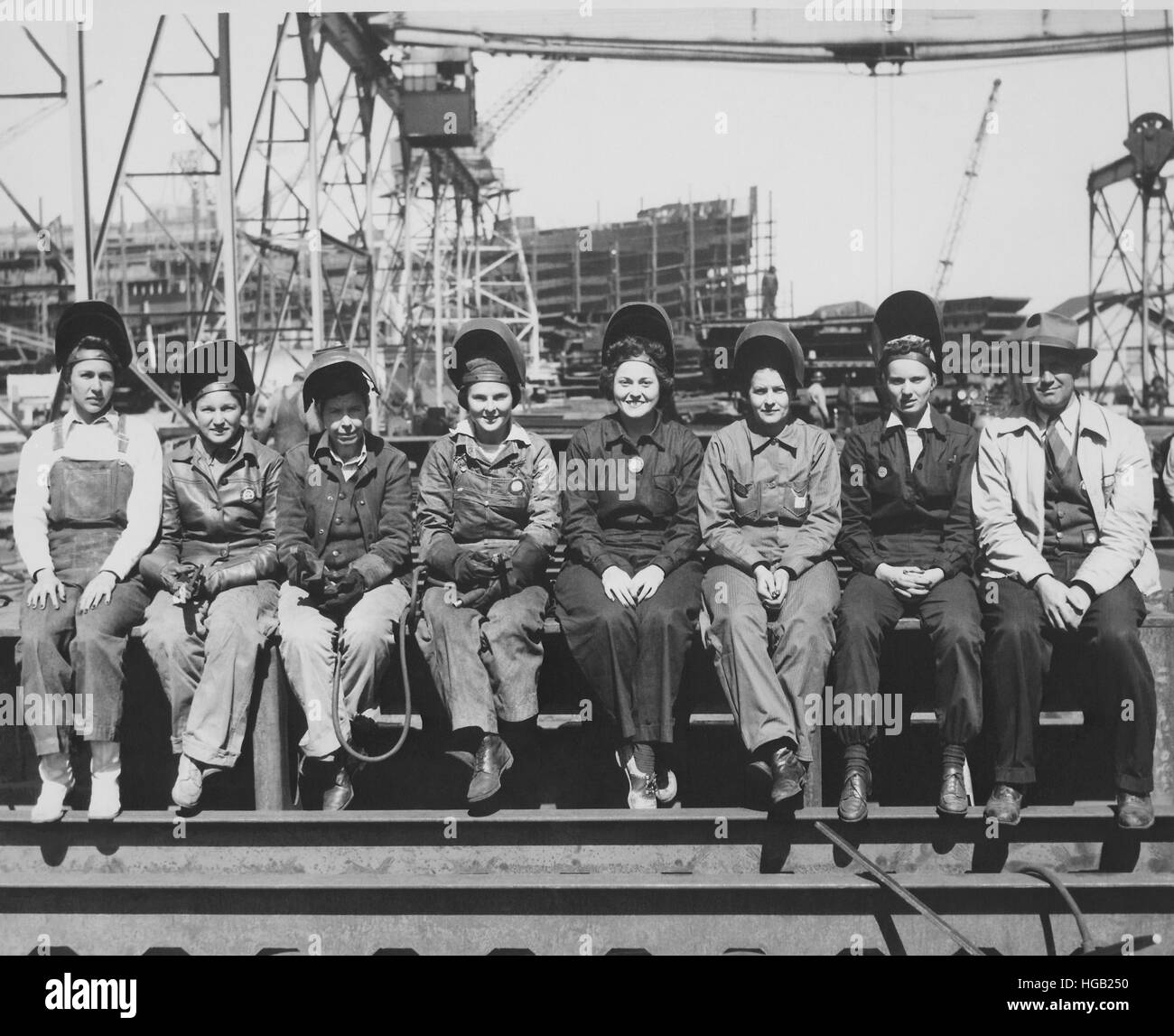 Women welders wearing protective clothing and seated outdoors. Stock Photohttps://www.alamy.com/image-license-details/?v=1https://www.alamy.com/stock-photo-women-welders-wearing-protective-clothing-and-seated-outdoors-130550252.html
Women welders wearing protective clothing and seated outdoors. Stock Photohttps://www.alamy.com/image-license-details/?v=1https://www.alamy.com/stock-photo-women-welders-wearing-protective-clothing-and-seated-outdoors-130550252.htmlRMHGB250–Women welders wearing protective clothing and seated outdoors.
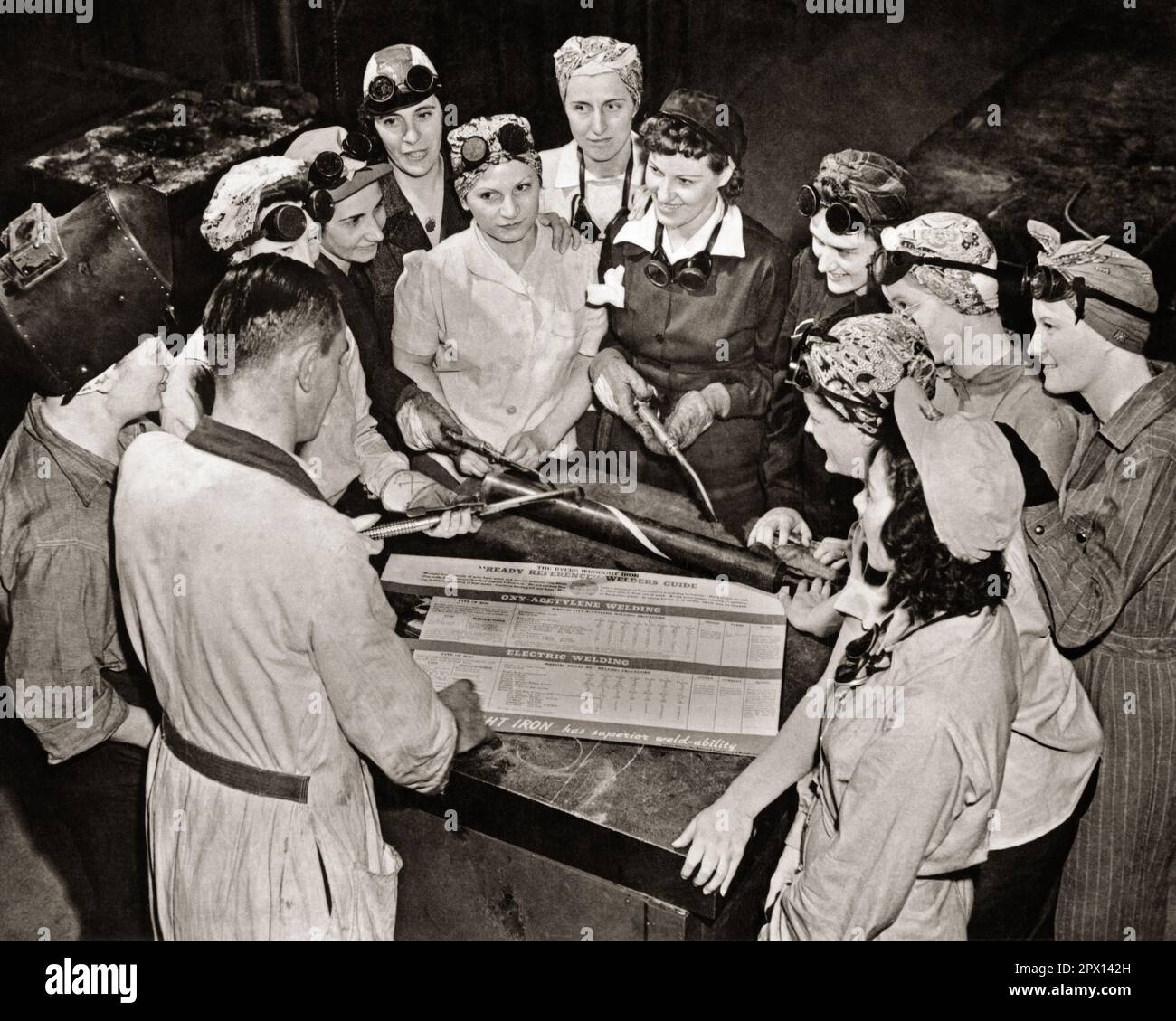 1940s WOMEN IN A WELDING CLASS AT THE BEGINNING OF WORLD WAR 2 HOPING TO SPEED PRODUCTION AND ASSIST IN THE WAR EFFORT - q6154 CPC001 HARS CONFLICT FEMALES WW2 JOBS COPY SPACE HALF-LENGTH LADIES PERSONS GOGGLES MALES CONFIDENCE B&W SKILL OCCUPATION SKILLS HOME FRONT HIGH ANGLE ADVENTURE AND EFFORT EXCITEMENT WORLD WARS LABOR PRIDE WORLD WAR WORLD WAR TWO WORLD WAR II OPPORTUNITY EMPLOYMENT FEMININE OCCUPATIONS WARTIME WELDING HOPING HEAD SCARF FEMINISM WORLD WAR 2 ASSIST EMPLOYEE WELDERS COOPERATION DEFENSE BEGINNING BLACK AND WHITE CAUCASIAN ETHNICITY LABORING OLD FASHIONED WORK CLOTHES Stock Photohttps://www.alamy.com/image-license-details/?v=1https://www.alamy.com/1940s-women-in-a-welding-class-at-the-beginning-of-world-war-2-hoping-to-speed-production-and-assist-in-the-war-effort-q6154-cpc001-hars-conflict-females-ww2-jobs-copy-space-half-length-ladies-persons-goggles-males-confidence-bw-skill-occupation-skills-home-front-high-angle-adventure-and-effort-excitement-world-wars-labor-pride-world-war-world-war-two-world-war-ii-opportunity-employment-feminine-occupations-wartime-welding-hoping-head-scarf-feminism-world-war-2-assist-employee-welders-cooperation-defense-beginning-black-and-white-caucasian-ethnicity-laboring-old-fashioned-work-clothes-image549527625.html
1940s WOMEN IN A WELDING CLASS AT THE BEGINNING OF WORLD WAR 2 HOPING TO SPEED PRODUCTION AND ASSIST IN THE WAR EFFORT - q6154 CPC001 HARS CONFLICT FEMALES WW2 JOBS COPY SPACE HALF-LENGTH LADIES PERSONS GOGGLES MALES CONFIDENCE B&W SKILL OCCUPATION SKILLS HOME FRONT HIGH ANGLE ADVENTURE AND EFFORT EXCITEMENT WORLD WARS LABOR PRIDE WORLD WAR WORLD WAR TWO WORLD WAR II OPPORTUNITY EMPLOYMENT FEMININE OCCUPATIONS WARTIME WELDING HOPING HEAD SCARF FEMINISM WORLD WAR 2 ASSIST EMPLOYEE WELDERS COOPERATION DEFENSE BEGINNING BLACK AND WHITE CAUCASIAN ETHNICITY LABORING OLD FASHIONED WORK CLOTHES Stock Photohttps://www.alamy.com/image-license-details/?v=1https://www.alamy.com/1940s-women-in-a-welding-class-at-the-beginning-of-world-war-2-hoping-to-speed-production-and-assist-in-the-war-effort-q6154-cpc001-hars-conflict-females-ww2-jobs-copy-space-half-length-ladies-persons-goggles-males-confidence-bw-skill-occupation-skills-home-front-high-angle-adventure-and-effort-excitement-world-wars-labor-pride-world-war-world-war-two-world-war-ii-opportunity-employment-feminine-occupations-wartime-welding-hoping-head-scarf-feminism-world-war-2-assist-employee-welders-cooperation-defense-beginning-black-and-white-caucasian-ethnicity-laboring-old-fashioned-work-clothes-image549527625.htmlRM2PX142H–1940s WOMEN IN A WELDING CLASS AT THE BEGINNING OF WORLD WAR 2 HOPING TO SPEED PRODUCTION AND ASSIST IN THE WAR EFFORT - q6154 CPC001 HARS CONFLICT FEMALES WW2 JOBS COPY SPACE HALF-LENGTH LADIES PERSONS GOGGLES MALES CONFIDENCE B&W SKILL OCCUPATION SKILLS HOME FRONT HIGH ANGLE ADVENTURE AND EFFORT EXCITEMENT WORLD WARS LABOR PRIDE WORLD WAR WORLD WAR TWO WORLD WAR II OPPORTUNITY EMPLOYMENT FEMININE OCCUPATIONS WARTIME WELDING HOPING HEAD SCARF FEMINISM WORLD WAR 2 ASSIST EMPLOYEE WELDERS COOPERATION DEFENSE BEGINNING BLACK AND WHITE CAUCASIAN ETHNICITY LABORING OLD FASHIONED WORK CLOTHES
 Vintage photographs of women welding parts of depth charge weapons in the Second World War, part of the important contribution of women to the war efforts. Female welders 1944-1945. Stock Photohttps://www.alamy.com/image-license-details/?v=1https://www.alamy.com/vintage-photographs-of-women-welding-parts-of-depth-charge-weapons-in-the-second-world-war-part-of-the-important-contribution-of-women-to-the-war-efforts-female-welders-1944-1945-image598254724.html
Vintage photographs of women welding parts of depth charge weapons in the Second World War, part of the important contribution of women to the war efforts. Female welders 1944-1945. Stock Photohttps://www.alamy.com/image-license-details/?v=1https://www.alamy.com/vintage-photographs-of-women-welding-parts-of-depth-charge-weapons-in-the-second-world-war-part-of-the-important-contribution-of-women-to-the-war-efforts-female-welders-1944-1945-image598254724.htmlRM2WN8T04–Vintage photographs of women welding parts of depth charge weapons in the Second World War, part of the important contribution of women to the war efforts. Female welders 1944-1945.
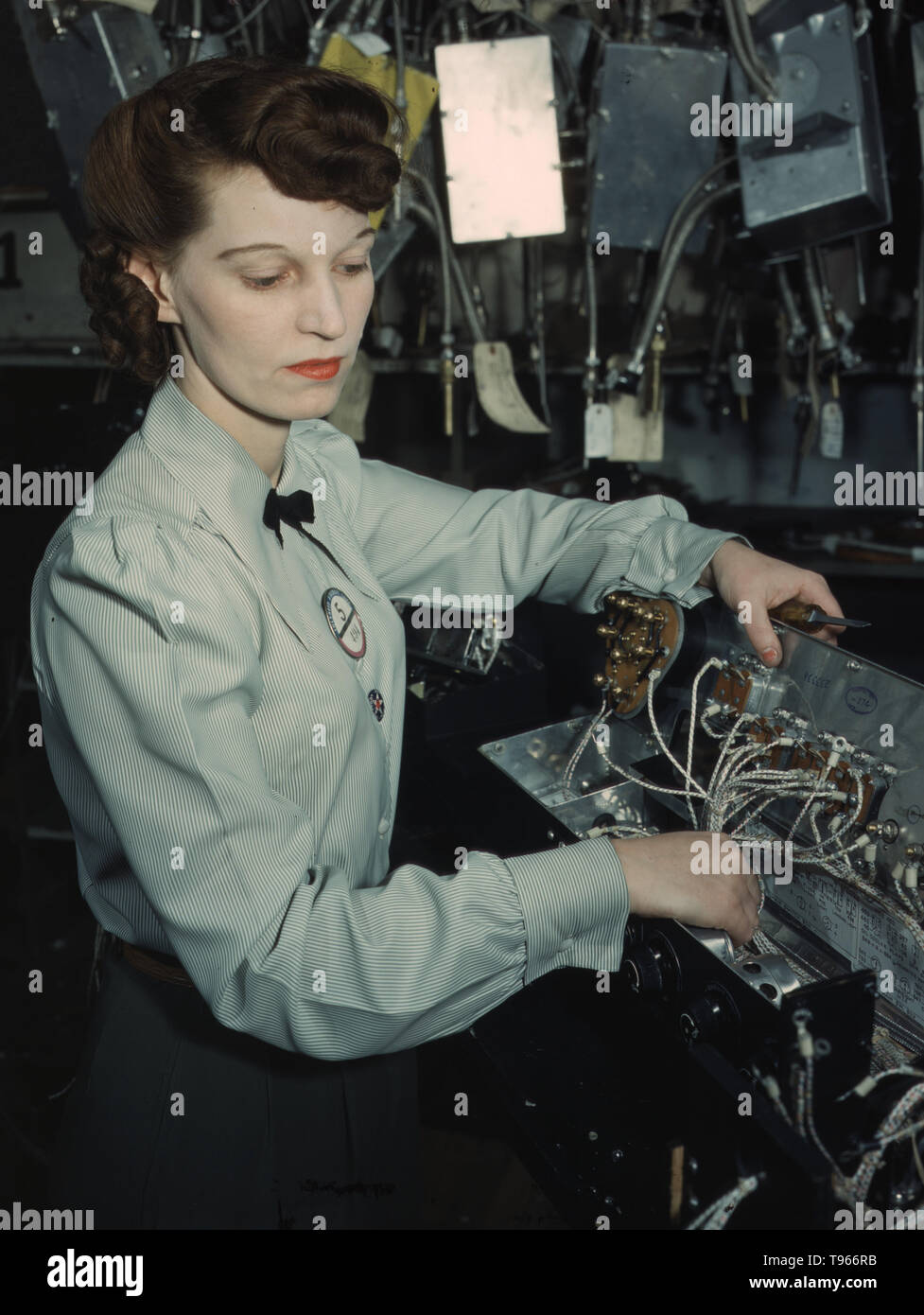 Electronics technician, Goodyear Aircraft Corp., Akron, Ohio. Although the image of 'Rosie the Riveter' reflected the industrial work of welders and riveters, the majority of working women filled non-factory positions in every sector of the economy. What unified the experiences of these women was that they proved to themselves, and the country, that they could do a man's job and could do it well. Photographed by Alfred T. Palmer, 1941. Stock Photohttps://www.alamy.com/image-license-details/?v=1https://www.alamy.com/electronics-technician-goodyear-aircraft-corp-akron-ohio-although-the-image-of-rosie-the-riveter-reflected-the-industrial-work-of-welders-and-riveters-the-majority-of-working-women-filled-non-factory-positions-in-every-sector-of-the-economy-what-unified-the-experiences-of-these-women-was-that-they-proved-to-themselves-and-the-country-that-they-could-do-a-mans-job-and-could-do-it-well-photographed-by-alfred-t-palmer-1941-image246614127.html
Electronics technician, Goodyear Aircraft Corp., Akron, Ohio. Although the image of 'Rosie the Riveter' reflected the industrial work of welders and riveters, the majority of working women filled non-factory positions in every sector of the economy. What unified the experiences of these women was that they proved to themselves, and the country, that they could do a man's job and could do it well. Photographed by Alfred T. Palmer, 1941. Stock Photohttps://www.alamy.com/image-license-details/?v=1https://www.alamy.com/electronics-technician-goodyear-aircraft-corp-akron-ohio-although-the-image-of-rosie-the-riveter-reflected-the-industrial-work-of-welders-and-riveters-the-majority-of-working-women-filled-non-factory-positions-in-every-sector-of-the-economy-what-unified-the-experiences-of-these-women-was-that-they-proved-to-themselves-and-the-country-that-they-could-do-a-mans-job-and-could-do-it-well-photographed-by-alfred-t-palmer-1941-image246614127.htmlRMT966RB–Electronics technician, Goodyear Aircraft Corp., Akron, Ohio. Although the image of 'Rosie the Riveter' reflected the industrial work of welders and riveters, the majority of working women filled non-factory positions in every sector of the economy. What unified the experiences of these women was that they proved to themselves, and the country, that they could do a man's job and could do it well. Photographed by Alfred T. Palmer, 1941.
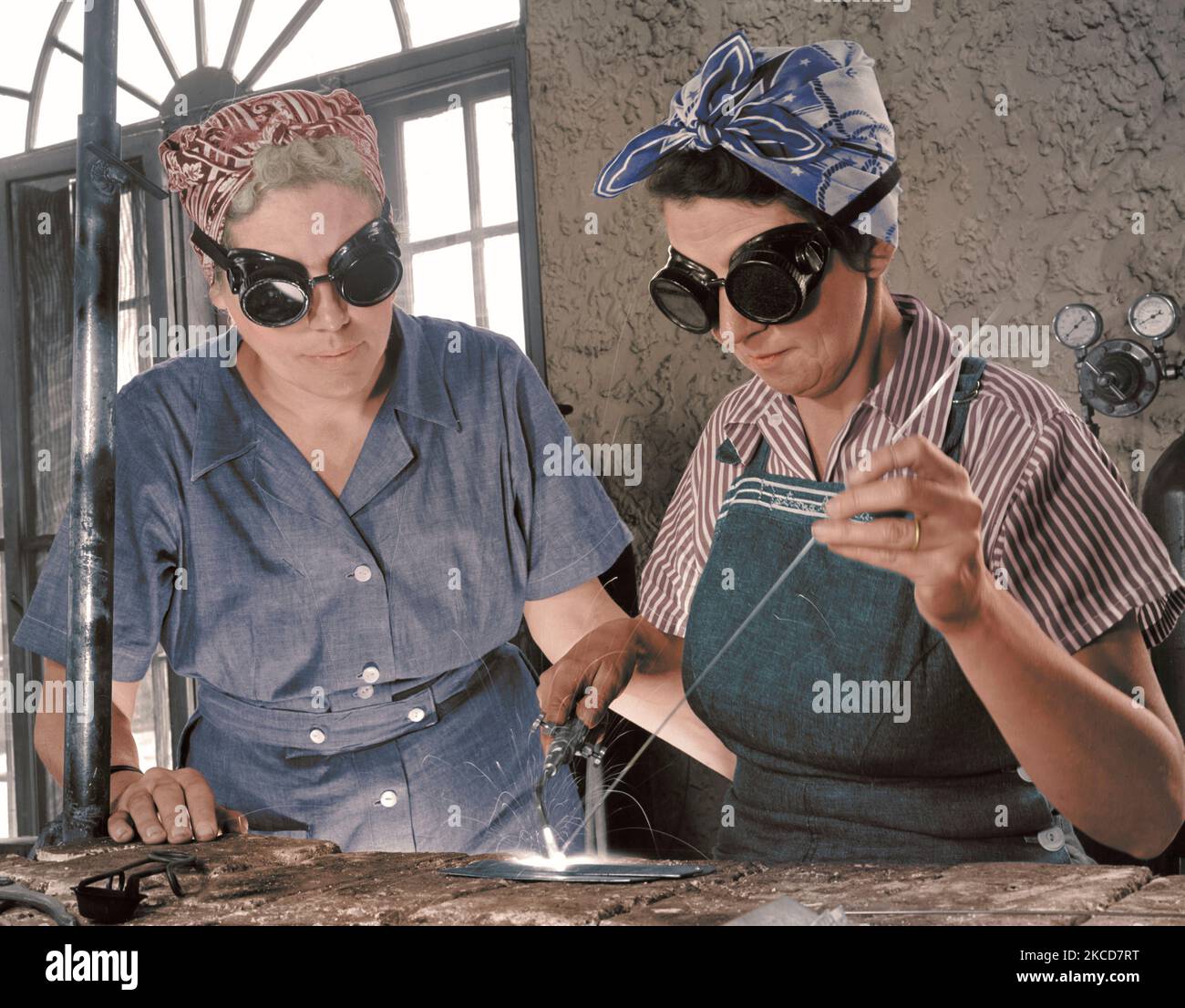 Women welders in World War II, circa 1940's. Stock Photohttps://www.alamy.com/image-license-details/?v=1https://www.alamy.com/women-welders-in-world-war-ii-circa-1940s-image489557708.html
Women welders in World War II, circa 1940's. Stock Photohttps://www.alamy.com/image-license-details/?v=1https://www.alamy.com/women-welders-in-world-war-ii-circa-1940s-image489557708.htmlRF2KCD7RT–Women welders in World War II, circa 1940's.
 Women Welders at the Inglewood, California, plant of North American Aviation. During World War 2 the plant produced B-25 Stock Photohttps://www.alamy.com/image-license-details/?v=1https://www.alamy.com/women-welders-at-the-inglewood-california-plant-of-north-american-image69738833.html
Women Welders at the Inglewood, California, plant of North American Aviation. During World War 2 the plant produced B-25 Stock Photohttps://www.alamy.com/image-license-details/?v=1https://www.alamy.com/women-welders-at-the-inglewood-california-plant-of-north-american-image69738833.htmlRME1CTGH–Women Welders at the Inglewood, California, plant of North American Aviation. During World War 2 the plant produced B-25
 New Britain, Connecticut. Women welders at the Landers, Frary, and Clark plant. Stock Photohttps://www.alamy.com/image-license-details/?v=1https://www.alamy.com/new-britain-connecticut-women-welders-at-the-landers-frary-and-clark-plant-image469814131.html
New Britain, Connecticut. Women welders at the Landers, Frary, and Clark plant. Stock Photohttps://www.alamy.com/image-license-details/?v=1https://www.alamy.com/new-britain-connecticut-women-welders-at-the-landers-frary-and-clark-plant-image469814131.htmlRM2J89TM3–New Britain, Connecticut. Women welders at the Landers, Frary, and Clark plant.
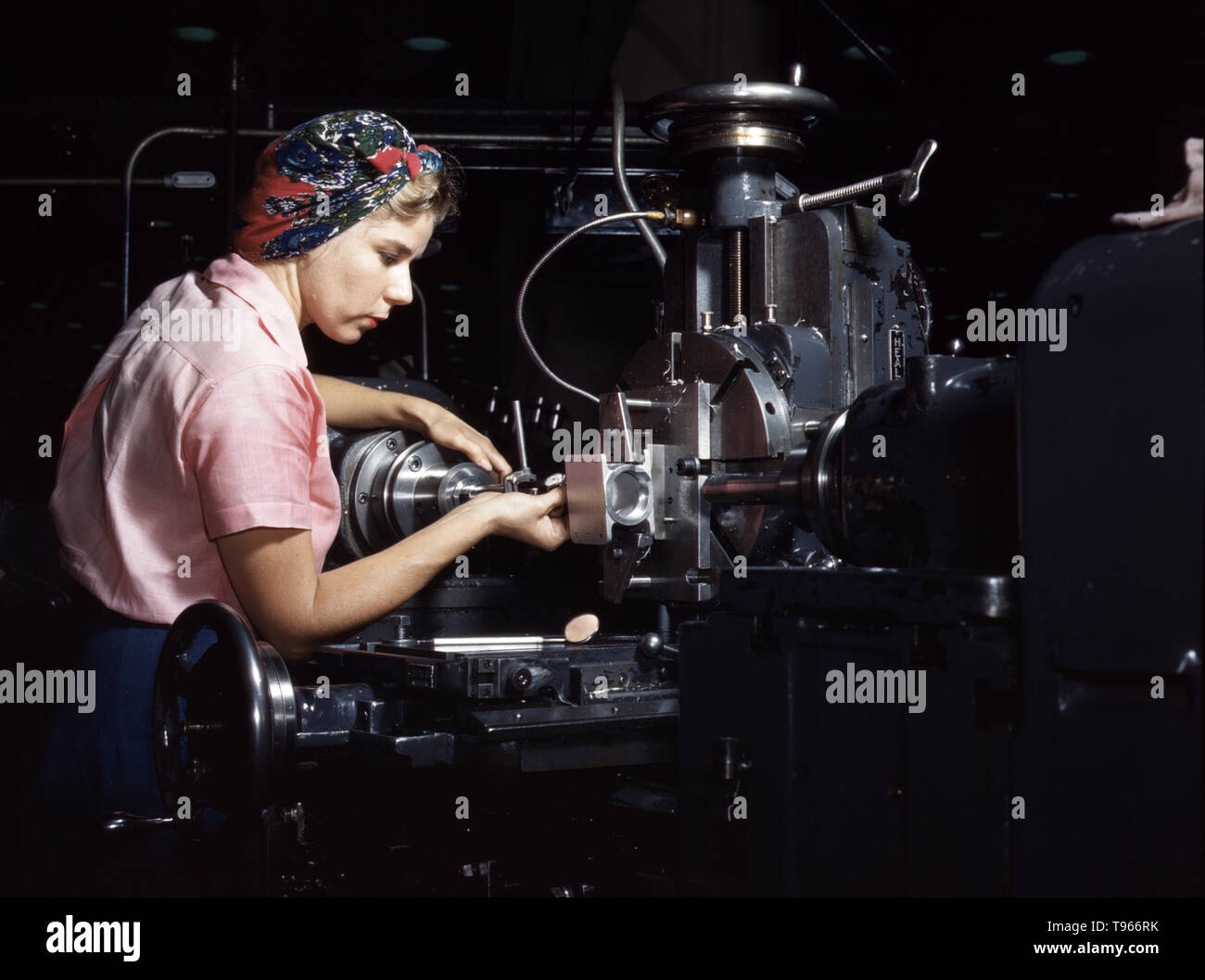 Woman machinist, Douglas Aircraft Company, Long Beach, California. Although the image of 'Rosie the Riveter' reflected the industrial work of welders and riveters, the majority of working women filled non-factory positions in every sector of the economy. What unified the experiences of these women was that they proved to themselves, and the country, that they could do a man's job and could do it well. Photographed by Alfred T. Palmer, 1942. Stock Photohttps://www.alamy.com/image-license-details/?v=1https://www.alamy.com/woman-machinist-douglas-aircraft-company-long-beach-california-although-the-image-of-rosie-the-riveter-reflected-the-industrial-work-of-welders-and-riveters-the-majority-of-working-women-filled-non-factory-positions-in-every-sector-of-the-economy-what-unified-the-experiences-of-these-women-was-that-they-proved-to-themselves-and-the-country-that-they-could-do-a-mans-job-and-could-do-it-well-photographed-by-alfred-t-palmer-1942-image246614135.html
Woman machinist, Douglas Aircraft Company, Long Beach, California. Although the image of 'Rosie the Riveter' reflected the industrial work of welders and riveters, the majority of working women filled non-factory positions in every sector of the economy. What unified the experiences of these women was that they proved to themselves, and the country, that they could do a man's job and could do it well. Photographed by Alfred T. Palmer, 1942. Stock Photohttps://www.alamy.com/image-license-details/?v=1https://www.alamy.com/woman-machinist-douglas-aircraft-company-long-beach-california-although-the-image-of-rosie-the-riveter-reflected-the-industrial-work-of-welders-and-riveters-the-majority-of-working-women-filled-non-factory-positions-in-every-sector-of-the-economy-what-unified-the-experiences-of-these-women-was-that-they-proved-to-themselves-and-the-country-that-they-could-do-a-mans-job-and-could-do-it-well-photographed-by-alfred-t-palmer-1942-image246614135.htmlRMT966RK–Woman machinist, Douglas Aircraft Company, Long Beach, California. Although the image of 'Rosie the Riveter' reflected the industrial work of welders and riveters, the majority of working women filled non-factory positions in every sector of the economy. What unified the experiences of these women was that they proved to themselves, and the country, that they could do a man's job and could do it well. Photographed by Alfred T. Palmer, 1942.
 African American woman welders working on the Liberty Ship, SS George Washington Carver. Kaiser shipyards, Richmond, Stock Photohttps://www.alamy.com/image-license-details/?v=1https://www.alamy.com/african-american-woman-welders-working-on-the-liberty-ship-ss-george-image69738871.html
African American woman welders working on the Liberty Ship, SS George Washington Carver. Kaiser shipyards, Richmond, Stock Photohttps://www.alamy.com/image-license-details/?v=1https://www.alamy.com/african-american-woman-welders-working-on-the-liberty-ship-ss-george-image69738871.htmlRME1CTHY–African American woman welders working on the Liberty Ship, SS George Washington Carver. Kaiser shipyards, Richmond,
 Woman aircraft worker, Vega Aircraft Corporation, Burbank, California. Shown checking electrical assemblies. Although the image of 'Rosie the Riveter' reflected the industrial work of welders and riveters, the majority of working women filled non-factory positions in every sector of the economy. What unified the experiences of these women was that they proved to themselves, and the country, that they could do a man's job and could do it well. Photographed by David Bransby. Stock Photohttps://www.alamy.com/image-license-details/?v=1https://www.alamy.com/woman-aircraft-worker-vega-aircraft-corporation-burbank-california-shown-checking-electrical-assemblies-although-the-image-of-rosie-the-riveter-reflected-the-industrial-work-of-welders-and-riveters-the-majority-of-working-women-filled-non-factory-positions-in-every-sector-of-the-economy-what-unified-the-experiences-of-these-women-was-that-they-proved-to-themselves-and-the-country-that-they-could-do-a-mans-job-and-could-do-it-well-photographed-by-david-bransby-image246614131.html
Woman aircraft worker, Vega Aircraft Corporation, Burbank, California. Shown checking electrical assemblies. Although the image of 'Rosie the Riveter' reflected the industrial work of welders and riveters, the majority of working women filled non-factory positions in every sector of the economy. What unified the experiences of these women was that they proved to themselves, and the country, that they could do a man's job and could do it well. Photographed by David Bransby. Stock Photohttps://www.alamy.com/image-license-details/?v=1https://www.alamy.com/woman-aircraft-worker-vega-aircraft-corporation-burbank-california-shown-checking-electrical-assemblies-although-the-image-of-rosie-the-riveter-reflected-the-industrial-work-of-welders-and-riveters-the-majority-of-working-women-filled-non-factory-positions-in-every-sector-of-the-economy-what-unified-the-experiences-of-these-women-was-that-they-proved-to-themselves-and-the-country-that-they-could-do-a-mans-job-and-could-do-it-well-photographed-by-david-bransby-image246614131.htmlRMT966RF–Woman aircraft worker, Vega Aircraft Corporation, Burbank, California. Shown checking electrical assemblies. Although the image of 'Rosie the Riveter' reflected the industrial work of welders and riveters, the majority of working women filled non-factory positions in every sector of the economy. What unified the experiences of these women was that they proved to themselves, and the country, that they could do a man's job and could do it well. Photographed by David Bransby.
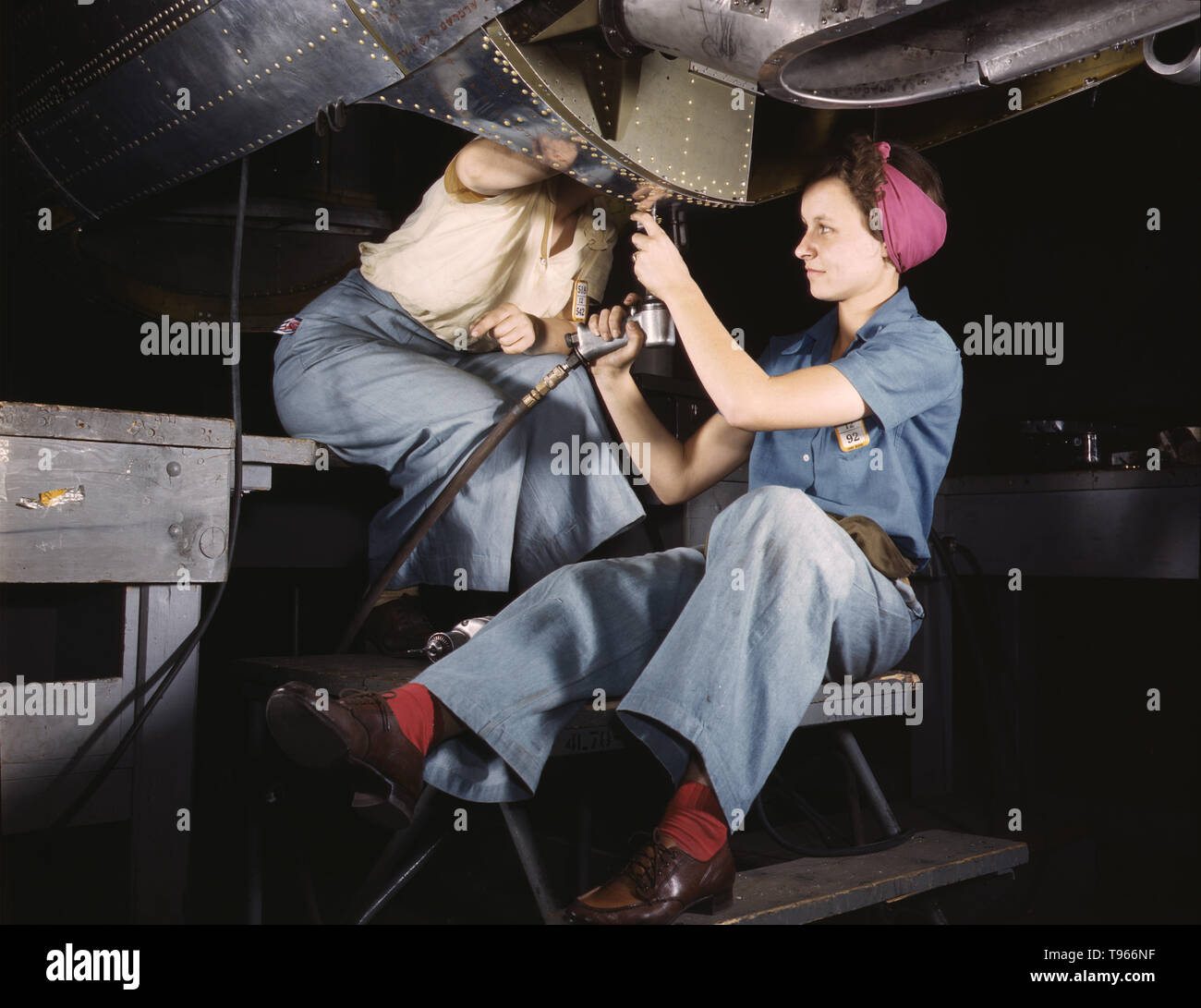 Women at work on bomber, Douglas Aircraft Company, Long Beach, California. Although the image of 'Rosie the Riveter' reflected the industrial work of welders and riveters, the majority of working women filled non-factory positions in every sector of the economy. What unified the experiences of these women was that they proved to themselves, and the country, that they could do a man's job and could do it well. Photographed by Alfred T. Palmer, 1942. Stock Photohttps://www.alamy.com/image-license-details/?v=1https://www.alamy.com/women-at-work-on-bomber-douglas-aircraft-company-long-beach-california-although-the-image-of-rosie-the-riveter-reflected-the-industrial-work-of-welders-and-riveters-the-majority-of-working-women-filled-non-factory-positions-in-every-sector-of-the-economy-what-unified-the-experiences-of-these-women-was-that-they-proved-to-themselves-and-the-country-that-they-could-do-a-mans-job-and-could-do-it-well-photographed-by-alfred-t-palmer-1942-image246614075.html
Women at work on bomber, Douglas Aircraft Company, Long Beach, California. Although the image of 'Rosie the Riveter' reflected the industrial work of welders and riveters, the majority of working women filled non-factory positions in every sector of the economy. What unified the experiences of these women was that they proved to themselves, and the country, that they could do a man's job and could do it well. Photographed by Alfred T. Palmer, 1942. Stock Photohttps://www.alamy.com/image-license-details/?v=1https://www.alamy.com/women-at-work-on-bomber-douglas-aircraft-company-long-beach-california-although-the-image-of-rosie-the-riveter-reflected-the-industrial-work-of-welders-and-riveters-the-majority-of-working-women-filled-non-factory-positions-in-every-sector-of-the-economy-what-unified-the-experiences-of-these-women-was-that-they-proved-to-themselves-and-the-country-that-they-could-do-a-mans-job-and-could-do-it-well-photographed-by-alfred-t-palmer-1942-image246614075.htmlRMT966NF–Women at work on bomber, Douglas Aircraft Company, Long Beach, California. Although the image of 'Rosie the Riveter' reflected the industrial work of welders and riveters, the majority of working women filled non-factory positions in every sector of the economy. What unified the experiences of these women was that they proved to themselves, and the country, that they could do a man's job and could do it well. Photographed by Alfred T. Palmer, 1942.
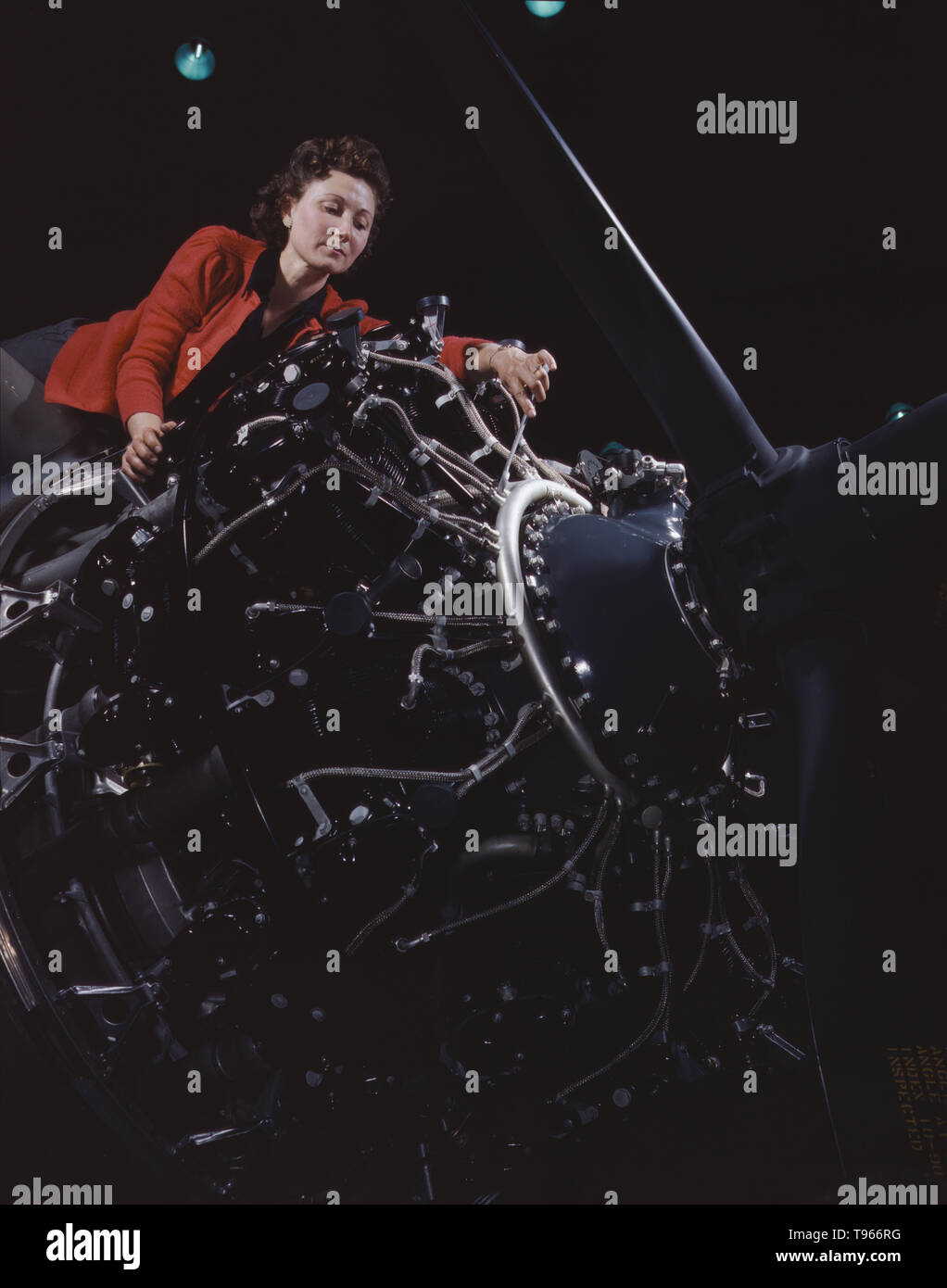 Woman at work on motor, Douglas Aircraft Company, Long Beach, California. Although the image of 'Rosie the Riveter' reflected the industrial work of welders and riveters, the majority of working women filled non-factory positions in every sector of the economy. What unified the experiences of these women was that they proved to themselves, and the country, that they could do a man's job and could do it well. Photographed by Alfred T. Palmer, 1942. Stock Photohttps://www.alamy.com/image-license-details/?v=1https://www.alamy.com/woman-at-work-on-motor-douglas-aircraft-company-long-beach-california-although-the-image-of-rosie-the-riveter-reflected-the-industrial-work-of-welders-and-riveters-the-majority-of-working-women-filled-non-factory-positions-in-every-sector-of-the-economy-what-unified-the-experiences-of-these-women-was-that-they-proved-to-themselves-and-the-country-that-they-could-do-a-mans-job-and-could-do-it-well-photographed-by-alfred-t-palmer-1942-image246614132.html
Woman at work on motor, Douglas Aircraft Company, Long Beach, California. Although the image of 'Rosie the Riveter' reflected the industrial work of welders and riveters, the majority of working women filled non-factory positions in every sector of the economy. What unified the experiences of these women was that they proved to themselves, and the country, that they could do a man's job and could do it well. Photographed by Alfred T. Palmer, 1942. Stock Photohttps://www.alamy.com/image-license-details/?v=1https://www.alamy.com/woman-at-work-on-motor-douglas-aircraft-company-long-beach-california-although-the-image-of-rosie-the-riveter-reflected-the-industrial-work-of-welders-and-riveters-the-majority-of-working-women-filled-non-factory-positions-in-every-sector-of-the-economy-what-unified-the-experiences-of-these-women-was-that-they-proved-to-themselves-and-the-country-that-they-could-do-a-mans-job-and-could-do-it-well-photographed-by-alfred-t-palmer-1942-image246614132.htmlRMT966RG–Woman at work on motor, Douglas Aircraft Company, Long Beach, California. Although the image of 'Rosie the Riveter' reflected the industrial work of welders and riveters, the majority of working women filled non-factory positions in every sector of the economy. What unified the experiences of these women was that they proved to themselves, and the country, that they could do a man's job and could do it well. Photographed by Alfred T. Palmer, 1942.
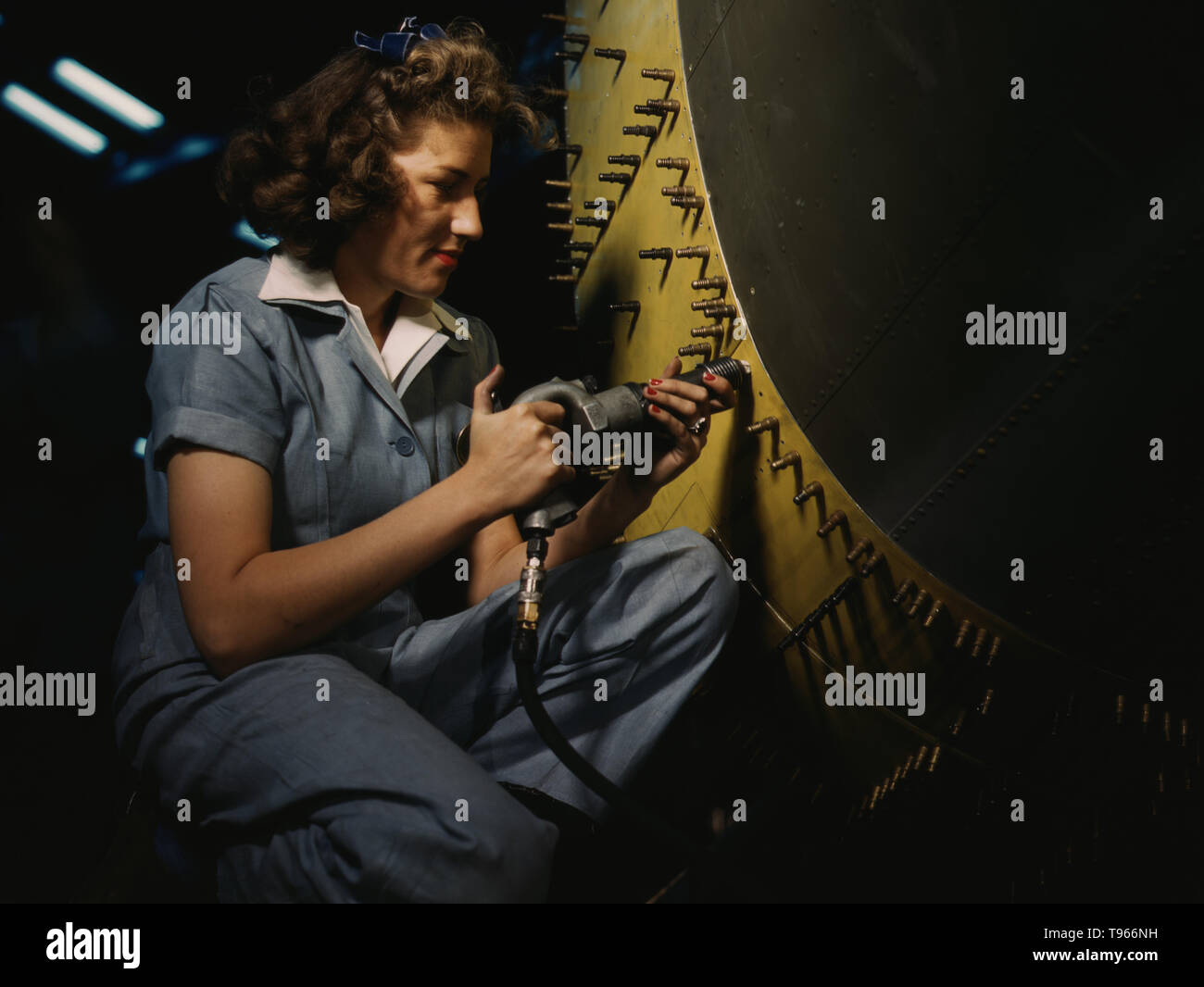 Riveter at work on Consolidated bomber, Consolidated Aircraft Corp., Fort Worth, Texas. Although the image of 'Rosie the Riveter' reflected the industrial work of welders and riveters, the majority of working women filled non-factory positions in every sector of the economy. What unified the experiences of these women was that they proved to themselves, and the country, that they could do a man's job and could do it well. Photographed by Howard R. Hollem, 1942. Stock Photohttps://www.alamy.com/image-license-details/?v=1https://www.alamy.com/riveter-at-work-on-consolidated-bomber-consolidated-aircraft-corp-fort-worth-texas-although-the-image-of-rosie-the-riveter-reflected-the-industrial-work-of-welders-and-riveters-the-majority-of-working-women-filled-non-factory-positions-in-every-sector-of-the-economy-what-unified-the-experiences-of-these-women-was-that-they-proved-to-themselves-and-the-country-that-they-could-do-a-mans-job-and-could-do-it-well-photographed-by-howard-r-hollem-1942-image246614077.html
Riveter at work on Consolidated bomber, Consolidated Aircraft Corp., Fort Worth, Texas. Although the image of 'Rosie the Riveter' reflected the industrial work of welders and riveters, the majority of working women filled non-factory positions in every sector of the economy. What unified the experiences of these women was that they proved to themselves, and the country, that they could do a man's job and could do it well. Photographed by Howard R. Hollem, 1942. Stock Photohttps://www.alamy.com/image-license-details/?v=1https://www.alamy.com/riveter-at-work-on-consolidated-bomber-consolidated-aircraft-corp-fort-worth-texas-although-the-image-of-rosie-the-riveter-reflected-the-industrial-work-of-welders-and-riveters-the-majority-of-working-women-filled-non-factory-positions-in-every-sector-of-the-economy-what-unified-the-experiences-of-these-women-was-that-they-proved-to-themselves-and-the-country-that-they-could-do-a-mans-job-and-could-do-it-well-photographed-by-howard-r-hollem-1942-image246614077.htmlRMT966NH–Riveter at work on Consolidated bomber, Consolidated Aircraft Corp., Fort Worth, Texas. Although the image of 'Rosie the Riveter' reflected the industrial work of welders and riveters, the majority of working women filled non-factory positions in every sector of the economy. What unified the experiences of these women was that they proved to themselves, and the country, that they could do a man's job and could do it well. Photographed by Howard R. Hollem, 1942.
 Woman working on an airplane motor at North American Aviation, Inc., plant in California. Although the image of 'Rosie the Riveter' reflected the industrial work of welders and riveters, the majority of working women filled non-factory positions in every sector of the economy. What unified the experiences of these women was that they proved to themselves, and the country, that they could do a man's job and could do it well. Photographed by Alfred T. Palmer, 1942. Stock Photohttps://www.alamy.com/image-license-details/?v=1https://www.alamy.com/woman-working-on-an-airplane-motor-at-north-american-aviation-inc-plant-in-california-although-the-image-of-rosie-the-riveter-reflected-the-industrial-work-of-welders-and-riveters-the-majority-of-working-women-filled-non-factory-positions-in-every-sector-of-the-economy-what-unified-the-experiences-of-these-women-was-that-they-proved-to-themselves-and-the-country-that-they-could-do-a-mans-job-and-could-do-it-well-photographed-by-alfred-t-palmer-1942-image246614128.html
Woman working on an airplane motor at North American Aviation, Inc., plant in California. Although the image of 'Rosie the Riveter' reflected the industrial work of welders and riveters, the majority of working women filled non-factory positions in every sector of the economy. What unified the experiences of these women was that they proved to themselves, and the country, that they could do a man's job and could do it well. Photographed by Alfred T. Palmer, 1942. Stock Photohttps://www.alamy.com/image-license-details/?v=1https://www.alamy.com/woman-working-on-an-airplane-motor-at-north-american-aviation-inc-plant-in-california-although-the-image-of-rosie-the-riveter-reflected-the-industrial-work-of-welders-and-riveters-the-majority-of-working-women-filled-non-factory-positions-in-every-sector-of-the-economy-what-unified-the-experiences-of-these-women-was-that-they-proved-to-themselves-and-the-country-that-they-could-do-a-mans-job-and-could-do-it-well-photographed-by-alfred-t-palmer-1942-image246614128.htmlRMT966RC–Woman working on an airplane motor at North American Aviation, Inc., plant in California. Although the image of 'Rosie the Riveter' reflected the industrial work of welders and riveters, the majority of working women filled non-factory positions in every sector of the economy. What unified the experiences of these women was that they proved to themselves, and the country, that they could do a man's job and could do it well. Photographed by Alfred T. Palmer, 1942.
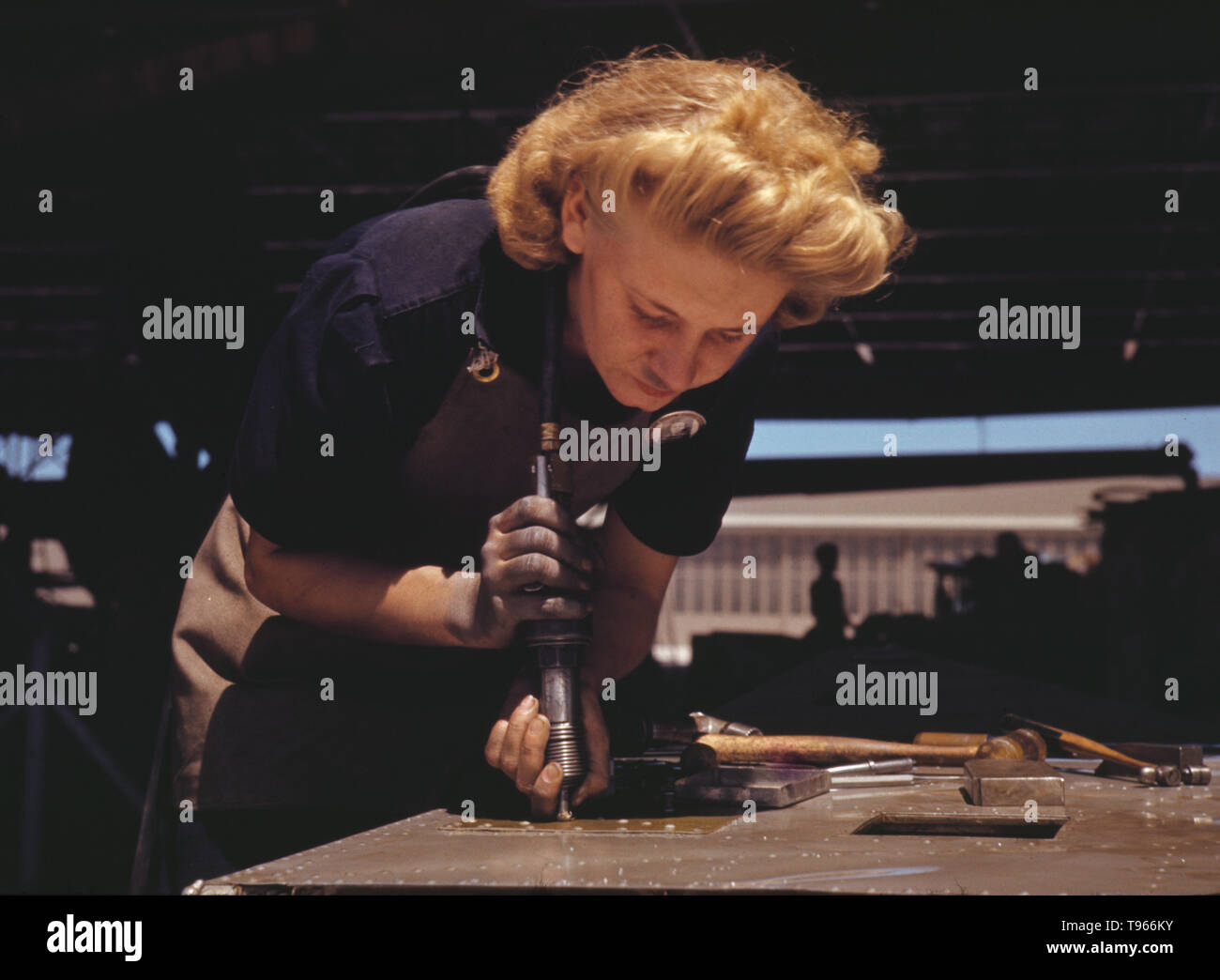 Working in the Assembly and Repair Department of the Naval Air Base, Corpus Christi, Texas. Although the image of 'Rosie the Riveter' reflected the industrial work of welders and riveters, the majority of working women filled non-factory positions in every sector of the economy. What unified the experiences of these women was that they proved to themselves, and the country, that they could do a man's job and could do it well. Photographed by Alfred T. Palmer, 1942. Stock Photohttps://www.alamy.com/image-license-details/?v=1https://www.alamy.com/working-in-the-assembly-and-repair-department-of-the-naval-air-base-corpus-christi-texas-although-the-image-of-rosie-the-riveter-reflected-the-industrial-work-of-welders-and-riveters-the-majority-of-working-women-filled-non-factory-positions-in-every-sector-of-the-economy-what-unified-the-experiences-of-these-women-was-that-they-proved-to-themselves-and-the-country-that-they-could-do-a-mans-job-and-could-do-it-well-photographed-by-alfred-t-palmer-1942-image246614031.html
Working in the Assembly and Repair Department of the Naval Air Base, Corpus Christi, Texas. Although the image of 'Rosie the Riveter' reflected the industrial work of welders and riveters, the majority of working women filled non-factory positions in every sector of the economy. What unified the experiences of these women was that they proved to themselves, and the country, that they could do a man's job and could do it well. Photographed by Alfred T. Palmer, 1942. Stock Photohttps://www.alamy.com/image-license-details/?v=1https://www.alamy.com/working-in-the-assembly-and-repair-department-of-the-naval-air-base-corpus-christi-texas-although-the-image-of-rosie-the-riveter-reflected-the-industrial-work-of-welders-and-riveters-the-majority-of-working-women-filled-non-factory-positions-in-every-sector-of-the-economy-what-unified-the-experiences-of-these-women-was-that-they-proved-to-themselves-and-the-country-that-they-could-do-a-mans-job-and-could-do-it-well-photographed-by-alfred-t-palmer-1942-image246614031.htmlRMT966KY–Working in the Assembly and Repair Department of the Naval Air Base, Corpus Christi, Texas. Although the image of 'Rosie the Riveter' reflected the industrial work of welders and riveters, the majority of working women filled non-factory positions in every sector of the economy. What unified the experiences of these women was that they proved to themselves, and the country, that they could do a man's job and could do it well. Photographed by Alfred T. Palmer, 1942.
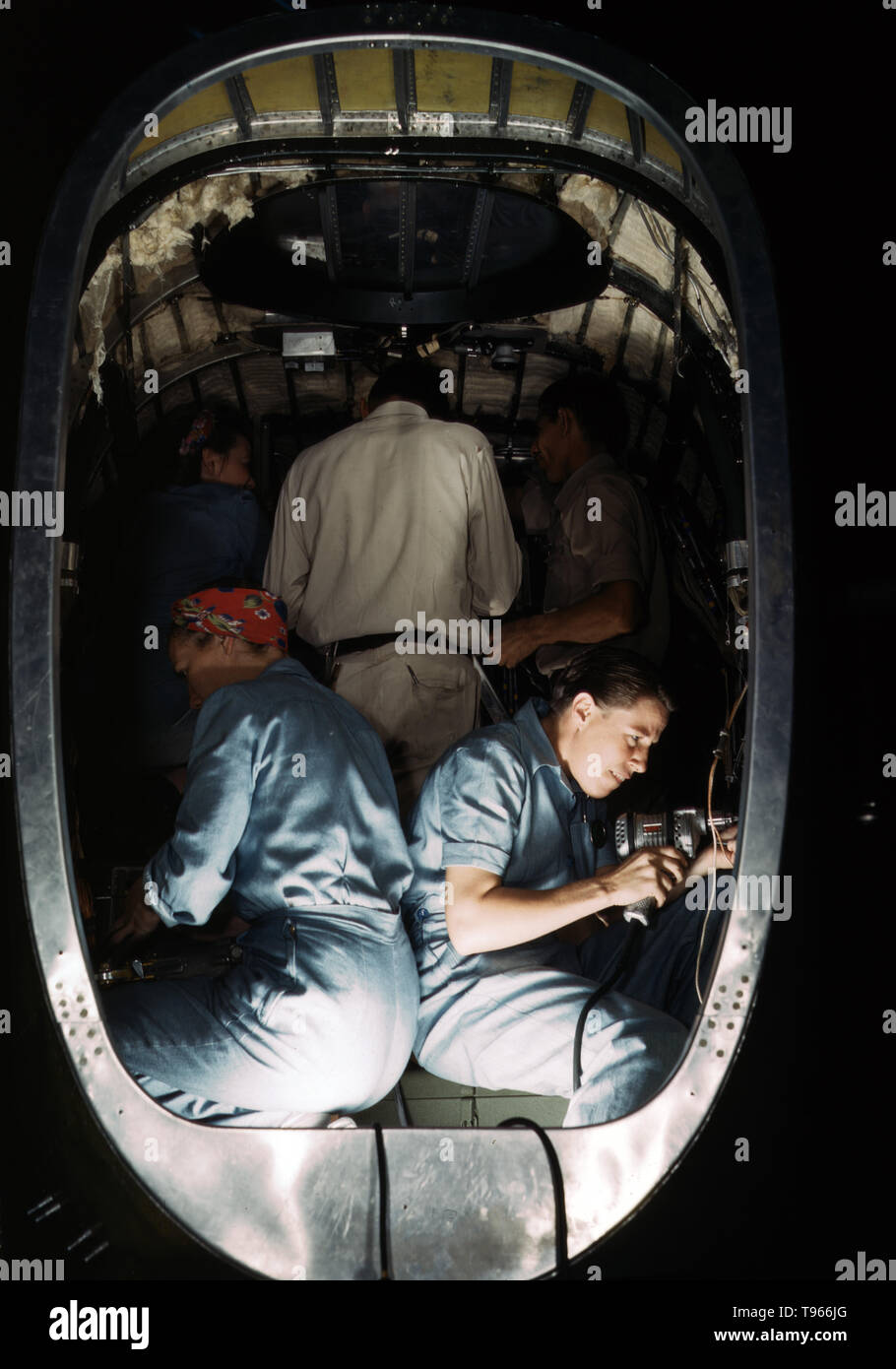 Working inside fuselage of a Liberator Bomber, Consolidated Aircraft Corp., Fort Worth, Texas. Although the image of 'Rosie the Riveter' reflected the industrial work of welders and riveters, the majority of working women filled non-factory positions in every sector of the economy. What unified the experiences of these women was that they proved to themselves, and the country, that they could do a man's job and could do it well. Photographed by Howard R. Hollem, 1942. Stock Photohttps://www.alamy.com/image-license-details/?v=1https://www.alamy.com/working-inside-fuselage-of-a-liberator-bomber-consolidated-aircraft-corp-fort-worth-texas-although-the-image-of-rosie-the-riveter-reflected-the-industrial-work-of-welders-and-riveters-the-majority-of-working-women-filled-non-factory-positions-in-every-sector-of-the-economy-what-unified-the-experiences-of-these-women-was-that-they-proved-to-themselves-and-the-country-that-they-could-do-a-mans-job-and-could-do-it-well-photographed-by-howard-r-hollem-1942-image246613992.html
Working inside fuselage of a Liberator Bomber, Consolidated Aircraft Corp., Fort Worth, Texas. Although the image of 'Rosie the Riveter' reflected the industrial work of welders and riveters, the majority of working women filled non-factory positions in every sector of the economy. What unified the experiences of these women was that they proved to themselves, and the country, that they could do a man's job and could do it well. Photographed by Howard R. Hollem, 1942. Stock Photohttps://www.alamy.com/image-license-details/?v=1https://www.alamy.com/working-inside-fuselage-of-a-liberator-bomber-consolidated-aircraft-corp-fort-worth-texas-although-the-image-of-rosie-the-riveter-reflected-the-industrial-work-of-welders-and-riveters-the-majority-of-working-women-filled-non-factory-positions-in-every-sector-of-the-economy-what-unified-the-experiences-of-these-women-was-that-they-proved-to-themselves-and-the-country-that-they-could-do-a-mans-job-and-could-do-it-well-photographed-by-howard-r-hollem-1942-image246613992.htmlRMT966JG–Working inside fuselage of a Liberator Bomber, Consolidated Aircraft Corp., Fort Worth, Texas. Although the image of 'Rosie the Riveter' reflected the industrial work of welders and riveters, the majority of working women filled non-factory positions in every sector of the economy. What unified the experiences of these women was that they proved to themselves, and the country, that they could do a man's job and could do it well. Photographed by Howard R. Hollem, 1942.
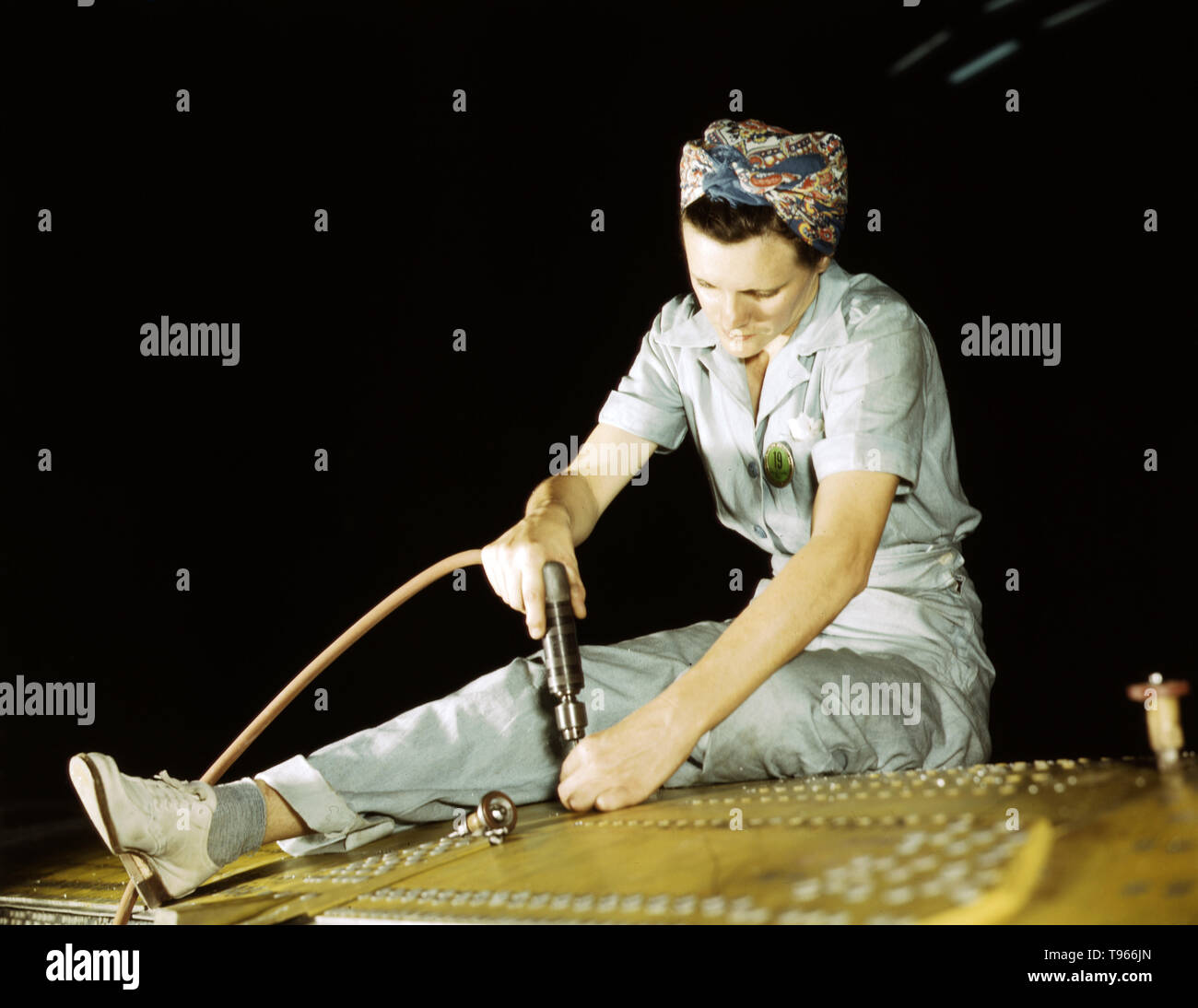 Drilling on a Liberator Bomber, Consolidated Aircraft Corp., Fort Worth, Texas. Although the image of 'Rosie the Riveter' reflected the industrial work of welders and riveters, the majority of working women filled non-factory positions in every sector of the economy. What unified the experiences of these women was that they proved to themselves, and the country, that they could do a man's job and could do it well. Photographed by Howard R. Hollem, 1942. Stock Photohttps://www.alamy.com/image-license-details/?v=1https://www.alamy.com/drilling-on-a-liberator-bomber-consolidated-aircraft-corp-fort-worth-texas-although-the-image-of-rosie-the-riveter-reflected-the-industrial-work-of-welders-and-riveters-the-majority-of-working-women-filled-non-factory-positions-in-every-sector-of-the-economy-what-unified-the-experiences-of-these-women-was-that-they-proved-to-themselves-and-the-country-that-they-could-do-a-mans-job-and-could-do-it-well-photographed-by-howard-r-hollem-1942-image246613997.html
Drilling on a Liberator Bomber, Consolidated Aircraft Corp., Fort Worth, Texas. Although the image of 'Rosie the Riveter' reflected the industrial work of welders and riveters, the majority of working women filled non-factory positions in every sector of the economy. What unified the experiences of these women was that they proved to themselves, and the country, that they could do a man's job and could do it well. Photographed by Howard R. Hollem, 1942. Stock Photohttps://www.alamy.com/image-license-details/?v=1https://www.alamy.com/drilling-on-a-liberator-bomber-consolidated-aircraft-corp-fort-worth-texas-although-the-image-of-rosie-the-riveter-reflected-the-industrial-work-of-welders-and-riveters-the-majority-of-working-women-filled-non-factory-positions-in-every-sector-of-the-economy-what-unified-the-experiences-of-these-women-was-that-they-proved-to-themselves-and-the-country-that-they-could-do-a-mans-job-and-could-do-it-well-photographed-by-howard-r-hollem-1942-image246613997.htmlRMT966JN–Drilling on a Liberator Bomber, Consolidated Aircraft Corp., Fort Worth, Texas. Although the image of 'Rosie the Riveter' reflected the industrial work of welders and riveters, the majority of working women filled non-factory positions in every sector of the economy. What unified the experiences of these women was that they proved to themselves, and the country, that they could do a man's job and could do it well. Photographed by Howard R. Hollem, 1942.
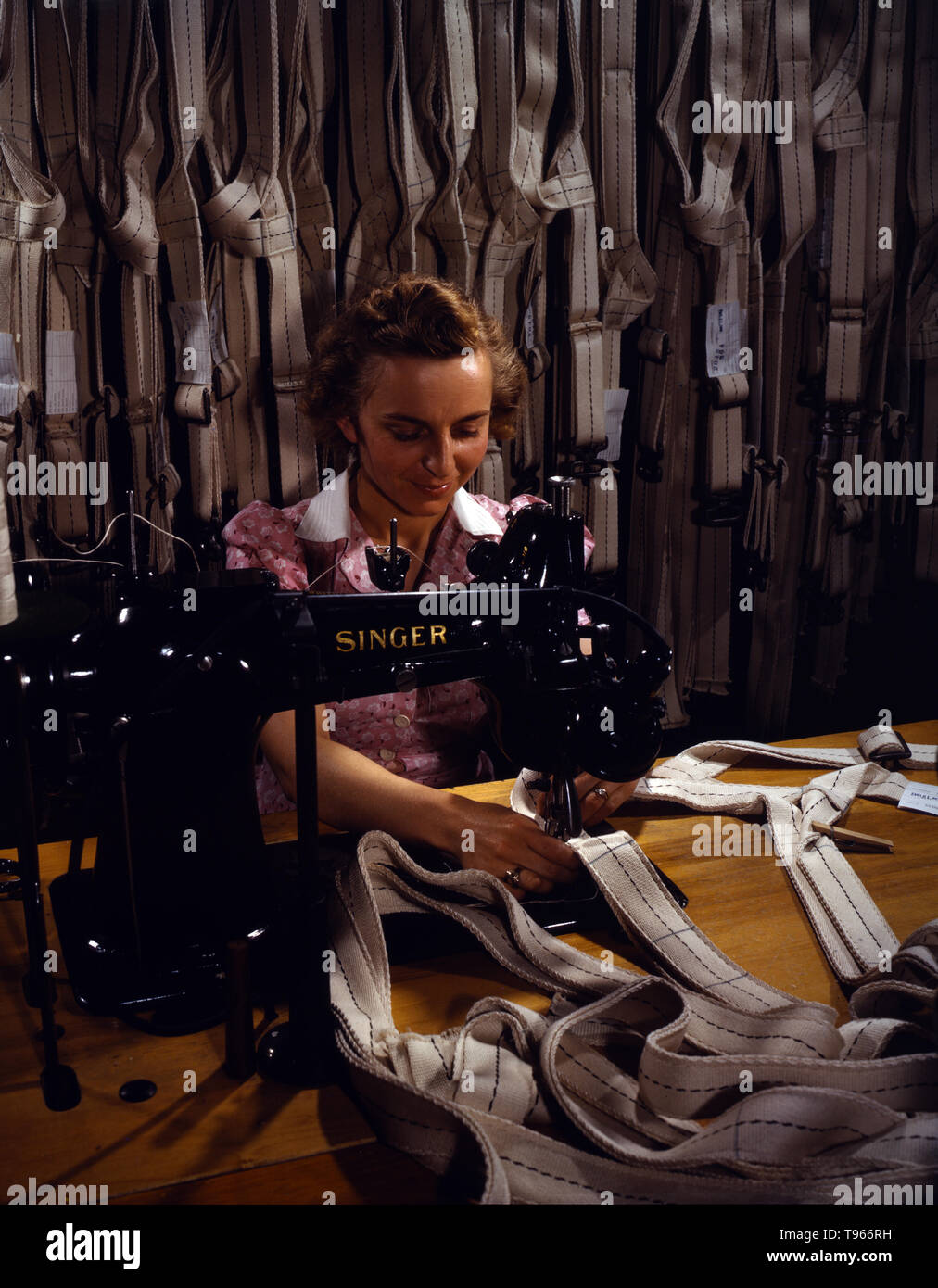 Making harnesses, Mary Saverick stitching, Pioneer Parachute Company Mills, Manchester, Connecticut. Although the image of 'Rosie the Riveter' reflected the industrial work of welders and riveters, the majority of working women filled non-factory positions in every sector of the economy. What unified the experiences of these women was that they proved to themselves, and the country, that they could do a man's job and could do it well. Photographed by William M. Rittase, 1942. Stock Photohttps://www.alamy.com/image-license-details/?v=1https://www.alamy.com/making-harnesses-mary-saverick-stitching-pioneer-parachute-company-mills-manchester-connecticut-although-the-image-of-rosie-the-riveter-reflected-the-industrial-work-of-welders-and-riveters-the-majority-of-working-women-filled-non-factory-positions-in-every-sector-of-the-economy-what-unified-the-experiences-of-these-women-was-that-they-proved-to-themselves-and-the-country-that-they-could-do-a-mans-job-and-could-do-it-well-photographed-by-william-m-rittase-1942-image246614133.html
Making harnesses, Mary Saverick stitching, Pioneer Parachute Company Mills, Manchester, Connecticut. Although the image of 'Rosie the Riveter' reflected the industrial work of welders and riveters, the majority of working women filled non-factory positions in every sector of the economy. What unified the experiences of these women was that they proved to themselves, and the country, that they could do a man's job and could do it well. Photographed by William M. Rittase, 1942. Stock Photohttps://www.alamy.com/image-license-details/?v=1https://www.alamy.com/making-harnesses-mary-saverick-stitching-pioneer-parachute-company-mills-manchester-connecticut-although-the-image-of-rosie-the-riveter-reflected-the-industrial-work-of-welders-and-riveters-the-majority-of-working-women-filled-non-factory-positions-in-every-sector-of-the-economy-what-unified-the-experiences-of-these-women-was-that-they-proved-to-themselves-and-the-country-that-they-could-do-a-mans-job-and-could-do-it-well-photographed-by-william-m-rittase-1942-image246614133.htmlRMT966RH–Making harnesses, Mary Saverick stitching, Pioneer Parachute Company Mills, Manchester, Connecticut. Although the image of 'Rosie the Riveter' reflected the industrial work of welders and riveters, the majority of working women filled non-factory positions in every sector of the economy. What unified the experiences of these women was that they proved to themselves, and the country, that they could do a man's job and could do it well. Photographed by William M. Rittase, 1942.
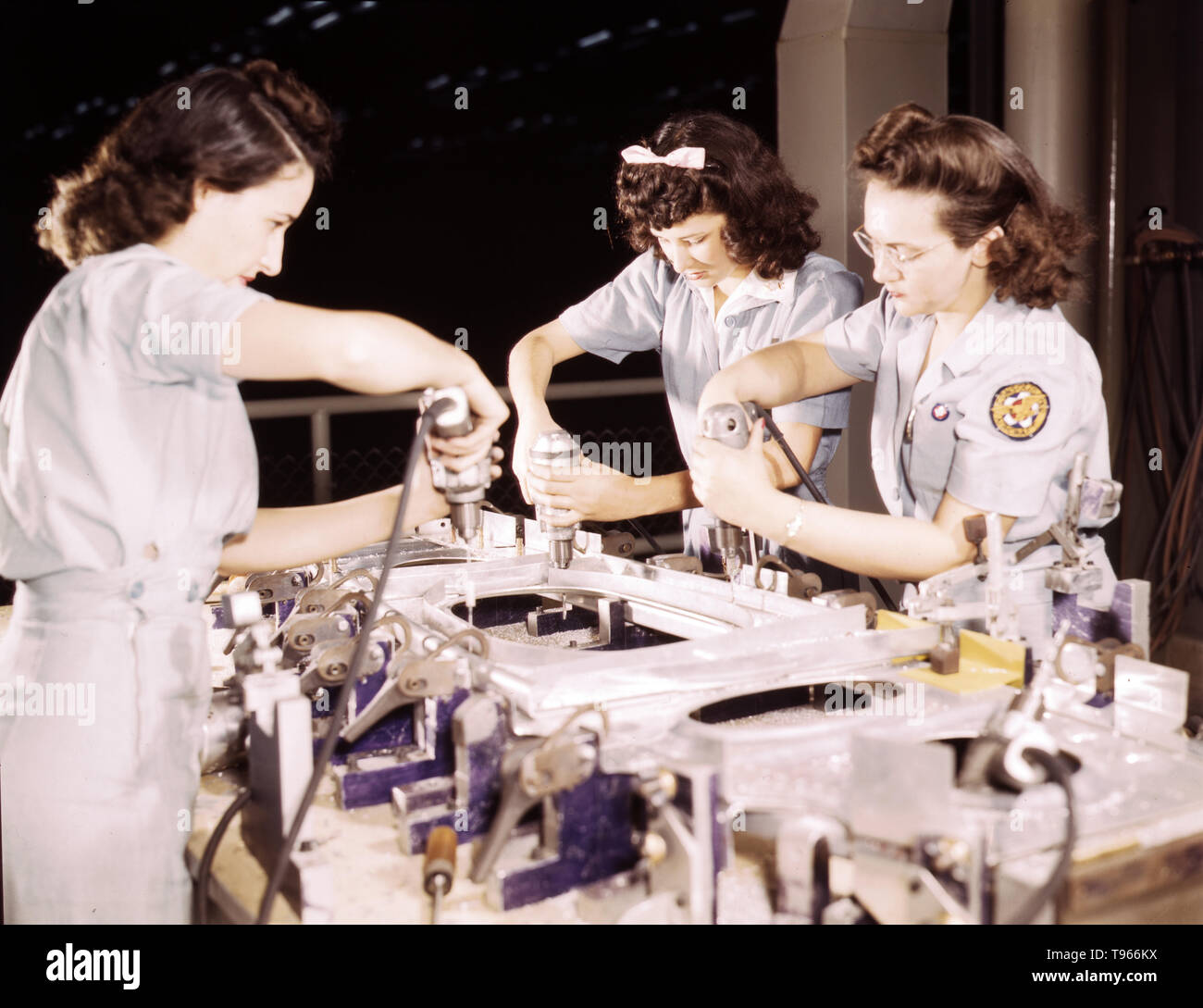 Drilling a wing bulkhead for a transport plane at the Consolidated Aircraft Corporation plant, Fort Worth, Texas. Although the image of 'Rosie the Riveter' reflected the industrial work of welders and riveters, the majority of working women filled non-factory positions in every sector of the economy. What unified the experiences of these women was that they proved to themselves, and the country, that they could do a man's job and could do it well. Photographed by Howard R. Hollem, 1942. Stock Photohttps://www.alamy.com/image-license-details/?v=1https://www.alamy.com/drilling-a-wing-bulkhead-for-a-transport-plane-at-the-consolidated-aircraft-corporation-plant-fort-worth-texas-although-the-image-of-rosie-the-riveter-reflected-the-industrial-work-of-welders-and-riveters-the-majority-of-working-women-filled-non-factory-positions-in-every-sector-of-the-economy-what-unified-the-experiences-of-these-women-was-that-they-proved-to-themselves-and-the-country-that-they-could-do-a-mans-job-and-could-do-it-well-photographed-by-howard-r-hollem-1942-image246614030.html
Drilling a wing bulkhead for a transport plane at the Consolidated Aircraft Corporation plant, Fort Worth, Texas. Although the image of 'Rosie the Riveter' reflected the industrial work of welders and riveters, the majority of working women filled non-factory positions in every sector of the economy. What unified the experiences of these women was that they proved to themselves, and the country, that they could do a man's job and could do it well. Photographed by Howard R. Hollem, 1942. Stock Photohttps://www.alamy.com/image-license-details/?v=1https://www.alamy.com/drilling-a-wing-bulkhead-for-a-transport-plane-at-the-consolidated-aircraft-corporation-plant-fort-worth-texas-although-the-image-of-rosie-the-riveter-reflected-the-industrial-work-of-welders-and-riveters-the-majority-of-working-women-filled-non-factory-positions-in-every-sector-of-the-economy-what-unified-the-experiences-of-these-women-was-that-they-proved-to-themselves-and-the-country-that-they-could-do-a-mans-job-and-could-do-it-well-photographed-by-howard-r-hollem-1942-image246614030.htmlRMT966KX–Drilling a wing bulkhead for a transport plane at the Consolidated Aircraft Corporation plant, Fort Worth, Texas. Although the image of 'Rosie the Riveter' reflected the industrial work of welders and riveters, the majority of working women filled non-factory positions in every sector of the economy. What unified the experiences of these women was that they proved to themselves, and the country, that they could do a man's job and could do it well. Photographed by Howard R. Hollem, 1942.
 Drilling a wing bulkhead for a transport plane at the Consolidated Aircraft Corporation plant, Fort Worth, Texas. Although the image of 'Rosie the Riveter' reflected the industrial work of welders and riveters, the majority of working women filled non-factory positions in every sector of the economy. What unified the experiences of these women was that they proved to themselves, and the country, that they could do a man's job and could do it well. Photographed by Howard R. Hollem, 1942. Stock Photohttps://www.alamy.com/image-license-details/?v=1https://www.alamy.com/drilling-a-wing-bulkhead-for-a-transport-plane-at-the-consolidated-aircraft-corporation-plant-fort-worth-texas-although-the-image-of-rosie-the-riveter-reflected-the-industrial-work-of-welders-and-riveters-the-majority-of-working-women-filled-non-factory-positions-in-every-sector-of-the-economy-what-unified-the-experiences-of-these-women-was-that-they-proved-to-themselves-and-the-country-that-they-could-do-a-mans-job-and-could-do-it-well-photographed-by-howard-r-hollem-1942-image246614022.html
Drilling a wing bulkhead for a transport plane at the Consolidated Aircraft Corporation plant, Fort Worth, Texas. Although the image of 'Rosie the Riveter' reflected the industrial work of welders and riveters, the majority of working women filled non-factory positions in every sector of the economy. What unified the experiences of these women was that they proved to themselves, and the country, that they could do a man's job and could do it well. Photographed by Howard R. Hollem, 1942. Stock Photohttps://www.alamy.com/image-license-details/?v=1https://www.alamy.com/drilling-a-wing-bulkhead-for-a-transport-plane-at-the-consolidated-aircraft-corporation-plant-fort-worth-texas-although-the-image-of-rosie-the-riveter-reflected-the-industrial-work-of-welders-and-riveters-the-majority-of-working-women-filled-non-factory-positions-in-every-sector-of-the-economy-what-unified-the-experiences-of-these-women-was-that-they-proved-to-themselves-and-the-country-that-they-could-do-a-mans-job-and-could-do-it-well-photographed-by-howard-r-hollem-1942-image246614022.htmlRMT966KJ–Drilling a wing bulkhead for a transport plane at the Consolidated Aircraft Corporation plant, Fort Worth, Texas. Although the image of 'Rosie the Riveter' reflected the industrial work of welders and riveters, the majority of working women filled non-factory positions in every sector of the economy. What unified the experiences of these women was that they proved to themselves, and the country, that they could do a man's job and could do it well. Photographed by Howard R. Hollem, 1942.
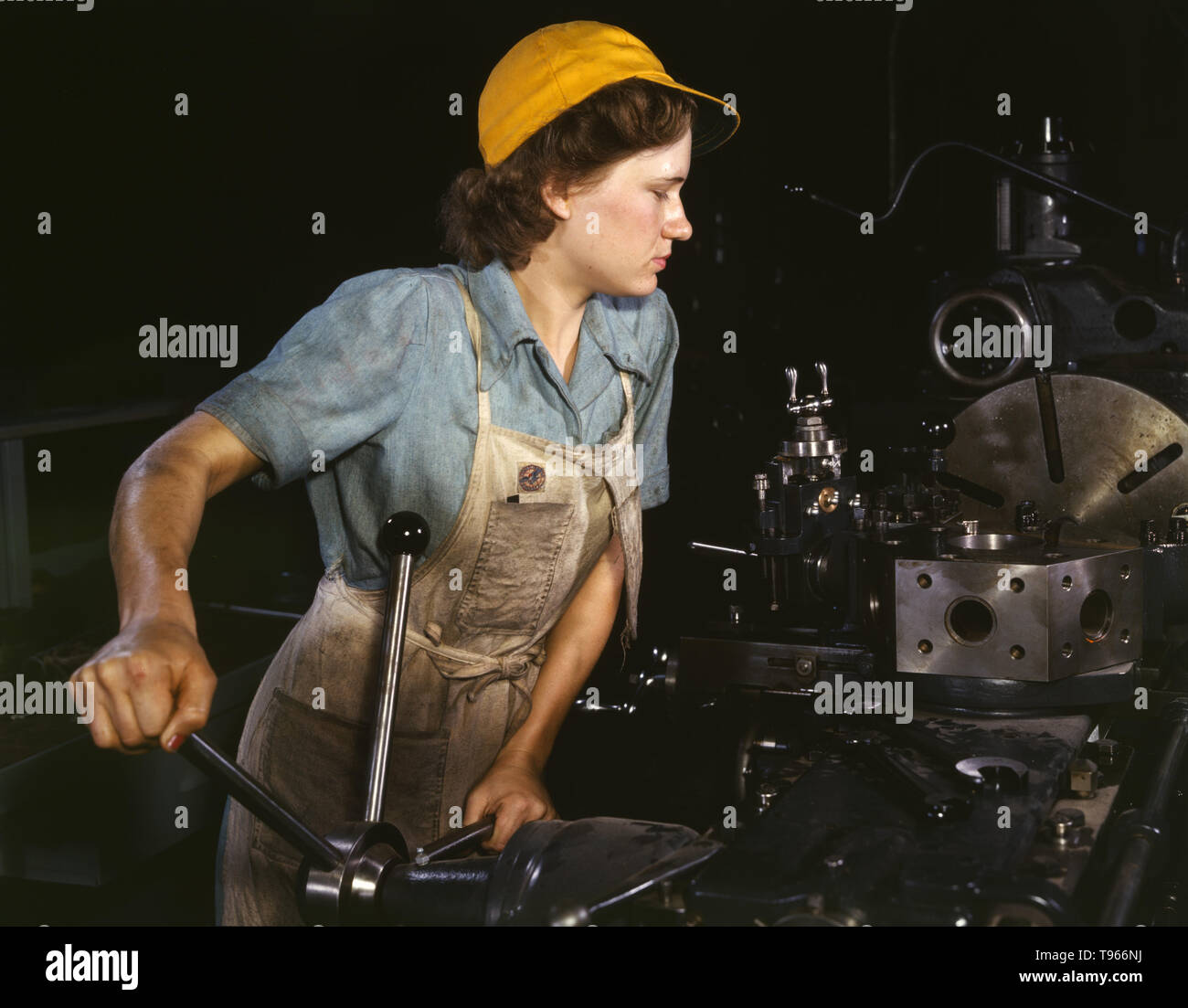 Lathe operator machining parts for transport planes at the Consolidated Aircraft Corporation plant, Fort Worth, Texas. Although the image of 'Rosie the Riveter' reflected the industrial work of welders and riveters, the majority of working women filled non-factory positions in every sector of the economy. What unified the experiences of these women was that they proved to themselves, and the country, that they could do a man's job and could do it well. Photographed by Howard R. Hollem, 1942. Stock Photohttps://www.alamy.com/image-license-details/?v=1https://www.alamy.com/lathe-operator-machining-parts-for-transport-planes-at-the-consolidated-aircraft-corporation-plant-fort-worth-texas-although-the-image-of-rosie-the-riveter-reflected-the-industrial-work-of-welders-and-riveters-the-majority-of-working-women-filled-non-factory-positions-in-every-sector-of-the-economy-what-unified-the-experiences-of-these-women-was-that-they-proved-to-themselves-and-the-country-that-they-could-do-a-mans-job-and-could-do-it-well-photographed-by-howard-r-hollem-1942-image246614078.html
Lathe operator machining parts for transport planes at the Consolidated Aircraft Corporation plant, Fort Worth, Texas. Although the image of 'Rosie the Riveter' reflected the industrial work of welders and riveters, the majority of working women filled non-factory positions in every sector of the economy. What unified the experiences of these women was that they proved to themselves, and the country, that they could do a man's job and could do it well. Photographed by Howard R. Hollem, 1942. Stock Photohttps://www.alamy.com/image-license-details/?v=1https://www.alamy.com/lathe-operator-machining-parts-for-transport-planes-at-the-consolidated-aircraft-corporation-plant-fort-worth-texas-although-the-image-of-rosie-the-riveter-reflected-the-industrial-work-of-welders-and-riveters-the-majority-of-working-women-filled-non-factory-positions-in-every-sector-of-the-economy-what-unified-the-experiences-of-these-women-was-that-they-proved-to-themselves-and-the-country-that-they-could-do-a-mans-job-and-could-do-it-well-photographed-by-howard-r-hollem-1942-image246614078.htmlRMT966NJ–Lathe operator machining parts for transport planes at the Consolidated Aircraft Corporation plant, Fort Worth, Texas. Although the image of 'Rosie the Riveter' reflected the industrial work of welders and riveters, the majority of working women filled non-factory positions in every sector of the economy. What unified the experiences of these women was that they proved to themselves, and the country, that they could do a man's job and could do it well. Photographed by Howard R. Hollem, 1942.
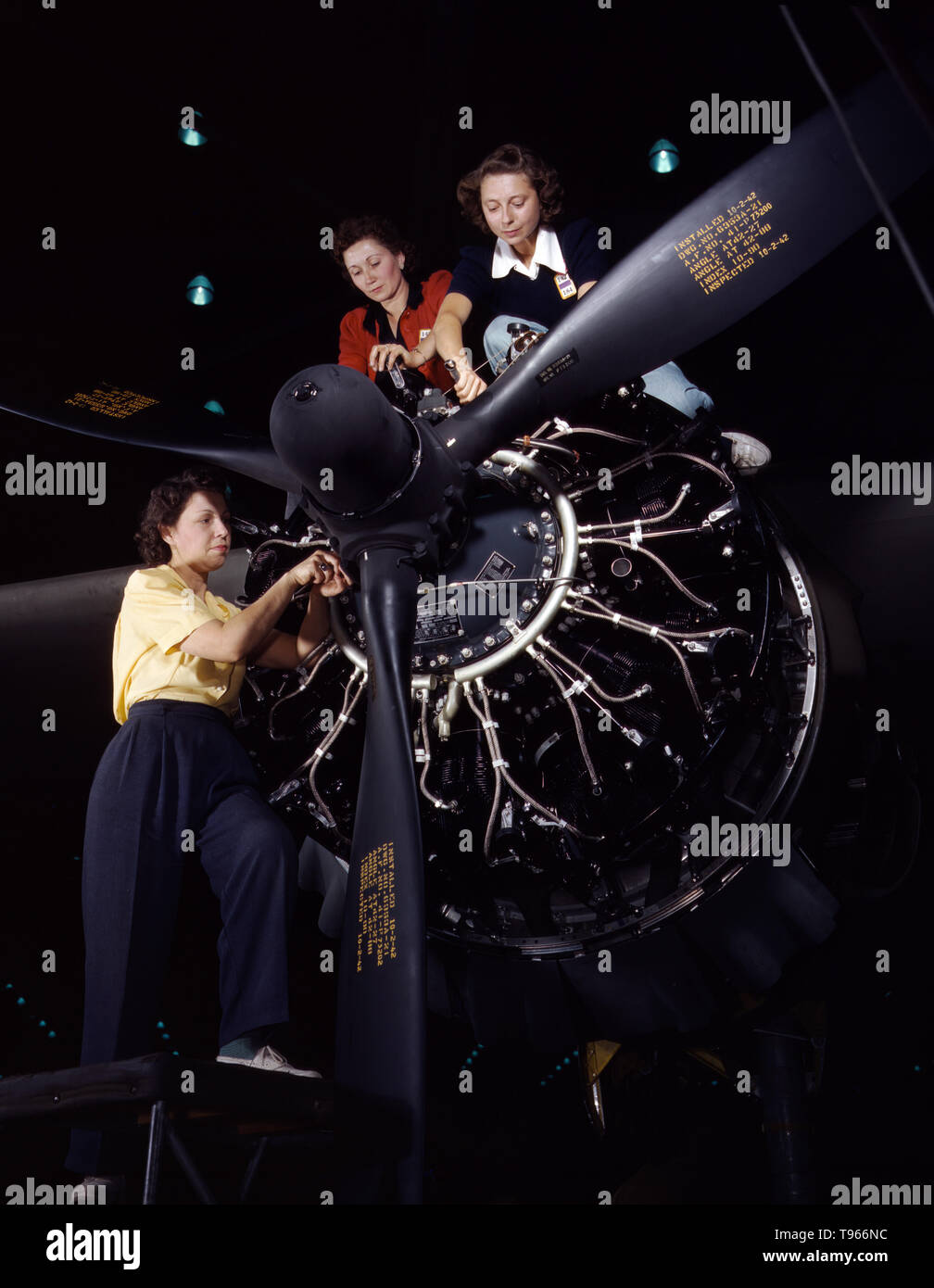 Women at work on C-47 Douglas cargo transport, Douglas Aircraft Company, Long Beach, California. Although the image of 'Rosie the Riveter' reflected the industrial work of welders and riveters, the majority of working women filled non-factory positions in every sector of the economy. What unified the experiences of these women was that they proved to themselves, and the country, that they could do a man's job and could do it well. Photographed by Alfred T. Palmer, 1942. Stock Photohttps://www.alamy.com/image-license-details/?v=1https://www.alamy.com/women-at-work-on-c-47-douglas-cargo-transport-douglas-aircraft-company-long-beach-california-although-the-image-of-rosie-the-riveter-reflected-the-industrial-work-of-welders-and-riveters-the-majority-of-working-women-filled-non-factory-positions-in-every-sector-of-the-economy-what-unified-the-experiences-of-these-women-was-that-they-proved-to-themselves-and-the-country-that-they-could-do-a-mans-job-and-could-do-it-well-photographed-by-alfred-t-palmer-1942-image246614072.html
Women at work on C-47 Douglas cargo transport, Douglas Aircraft Company, Long Beach, California. Although the image of 'Rosie the Riveter' reflected the industrial work of welders and riveters, the majority of working women filled non-factory positions in every sector of the economy. What unified the experiences of these women was that they proved to themselves, and the country, that they could do a man's job and could do it well. Photographed by Alfred T. Palmer, 1942. Stock Photohttps://www.alamy.com/image-license-details/?v=1https://www.alamy.com/women-at-work-on-c-47-douglas-cargo-transport-douglas-aircraft-company-long-beach-california-although-the-image-of-rosie-the-riveter-reflected-the-industrial-work-of-welders-and-riveters-the-majority-of-working-women-filled-non-factory-positions-in-every-sector-of-the-economy-what-unified-the-experiences-of-these-women-was-that-they-proved-to-themselves-and-the-country-that-they-could-do-a-mans-job-and-could-do-it-well-photographed-by-alfred-t-palmer-1942-image246614072.htmlRMT966NC–Women at work on C-47 Douglas cargo transport, Douglas Aircraft Company, Long Beach, California. Although the image of 'Rosie the Riveter' reflected the industrial work of welders and riveters, the majority of working women filled non-factory positions in every sector of the economy. What unified the experiences of these women was that they proved to themselves, and the country, that they could do a man's job and could do it well. Photographed by Alfred T. Palmer, 1942.
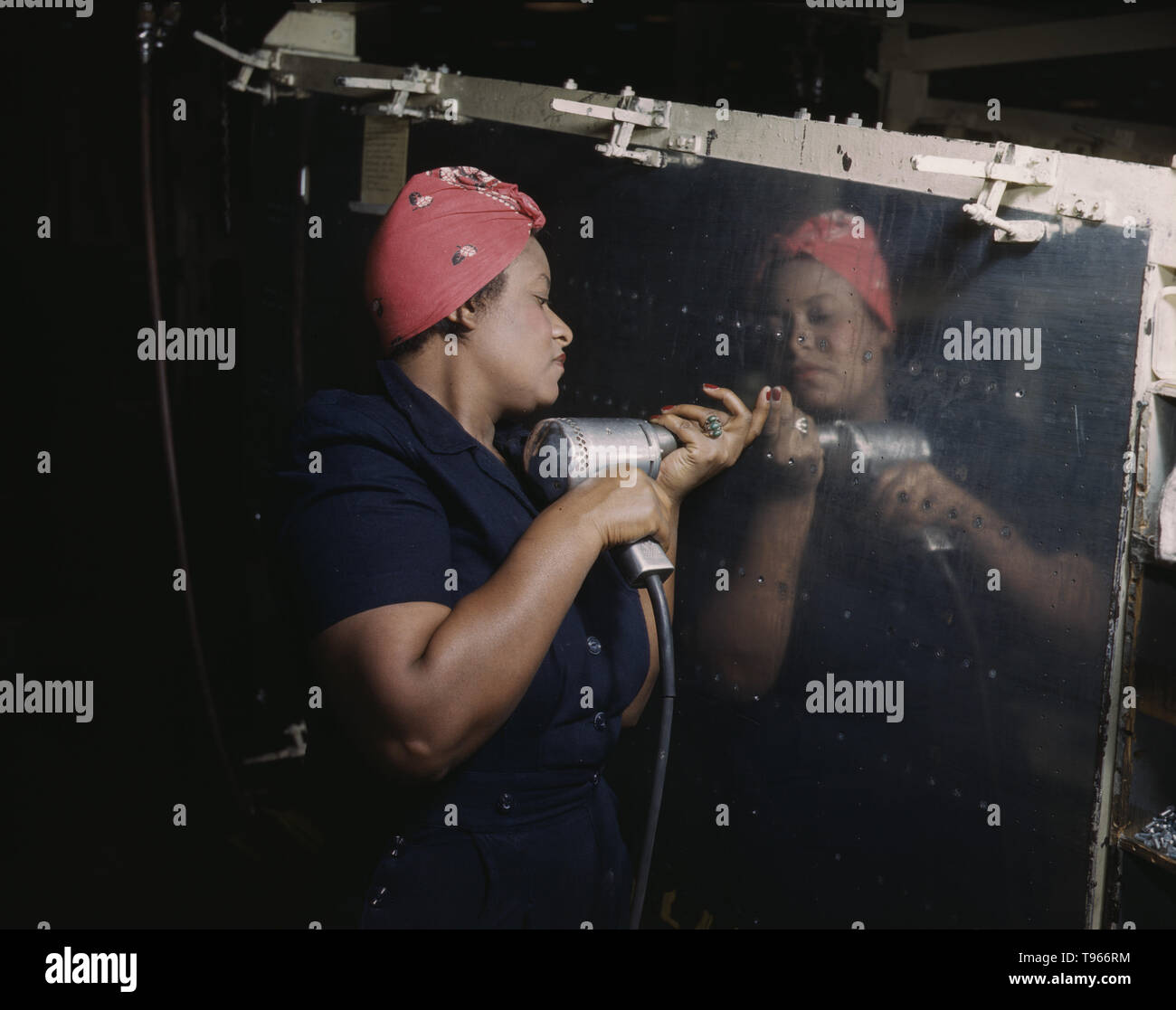 Operating a hand drill at Vultee-Nashville, woman is working on a Vengeance dive bomber, Tennessee. Although the image of 'Rosie the Riveter' reflected the industrial work of welders and riveters, the majority of working women filled non-factory positions in every sector of the economy. What unified the experiences of these women was that they proved to themselves, and the country, that they could do a man's job and could do it well. Photographed by Alfred T. Palmer, 1942. Stock Photohttps://www.alamy.com/image-license-details/?v=1https://www.alamy.com/operating-a-hand-drill-at-vultee-nashville-woman-is-working-on-a-vengeance-dive-bomber-tennessee-although-the-image-of-rosie-the-riveter-reflected-the-industrial-work-of-welders-and-riveters-the-majority-of-working-women-filled-non-factory-positions-in-every-sector-of-the-economy-what-unified-the-experiences-of-these-women-was-that-they-proved-to-themselves-and-the-country-that-they-could-do-a-mans-job-and-could-do-it-well-photographed-by-alfred-t-palmer-1942-image246614136.html
Operating a hand drill at Vultee-Nashville, woman is working on a Vengeance dive bomber, Tennessee. Although the image of 'Rosie the Riveter' reflected the industrial work of welders and riveters, the majority of working women filled non-factory positions in every sector of the economy. What unified the experiences of these women was that they proved to themselves, and the country, that they could do a man's job and could do it well. Photographed by Alfred T. Palmer, 1942. Stock Photohttps://www.alamy.com/image-license-details/?v=1https://www.alamy.com/operating-a-hand-drill-at-vultee-nashville-woman-is-working-on-a-vengeance-dive-bomber-tennessee-although-the-image-of-rosie-the-riveter-reflected-the-industrial-work-of-welders-and-riveters-the-majority-of-working-women-filled-non-factory-positions-in-every-sector-of-the-economy-what-unified-the-experiences-of-these-women-was-that-they-proved-to-themselves-and-the-country-that-they-could-do-a-mans-job-and-could-do-it-well-photographed-by-alfred-t-palmer-1942-image246614136.htmlRMT966RM–Operating a hand drill at Vultee-Nashville, woman is working on a Vengeance dive bomber, Tennessee. Although the image of 'Rosie the Riveter' reflected the industrial work of welders and riveters, the majority of working women filled non-factory positions in every sector of the economy. What unified the experiences of these women was that they proved to themselves, and the country, that they could do a man's job and could do it well. Photographed by Alfred T. Palmer, 1942.
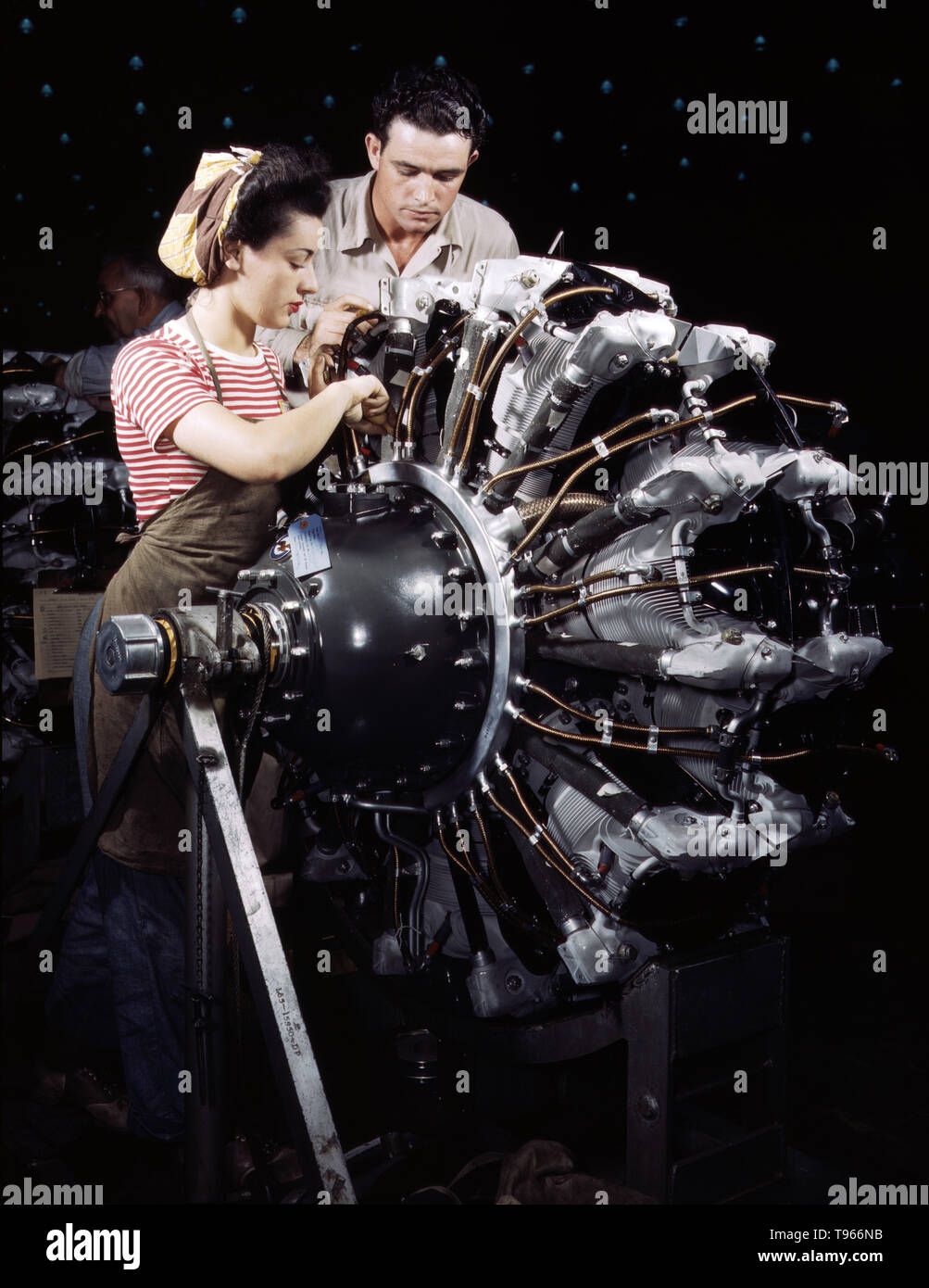 Women are trained as engine mechanics in thorough Douglas training methods, Douglas Aircraft Company, Long Beach, California. Although the image of 'Rosie the Riveter' reflected the industrial work of welders and riveters, the majority of working women filled non-factory positions in every sector of the economy. What unified the experiences of these women was that they proved to themselves, and the country, that they could do a man's job and could do it well. Photographed by Alfred T. Palmer, 1942. Stock Photohttps://www.alamy.com/image-license-details/?v=1https://www.alamy.com/women-are-trained-as-engine-mechanics-in-thorough-douglas-training-methods-douglas-aircraft-company-long-beach-california-although-the-image-of-rosie-the-riveter-reflected-the-industrial-work-of-welders-and-riveters-the-majority-of-working-women-filled-non-factory-positions-in-every-sector-of-the-economy-what-unified-the-experiences-of-these-women-was-that-they-proved-to-themselves-and-the-country-that-they-could-do-a-mans-job-and-could-do-it-well-photographed-by-alfred-t-palmer-1942-image246614071.html
Women are trained as engine mechanics in thorough Douglas training methods, Douglas Aircraft Company, Long Beach, California. Although the image of 'Rosie the Riveter' reflected the industrial work of welders and riveters, the majority of working women filled non-factory positions in every sector of the economy. What unified the experiences of these women was that they proved to themselves, and the country, that they could do a man's job and could do it well. Photographed by Alfred T. Palmer, 1942. Stock Photohttps://www.alamy.com/image-license-details/?v=1https://www.alamy.com/women-are-trained-as-engine-mechanics-in-thorough-douglas-training-methods-douglas-aircraft-company-long-beach-california-although-the-image-of-rosie-the-riveter-reflected-the-industrial-work-of-welders-and-riveters-the-majority-of-working-women-filled-non-factory-positions-in-every-sector-of-the-economy-what-unified-the-experiences-of-these-women-was-that-they-proved-to-themselves-and-the-country-that-they-could-do-a-mans-job-and-could-do-it-well-photographed-by-alfred-t-palmer-1942-image246614071.htmlRMT966NB–Women are trained as engine mechanics in thorough Douglas training methods, Douglas Aircraft Company, Long Beach, California. Although the image of 'Rosie the Riveter' reflected the industrial work of welders and riveters, the majority of working women filled non-factory positions in every sector of the economy. What unified the experiences of these women was that they proved to themselves, and the country, that they could do a man's job and could do it well. Photographed by Alfred T. Palmer, 1942.
 With careful Douglas training, women do accurate electrical assembly and installation work, Douglas Aircraft Company, Long Beach, California. Although the image of 'Rosie the Riveter' reflected the industrial work of welders and riveters, the majority of working women filled non-factory positions in every sector of the economy. What unified the experiences of these women was that they proved to themselves, and the country, that they could do a man's job and could do it well. Photographed by Alfred T. Palmer, 1942. Stock Photohttps://www.alamy.com/image-license-details/?v=1https://www.alamy.com/with-careful-douglas-training-women-do-accurate-electrical-assembly-and-installation-work-douglas-aircraft-company-long-beach-california-although-the-image-of-rosie-the-riveter-reflected-the-industrial-work-of-welders-and-riveters-the-majority-of-working-women-filled-non-factory-positions-in-every-sector-of-the-economy-what-unified-the-experiences-of-these-women-was-that-they-proved-to-themselves-and-the-country-that-they-could-do-a-mans-job-and-could-do-it-well-photographed-by-alfred-t-palmer-1942-image246614076.html
With careful Douglas training, women do accurate electrical assembly and installation work, Douglas Aircraft Company, Long Beach, California. Although the image of 'Rosie the Riveter' reflected the industrial work of welders and riveters, the majority of working women filled non-factory positions in every sector of the economy. What unified the experiences of these women was that they proved to themselves, and the country, that they could do a man's job and could do it well. Photographed by Alfred T. Palmer, 1942. Stock Photohttps://www.alamy.com/image-license-details/?v=1https://www.alamy.com/with-careful-douglas-training-women-do-accurate-electrical-assembly-and-installation-work-douglas-aircraft-company-long-beach-california-although-the-image-of-rosie-the-riveter-reflected-the-industrial-work-of-welders-and-riveters-the-majority-of-working-women-filled-non-factory-positions-in-every-sector-of-the-economy-what-unified-the-experiences-of-these-women-was-that-they-proved-to-themselves-and-the-country-that-they-could-do-a-mans-job-and-could-do-it-well-photographed-by-alfred-t-palmer-1942-image246614076.htmlRMT966NG–With careful Douglas training, women do accurate electrical assembly and installation work, Douglas Aircraft Company, Long Beach, California. Although the image of 'Rosie the Riveter' reflected the industrial work of welders and riveters, the majority of working women filled non-factory positions in every sector of the economy. What unified the experiences of these women was that they proved to themselves, and the country, that they could do a man's job and could do it well. Photographed by Alfred T. Palmer, 1942.
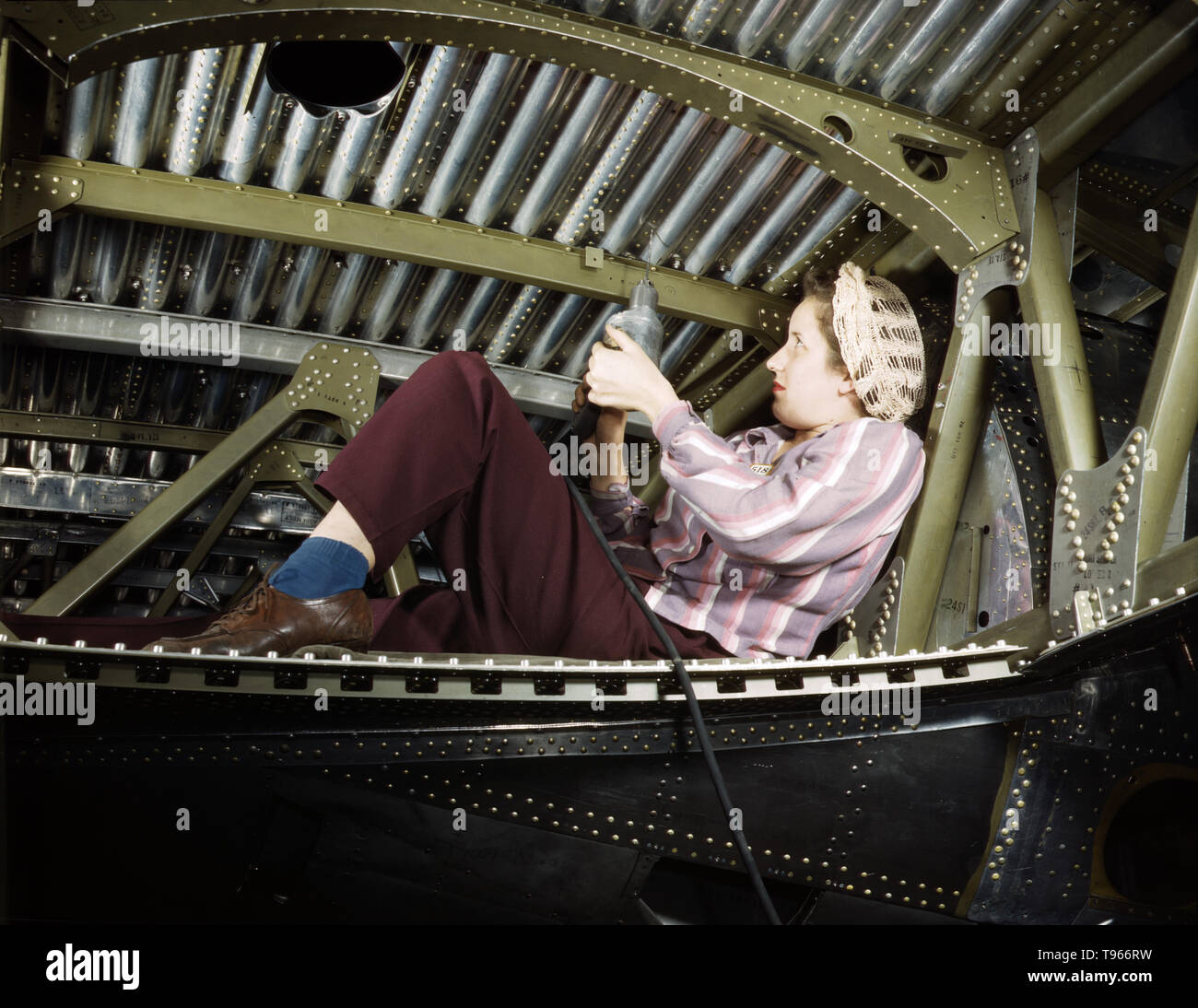 An A-20 bomber being riveted by a woman worker at the Douglas Aircraft Company plant at Long Beach, California. Although the image of 'Rosie the Riveter' reflected the industrial work of welders and riveters, the majority of working women filled non-factory positions in every sector of the economy. What unified the experiences of these women was that they proved to themselves, and the country, that they could do a man's job and could do it well. Photographed by Alfred T. Palmer, 1942. Stock Photohttps://www.alamy.com/image-license-details/?v=1https://www.alamy.com/an-a-20-bomber-being-riveted-by-a-woman-worker-at-the-douglas-aircraft-company-plant-at-long-beach-california-although-the-image-of-rosie-the-riveter-reflected-the-industrial-work-of-welders-and-riveters-the-majority-of-working-women-filled-non-factory-positions-in-every-sector-of-the-economy-what-unified-the-experiences-of-these-women-was-that-they-proved-to-themselves-and-the-country-that-they-could-do-a-mans-job-and-could-do-it-well-photographed-by-alfred-t-palmer-1942-image246614141.html
An A-20 bomber being riveted by a woman worker at the Douglas Aircraft Company plant at Long Beach, California. Although the image of 'Rosie the Riveter' reflected the industrial work of welders and riveters, the majority of working women filled non-factory positions in every sector of the economy. What unified the experiences of these women was that they proved to themselves, and the country, that they could do a man's job and could do it well. Photographed by Alfred T. Palmer, 1942. Stock Photohttps://www.alamy.com/image-license-details/?v=1https://www.alamy.com/an-a-20-bomber-being-riveted-by-a-woman-worker-at-the-douglas-aircraft-company-plant-at-long-beach-california-although-the-image-of-rosie-the-riveter-reflected-the-industrial-work-of-welders-and-riveters-the-majority-of-working-women-filled-non-factory-positions-in-every-sector-of-the-economy-what-unified-the-experiences-of-these-women-was-that-they-proved-to-themselves-and-the-country-that-they-could-do-a-mans-job-and-could-do-it-well-photographed-by-alfred-t-palmer-1942-image246614141.htmlRMT966RW–An A-20 bomber being riveted by a woman worker at the Douglas Aircraft Company plant at Long Beach, California. Although the image of 'Rosie the Riveter' reflected the industrial work of welders and riveters, the majority of working women filled non-factory positions in every sector of the economy. What unified the experiences of these women was that they proved to themselves, and the country, that they could do a man's job and could do it well. Photographed by Alfred T. Palmer, 1942.
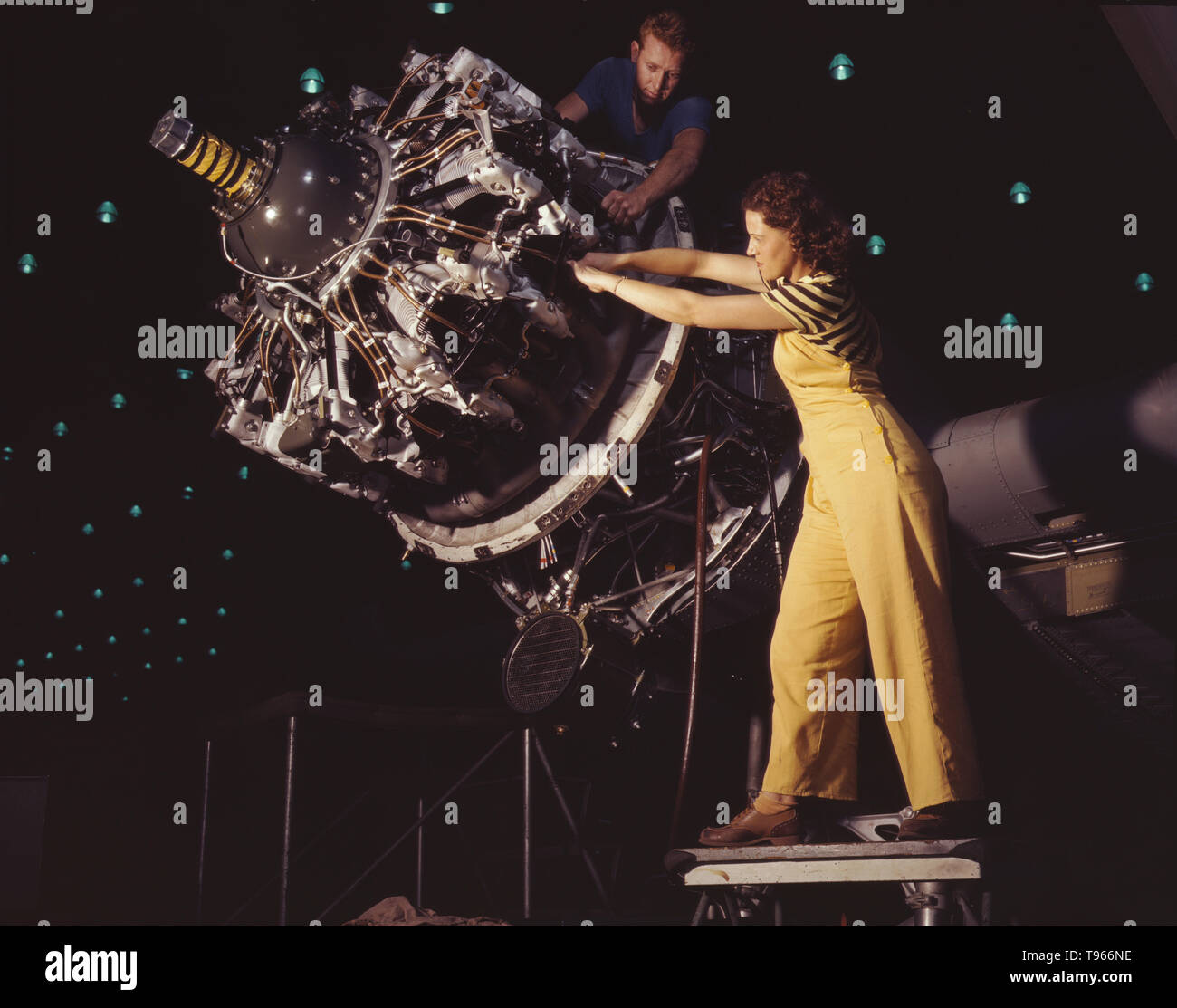 Women are trained to do precise and vital engine installation detail in Douglas Aircraft Company plants, Long Beach, California. Although the image of 'Rosie the Riveter' reflected the industrial work of welders and riveters, the majority of working women filled non-factory positions in every sector of the economy. What unified the experiences of these women was that they proved to themselves, and the country, that they could do a man's job and could do it well. Photographed by Alfred T. Palmer, 1942. Stock Photohttps://www.alamy.com/image-license-details/?v=1https://www.alamy.com/women-are-trained-to-do-precise-and-vital-engine-installation-detail-in-douglas-aircraft-company-plants-long-beach-california-although-the-image-of-rosie-the-riveter-reflected-the-industrial-work-of-welders-and-riveters-the-majority-of-working-women-filled-non-factory-positions-in-every-sector-of-the-economy-what-unified-the-experiences-of-these-women-was-that-they-proved-to-themselves-and-the-country-that-they-could-do-a-mans-job-and-could-do-it-well-photographed-by-alfred-t-palmer-1942-image246614074.html
Women are trained to do precise and vital engine installation detail in Douglas Aircraft Company plants, Long Beach, California. Although the image of 'Rosie the Riveter' reflected the industrial work of welders and riveters, the majority of working women filled non-factory positions in every sector of the economy. What unified the experiences of these women was that they proved to themselves, and the country, that they could do a man's job and could do it well. Photographed by Alfred T. Palmer, 1942. Stock Photohttps://www.alamy.com/image-license-details/?v=1https://www.alamy.com/women-are-trained-to-do-precise-and-vital-engine-installation-detail-in-douglas-aircraft-company-plants-long-beach-california-although-the-image-of-rosie-the-riveter-reflected-the-industrial-work-of-welders-and-riveters-the-majority-of-working-women-filled-non-factory-positions-in-every-sector-of-the-economy-what-unified-the-experiences-of-these-women-was-that-they-proved-to-themselves-and-the-country-that-they-could-do-a-mans-job-and-could-do-it-well-photographed-by-alfred-t-palmer-1942-image246614074.htmlRMT966NE–Women are trained to do precise and vital engine installation detail in Douglas Aircraft Company plants, Long Beach, California. Although the image of 'Rosie the Riveter' reflected the industrial work of welders and riveters, the majority of working women filled non-factory positions in every sector of the economy. What unified the experiences of these women was that they proved to themselves, and the country, that they could do a man's job and could do it well. Photographed by Alfred T. Palmer, 1942.
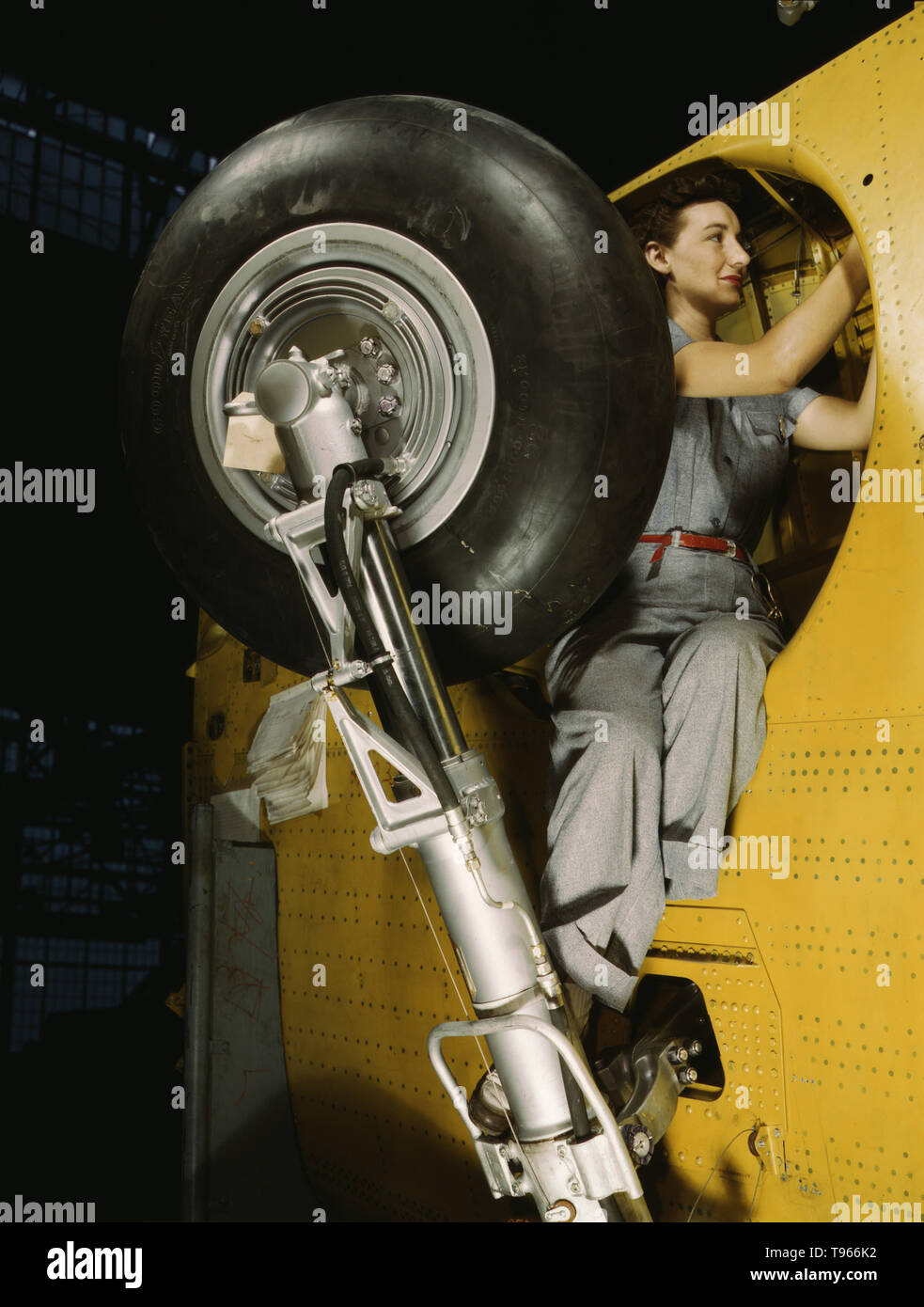 This woman worker at the Vultee-Nashville is shown making final adjustments in the wheel well of an inner wing before the installation of the landing gear, Nashville, Tenn. This is one of the numerous assembly operations in connection with the mass production of Vultee Vengeance dive bombers. Although the image of 'Rosie the Riveter' reflected the industrial work of welders and riveters, the majority of working women filled non-factory positions in every sector of the economy. Stock Photohttps://www.alamy.com/image-license-details/?v=1https://www.alamy.com/this-woman-worker-at-the-vultee-nashville-is-shown-making-final-adjustments-in-the-wheel-well-of-an-inner-wing-before-the-installation-of-the-landing-gear-nashville-tenn-this-is-one-of-the-numerous-assembly-operations-in-connection-with-the-mass-production-of-vultee-vengeance-dive-bombers-although-the-image-of-rosie-the-riveter-reflected-the-industrial-work-of-welders-and-riveters-the-majority-of-working-women-filled-non-factory-positions-in-every-sector-of-the-economy-image246614006.html
This woman worker at the Vultee-Nashville is shown making final adjustments in the wheel well of an inner wing before the installation of the landing gear, Nashville, Tenn. This is one of the numerous assembly operations in connection with the mass production of Vultee Vengeance dive bombers. Although the image of 'Rosie the Riveter' reflected the industrial work of welders and riveters, the majority of working women filled non-factory positions in every sector of the economy. Stock Photohttps://www.alamy.com/image-license-details/?v=1https://www.alamy.com/this-woman-worker-at-the-vultee-nashville-is-shown-making-final-adjustments-in-the-wheel-well-of-an-inner-wing-before-the-installation-of-the-landing-gear-nashville-tenn-this-is-one-of-the-numerous-assembly-operations-in-connection-with-the-mass-production-of-vultee-vengeance-dive-bombers-although-the-image-of-rosie-the-riveter-reflected-the-industrial-work-of-welders-and-riveters-the-majority-of-working-women-filled-non-factory-positions-in-every-sector-of-the-economy-image246614006.htmlRMT966K2–This woman worker at the Vultee-Nashville is shown making final adjustments in the wheel well of an inner wing before the installation of the landing gear, Nashville, Tenn. This is one of the numerous assembly operations in connection with the mass production of Vultee Vengeance dive bombers. Although the image of 'Rosie the Riveter' reflected the industrial work of welders and riveters, the majority of working women filled non-factory positions in every sector of the economy.
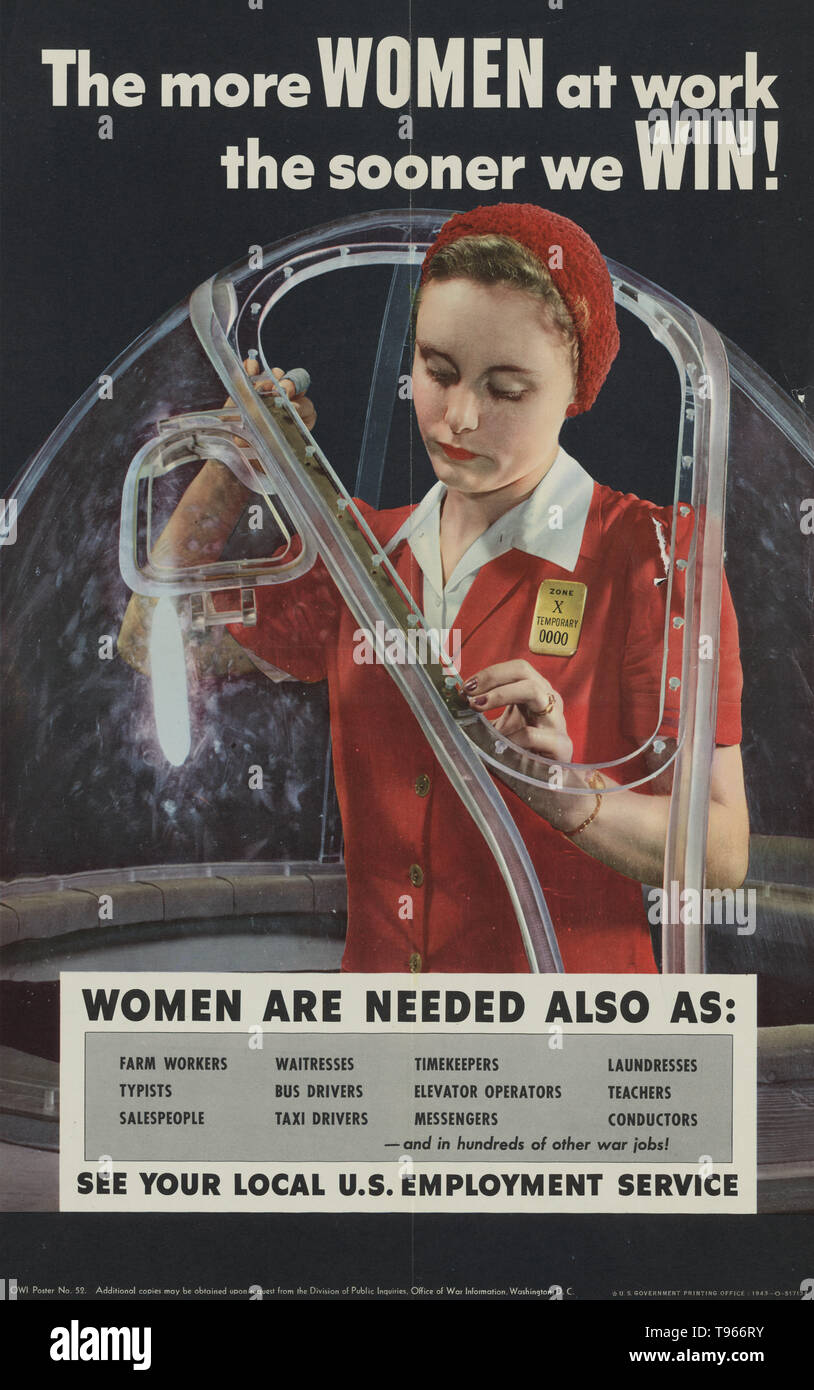 The more women at work the sooner we win! See your local U.S. Employment Service. Woman working in an airplane factory. Although the image of 'Rosie the Riveter' reflected the industrial work of welders and riveters, the majority of working women filled non-factory positions in every sector of the economy. What unified the experiences of these women was that they proved to themselves, and the country, that they could do a man's job and could do it well. Photographed by Alfred T. Palmer, 1942. Stock Photohttps://www.alamy.com/image-license-details/?v=1https://www.alamy.com/the-more-women-at-work-the-sooner-we-win!-see-your-local-us-employment-service-woman-working-in-an-airplane-factory-although-the-image-of-rosie-the-riveter-reflected-the-industrial-work-of-welders-and-riveters-the-majority-of-working-women-filled-non-factory-positions-in-every-sector-of-the-economy-what-unified-the-experiences-of-these-women-was-that-they-proved-to-themselves-and-the-country-that-they-could-do-a-mans-job-and-could-do-it-well-photographed-by-alfred-t-palmer-1942-image246614143.html
The more women at work the sooner we win! See your local U.S. Employment Service. Woman working in an airplane factory. Although the image of 'Rosie the Riveter' reflected the industrial work of welders and riveters, the majority of working women filled non-factory positions in every sector of the economy. What unified the experiences of these women was that they proved to themselves, and the country, that they could do a man's job and could do it well. Photographed by Alfred T. Palmer, 1942. Stock Photohttps://www.alamy.com/image-license-details/?v=1https://www.alamy.com/the-more-women-at-work-the-sooner-we-win!-see-your-local-us-employment-service-woman-working-in-an-airplane-factory-although-the-image-of-rosie-the-riveter-reflected-the-industrial-work-of-welders-and-riveters-the-majority-of-working-women-filled-non-factory-positions-in-every-sector-of-the-economy-what-unified-the-experiences-of-these-women-was-that-they-proved-to-themselves-and-the-country-that-they-could-do-a-mans-job-and-could-do-it-well-photographed-by-alfred-t-palmer-1942-image246614143.htmlRMT966RY–The more women at work the sooner we win! See your local U.S. Employment Service. Woman working in an airplane factory. Although the image of 'Rosie the Riveter' reflected the industrial work of welders and riveters, the majority of working women filled non-factory positions in every sector of the economy. What unified the experiences of these women was that they proved to themselves, and the country, that they could do a man's job and could do it well. Photographed by Alfred T. Palmer, 1942.
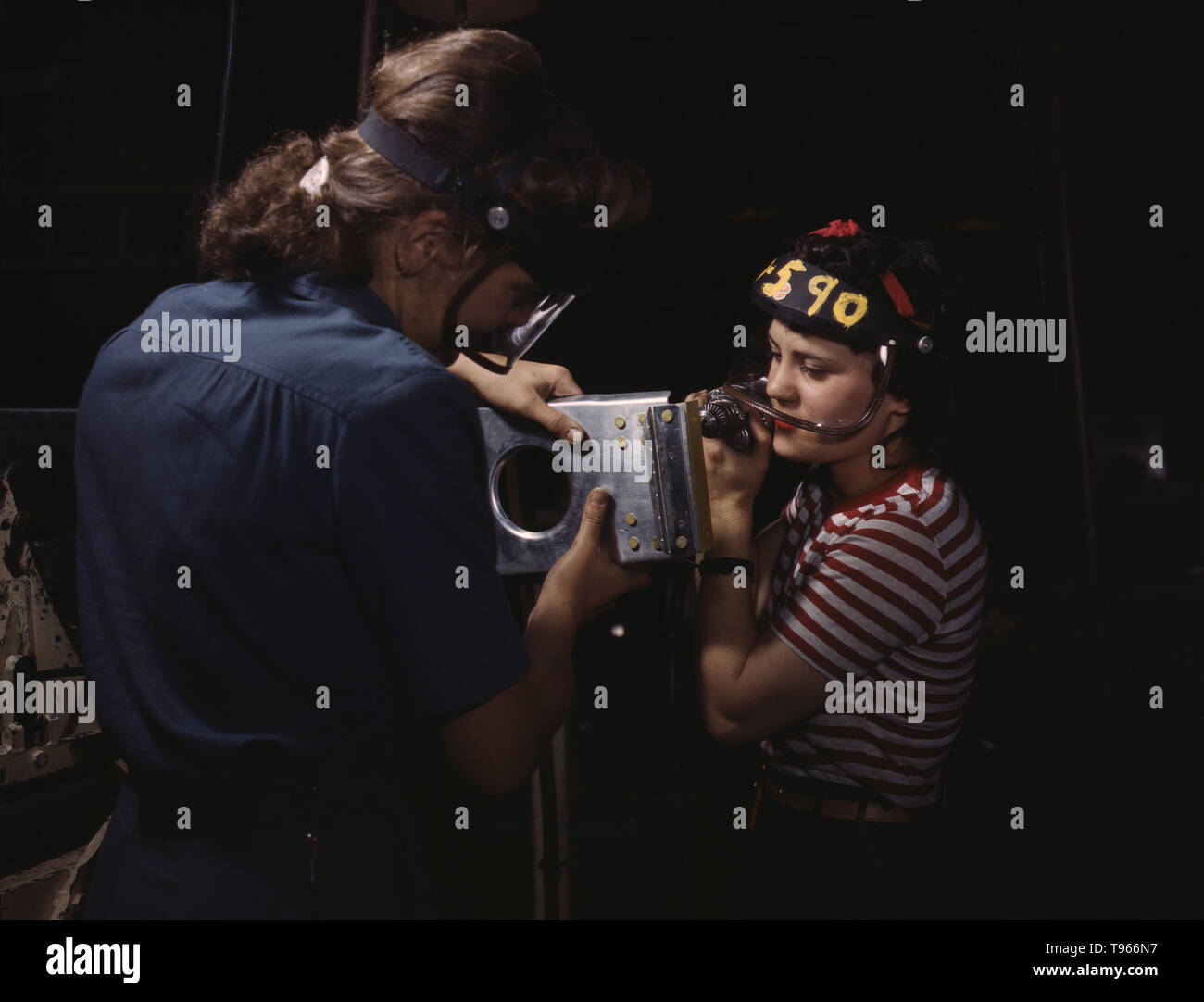 Two women employees of North American Aviation, Incorporated, assembling a section of a wing for a P-51 fighter plane. Although the image of 'Rosie the Riveter' reflected the industrial work of welders and riveters, the majority of working women filled non-factory positions in every sector of the economy. What unified the experiences of these women was that they proved to themselves, and the country, that they could do a man's job and could do it well. Photographed by Alfred T. Palmer, 1942. Stock Photohttps://www.alamy.com/image-license-details/?v=1https://www.alamy.com/two-women-employees-of-north-american-aviation-incorporated-assembling-a-section-of-a-wing-for-a-p-51-fighter-plane-although-the-image-of-rosie-the-riveter-reflected-the-industrial-work-of-welders-and-riveters-the-majority-of-working-women-filled-non-factory-positions-in-every-sector-of-the-economy-what-unified-the-experiences-of-these-women-was-that-they-proved-to-themselves-and-the-country-that-they-could-do-a-mans-job-and-could-do-it-well-photographed-by-alfred-t-palmer-1942-image246614067.html
Two women employees of North American Aviation, Incorporated, assembling a section of a wing for a P-51 fighter plane. Although the image of 'Rosie the Riveter' reflected the industrial work of welders and riveters, the majority of working women filled non-factory positions in every sector of the economy. What unified the experiences of these women was that they proved to themselves, and the country, that they could do a man's job and could do it well. Photographed by Alfred T. Palmer, 1942. Stock Photohttps://www.alamy.com/image-license-details/?v=1https://www.alamy.com/two-women-employees-of-north-american-aviation-incorporated-assembling-a-section-of-a-wing-for-a-p-51-fighter-plane-although-the-image-of-rosie-the-riveter-reflected-the-industrial-work-of-welders-and-riveters-the-majority-of-working-women-filled-non-factory-positions-in-every-sector-of-the-economy-what-unified-the-experiences-of-these-women-was-that-they-proved-to-themselves-and-the-country-that-they-could-do-a-mans-job-and-could-do-it-well-photographed-by-alfred-t-palmer-1942-image246614067.htmlRMT966N7–Two women employees of North American Aviation, Incorporated, assembling a section of a wing for a P-51 fighter plane. Although the image of 'Rosie the Riveter' reflected the industrial work of welders and riveters, the majority of working women filled non-factory positions in every sector of the economy. What unified the experiences of these women was that they proved to themselves, and the country, that they could do a man's job and could do it well. Photographed by Alfred T. Palmer, 1942.
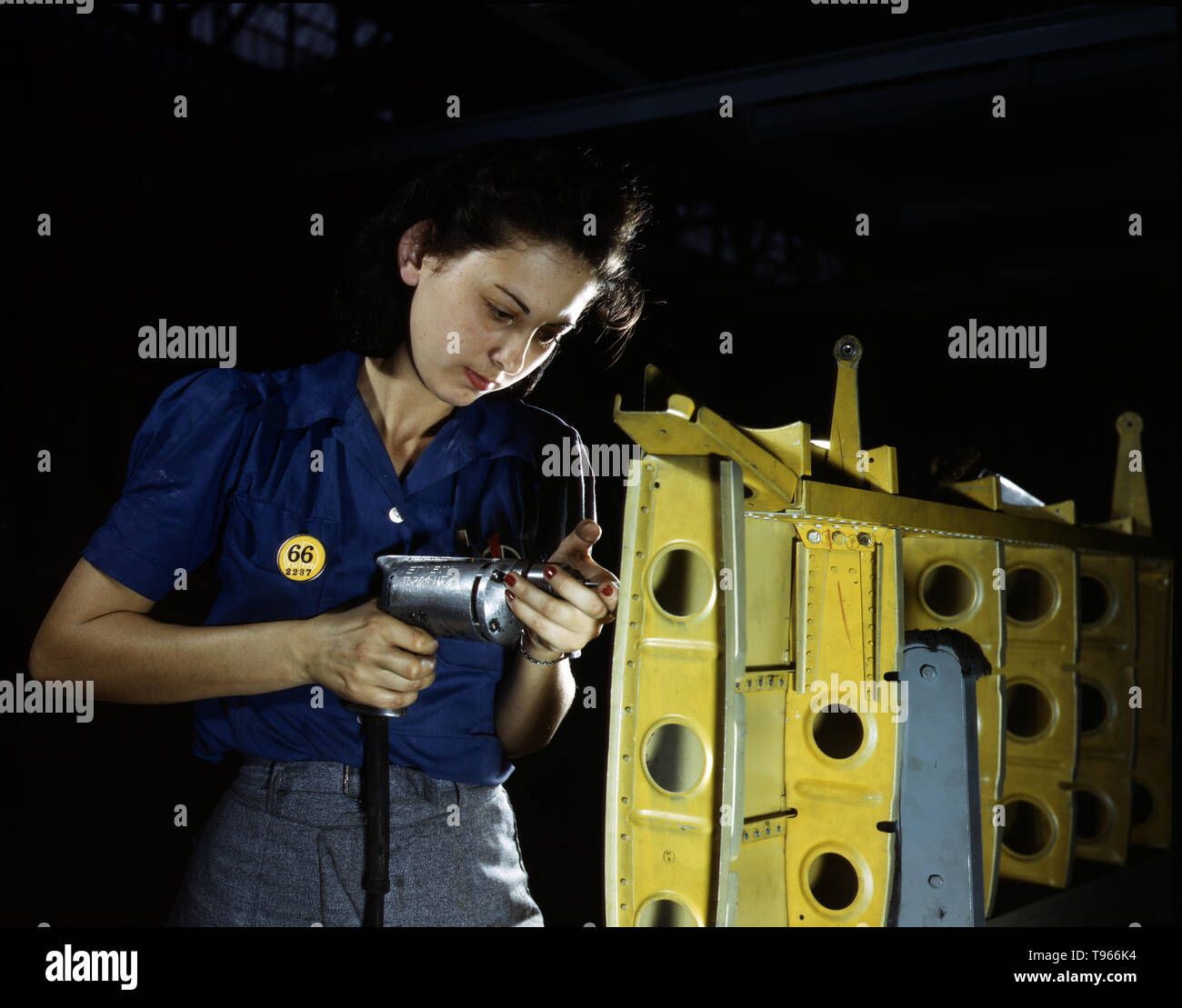 Drilling horizontal stabilizers: operating a hand drill, this woman worker at Vultee-Nashville is shown working on the horizontal stabilizer for a Vultee Vengeance dive bomber, Tennessee. The Vengeance (A-31) was originally designed for the French. Although the image of 'Rosie the Riveter' reflected the industrial work of welders and riveters, the majority of working women filled non-factory positions in every sector of the economy. Photographed by Alfred T. Palmer, 1943. Stock Photohttps://www.alamy.com/image-license-details/?v=1https://www.alamy.com/drilling-horizontal-stabilizers-operating-a-hand-drill-this-woman-worker-at-vultee-nashville-is-shown-working-on-the-horizontal-stabilizer-for-a-vultee-vengeance-dive-bomber-tennessee-the-vengeance-a-31-was-originally-designed-for-the-french-although-the-image-of-rosie-the-riveter-reflected-the-industrial-work-of-welders-and-riveters-the-majority-of-working-women-filled-non-factory-positions-in-every-sector-of-the-economy-photographed-by-alfred-t-palmer-1943-image246614008.html
Drilling horizontal stabilizers: operating a hand drill, this woman worker at Vultee-Nashville is shown working on the horizontal stabilizer for a Vultee Vengeance dive bomber, Tennessee. The Vengeance (A-31) was originally designed for the French. Although the image of 'Rosie the Riveter' reflected the industrial work of welders and riveters, the majority of working women filled non-factory positions in every sector of the economy. Photographed by Alfred T. Palmer, 1943. Stock Photohttps://www.alamy.com/image-license-details/?v=1https://www.alamy.com/drilling-horizontal-stabilizers-operating-a-hand-drill-this-woman-worker-at-vultee-nashville-is-shown-working-on-the-horizontal-stabilizer-for-a-vultee-vengeance-dive-bomber-tennessee-the-vengeance-a-31-was-originally-designed-for-the-french-although-the-image-of-rosie-the-riveter-reflected-the-industrial-work-of-welders-and-riveters-the-majority-of-working-women-filled-non-factory-positions-in-every-sector-of-the-economy-photographed-by-alfred-t-palmer-1943-image246614008.htmlRMT966K4–Drilling horizontal stabilizers: operating a hand drill, this woman worker at Vultee-Nashville is shown working on the horizontal stabilizer for a Vultee Vengeance dive bomber, Tennessee. The Vengeance (A-31) was originally designed for the French. Although the image of 'Rosie the Riveter' reflected the industrial work of welders and riveters, the majority of working women filled non-factory positions in every sector of the economy. Photographed by Alfred T. Palmer, 1943.
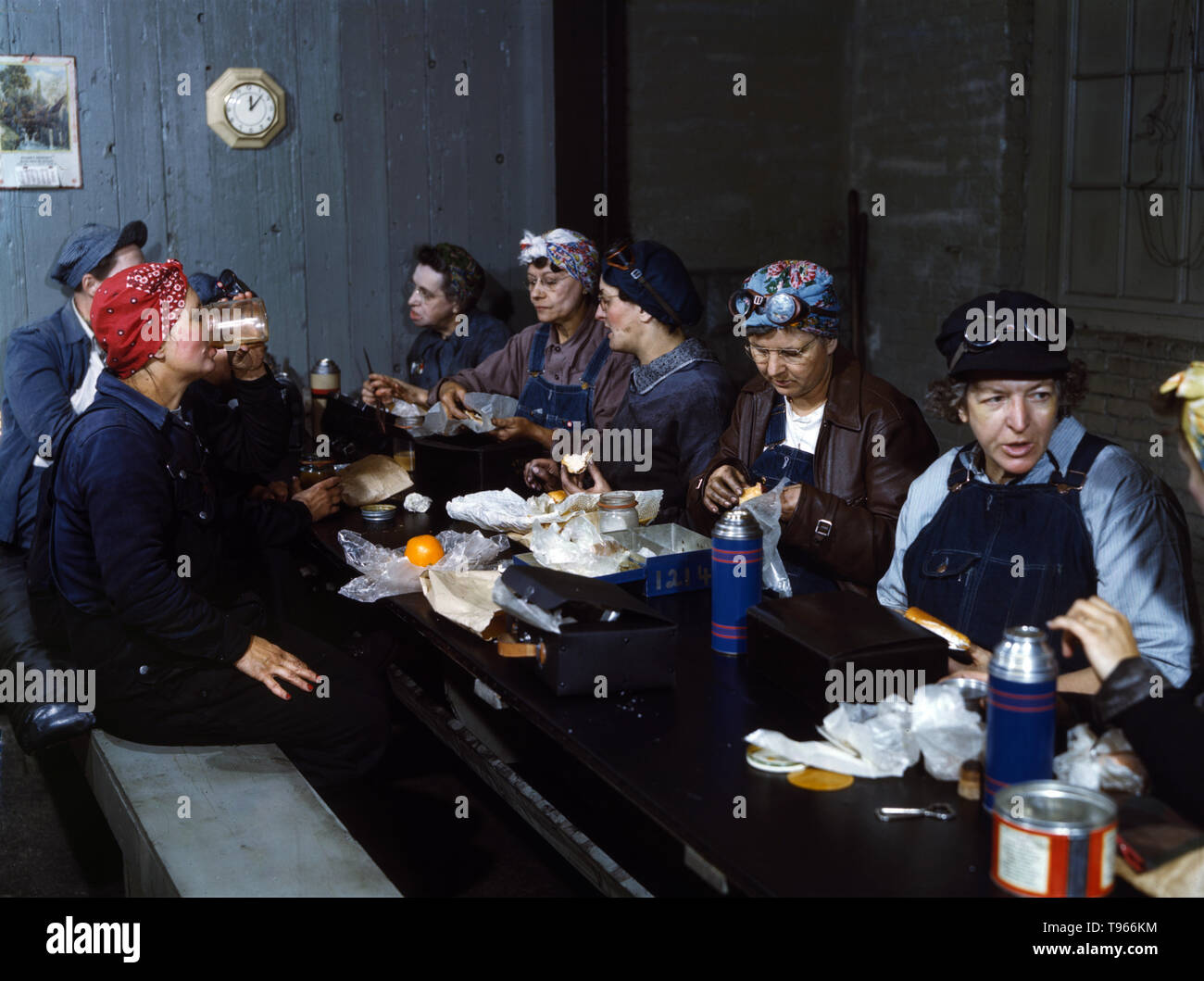 Women workers employed as wipers in the roundhouse having lunch in their rest room, C. & N.W. R.R., Clinton, Iowa. Although the image of 'Rosie the Riveter' reflected the industrial work of welders and riveters, the majority of working women filled non-factory positions in every sector of the economy. What unified the experiences of these women was that they proved to themselves, and the country, that they could do a man's job and could do it well. Photographed by Jack Delano, 1943. Stock Photohttps://www.alamy.com/image-license-details/?v=1https://www.alamy.com/women-workers-employed-as-wipers-in-the-roundhouse-having-lunch-in-their-rest-room-c-nw-rr-clinton-iowa-although-the-image-of-rosie-the-riveter-reflected-the-industrial-work-of-welders-and-riveters-the-majority-of-working-women-filled-non-factory-positions-in-every-sector-of-the-economy-what-unified-the-experiences-of-these-women-was-that-they-proved-to-themselves-and-the-country-that-they-could-do-a-mans-job-and-could-do-it-well-photographed-by-jack-delano-1943-image246614024.html
Women workers employed as wipers in the roundhouse having lunch in their rest room, C. & N.W. R.R., Clinton, Iowa. Although the image of 'Rosie the Riveter' reflected the industrial work of welders and riveters, the majority of working women filled non-factory positions in every sector of the economy. What unified the experiences of these women was that they proved to themselves, and the country, that they could do a man's job and could do it well. Photographed by Jack Delano, 1943. Stock Photohttps://www.alamy.com/image-license-details/?v=1https://www.alamy.com/women-workers-employed-as-wipers-in-the-roundhouse-having-lunch-in-their-rest-room-c-nw-rr-clinton-iowa-although-the-image-of-rosie-the-riveter-reflected-the-industrial-work-of-welders-and-riveters-the-majority-of-working-women-filled-non-factory-positions-in-every-sector-of-the-economy-what-unified-the-experiences-of-these-women-was-that-they-proved-to-themselves-and-the-country-that-they-could-do-a-mans-job-and-could-do-it-well-photographed-by-jack-delano-1943-image246614024.htmlRMT966KM–Women workers employed as wipers in the roundhouse having lunch in their rest room, C. & N.W. R.R., Clinton, Iowa. Although the image of 'Rosie the Riveter' reflected the industrial work of welders and riveters, the majority of working women filled non-factory positions in every sector of the economy. What unified the experiences of these women was that they proved to themselves, and the country, that they could do a man's job and could do it well. Photographed by Jack Delano, 1943.
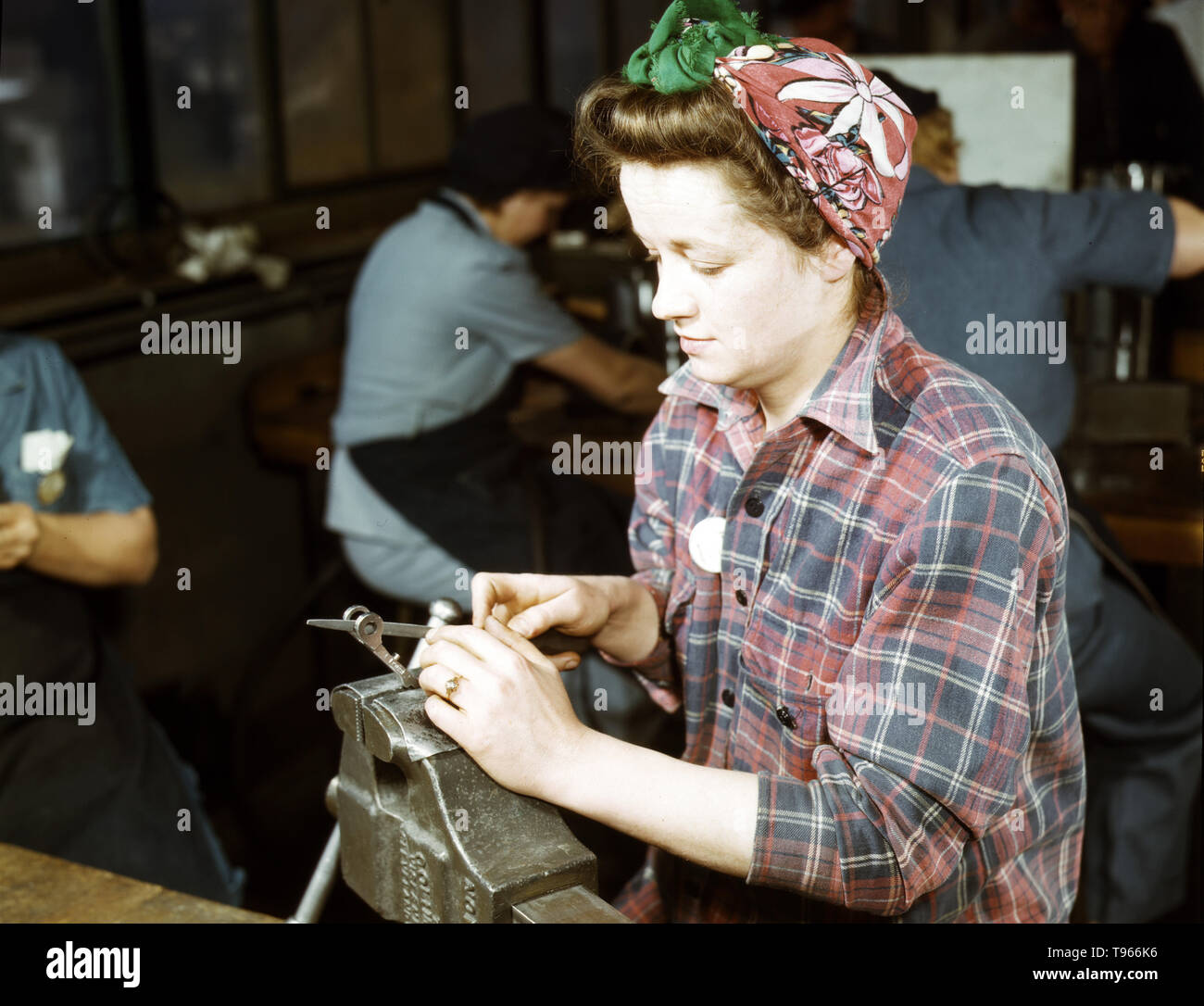 One of the girls of Vilter Manufacturing Company filing small gun parts, Milwaukee, Wisconsin. One brother in Coast Guard, one going to Army. Although the image of 'Rosie the Riveter' reflected the industrial work of welders and riveters, the majority of working women filled non-factory positions in every sector of the economy. What unified the experiences of these women was that they proved to themselves, and the country, that they could do a man's job and could do it well. Photographed by Howard R. Hollem, 1943. Stock Photohttps://www.alamy.com/image-license-details/?v=1https://www.alamy.com/one-of-the-girls-of-vilter-manufacturing-company-filing-small-gun-parts-milwaukee-wisconsin-one-brother-in-coast-guard-one-going-to-army-although-the-image-of-rosie-the-riveter-reflected-the-industrial-work-of-welders-and-riveters-the-majority-of-working-women-filled-non-factory-positions-in-every-sector-of-the-economy-what-unified-the-experiences-of-these-women-was-that-they-proved-to-themselves-and-the-country-that-they-could-do-a-mans-job-and-could-do-it-well-photographed-by-howard-r-hollem-1943-image246614010.html
One of the girls of Vilter Manufacturing Company filing small gun parts, Milwaukee, Wisconsin. One brother in Coast Guard, one going to Army. Although the image of 'Rosie the Riveter' reflected the industrial work of welders and riveters, the majority of working women filled non-factory positions in every sector of the economy. What unified the experiences of these women was that they proved to themselves, and the country, that they could do a man's job and could do it well. Photographed by Howard R. Hollem, 1943. Stock Photohttps://www.alamy.com/image-license-details/?v=1https://www.alamy.com/one-of-the-girls-of-vilter-manufacturing-company-filing-small-gun-parts-milwaukee-wisconsin-one-brother-in-coast-guard-one-going-to-army-although-the-image-of-rosie-the-riveter-reflected-the-industrial-work-of-welders-and-riveters-the-majority-of-working-women-filled-non-factory-positions-in-every-sector-of-the-economy-what-unified-the-experiences-of-these-women-was-that-they-proved-to-themselves-and-the-country-that-they-could-do-a-mans-job-and-could-do-it-well-photographed-by-howard-r-hollem-1943-image246614010.htmlRMT966K6–One of the girls of Vilter Manufacturing Company filing small gun parts, Milwaukee, Wisconsin. One brother in Coast Guard, one going to Army. Although the image of 'Rosie the Riveter' reflected the industrial work of welders and riveters, the majority of working women filled non-factory positions in every sector of the economy. What unified the experiences of these women was that they proved to themselves, and the country, that they could do a man's job and could do it well. Photographed by Howard R. Hollem, 1943.
 Part of the cowling for one of the motors for a B-25 bomber is assembled in the engine department of North American Aviation, Inc. Inglewood, California, plant. Although the image of 'Rosie the Riveter' reflected the industrial work of welders and riveters, the majority of working women filled non-factory positions in every sector of the economy. What unified the experiences of these women was that they proved to themselves, and the country, that they could do a man's job and could do it well. Photographed by Alfred T. Palmer, 1942. Stock Photohttps://www.alamy.com/image-license-details/?v=1https://www.alamy.com/part-of-the-cowling-for-one-of-the-motors-for-a-b-25-bomber-is-assembled-in-the-engine-department-of-north-american-aviation-inc-inglewood-california-plant-although-the-image-of-rosie-the-riveter-reflected-the-industrial-work-of-welders-and-riveters-the-majority-of-working-women-filled-non-factory-positions-in-every-sector-of-the-economy-what-unified-the-experiences-of-these-women-was-that-they-proved-to-themselves-and-the-country-that-they-could-do-a-mans-job-and-could-do-it-well-photographed-by-alfred-t-palmer-1942-image246614129.html
Part of the cowling for one of the motors for a B-25 bomber is assembled in the engine department of North American Aviation, Inc. Inglewood, California, plant. Although the image of 'Rosie the Riveter' reflected the industrial work of welders and riveters, the majority of working women filled non-factory positions in every sector of the economy. What unified the experiences of these women was that they proved to themselves, and the country, that they could do a man's job and could do it well. Photographed by Alfred T. Palmer, 1942. Stock Photohttps://www.alamy.com/image-license-details/?v=1https://www.alamy.com/part-of-the-cowling-for-one-of-the-motors-for-a-b-25-bomber-is-assembled-in-the-engine-department-of-north-american-aviation-inc-inglewood-california-plant-although-the-image-of-rosie-the-riveter-reflected-the-industrial-work-of-welders-and-riveters-the-majority-of-working-women-filled-non-factory-positions-in-every-sector-of-the-economy-what-unified-the-experiences-of-these-women-was-that-they-proved-to-themselves-and-the-country-that-they-could-do-a-mans-job-and-could-do-it-well-photographed-by-alfred-t-palmer-1942-image246614129.htmlRMT966RD–Part of the cowling for one of the motors for a B-25 bomber is assembled in the engine department of North American Aviation, Inc. Inglewood, California, plant. Although the image of 'Rosie the Riveter' reflected the industrial work of welders and riveters, the majority of working women filled non-factory positions in every sector of the economy. What unified the experiences of these women was that they proved to themselves, and the country, that they could do a man's job and could do it well. Photographed by Alfred T. Palmer, 1942.
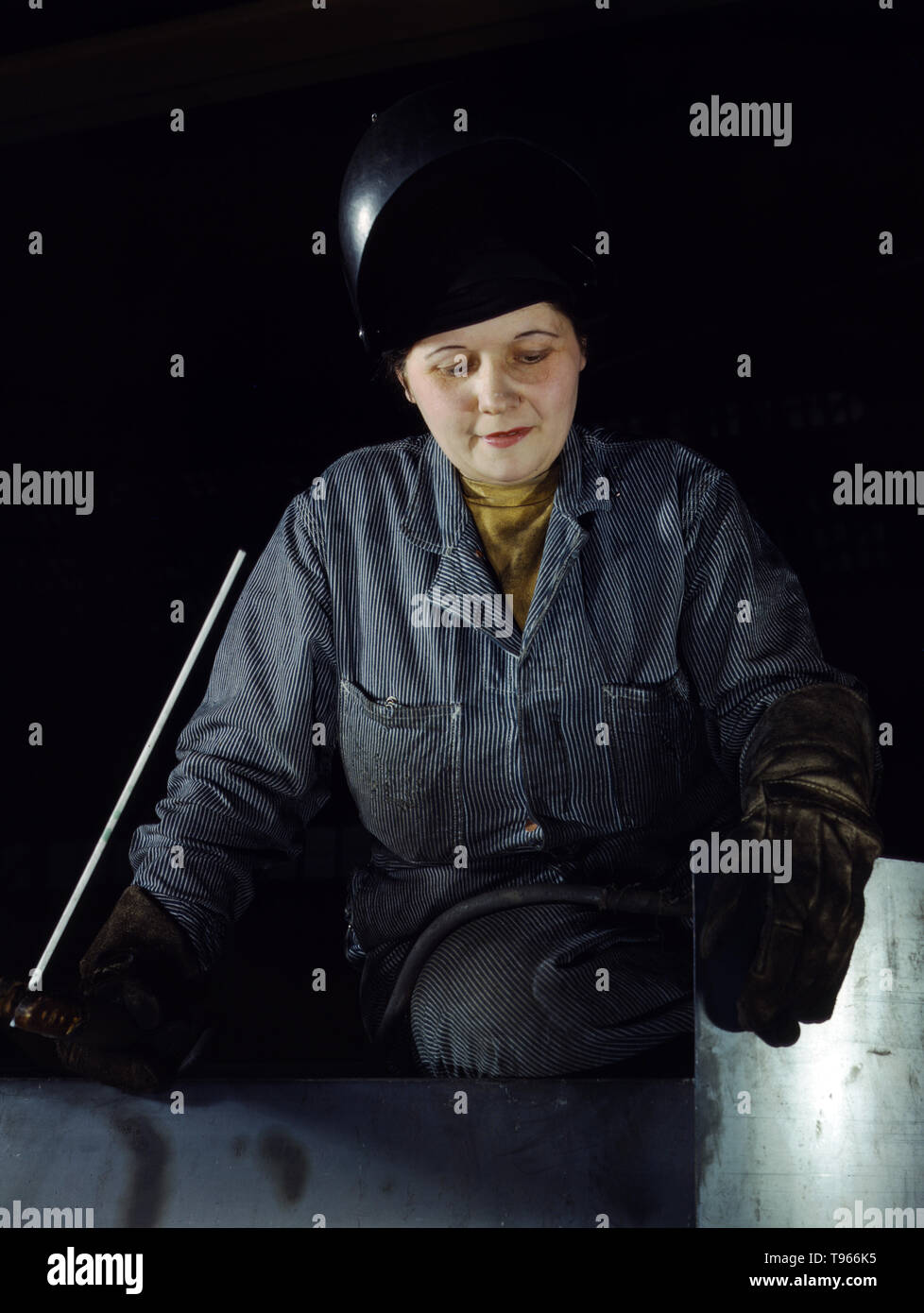 Enola O'Connell, age 32, widow and mother of one child. Ex-housewife, now she is the only woman welder at Heil and Company, Milwaukee, Wisconsin. Although the image of 'Rosie the Riveter' reflected the industrial work of welders and riveters, the majority of working women filled non-factory positions in every sector of the economy. What unified the experiences of these women was that they proved to themselves, and the country, that they could do a man's job and could do it well. Photographed by Howard R. Hollem, 1943. Stock Photohttps://www.alamy.com/image-license-details/?v=1https://www.alamy.com/enola-oconnell-age-32-widow-and-mother-of-one-child-ex-housewife-now-she-is-the-only-woman-welder-at-heil-and-company-milwaukee-wisconsin-although-the-image-of-rosie-the-riveter-reflected-the-industrial-work-of-welders-and-riveters-the-majority-of-working-women-filled-non-factory-positions-in-every-sector-of-the-economy-what-unified-the-experiences-of-these-women-was-that-they-proved-to-themselves-and-the-country-that-they-could-do-a-mans-job-and-could-do-it-well-photographed-by-howard-r-hollem-1943-image246614009.html
Enola O'Connell, age 32, widow and mother of one child. Ex-housewife, now she is the only woman welder at Heil and Company, Milwaukee, Wisconsin. Although the image of 'Rosie the Riveter' reflected the industrial work of welders and riveters, the majority of working women filled non-factory positions in every sector of the economy. What unified the experiences of these women was that they proved to themselves, and the country, that they could do a man's job and could do it well. Photographed by Howard R. Hollem, 1943. Stock Photohttps://www.alamy.com/image-license-details/?v=1https://www.alamy.com/enola-oconnell-age-32-widow-and-mother-of-one-child-ex-housewife-now-she-is-the-only-woman-welder-at-heil-and-company-milwaukee-wisconsin-although-the-image-of-rosie-the-riveter-reflected-the-industrial-work-of-welders-and-riveters-the-majority-of-working-women-filled-non-factory-positions-in-every-sector-of-the-economy-what-unified-the-experiences-of-these-women-was-that-they-proved-to-themselves-and-the-country-that-they-could-do-a-mans-job-and-could-do-it-well-photographed-by-howard-r-hollem-1943-image246614009.htmlRMT966K5–Enola O'Connell, age 32, widow and mother of one child. Ex-housewife, now she is the only woman welder at Heil and Company, Milwaukee, Wisconsin. Although the image of 'Rosie the Riveter' reflected the industrial work of welders and riveters, the majority of working women filled non-factory positions in every sector of the economy. What unified the experiences of these women was that they proved to themselves, and the country, that they could do a man's job and could do it well. Photographed by Howard R. Hollem, 1943.
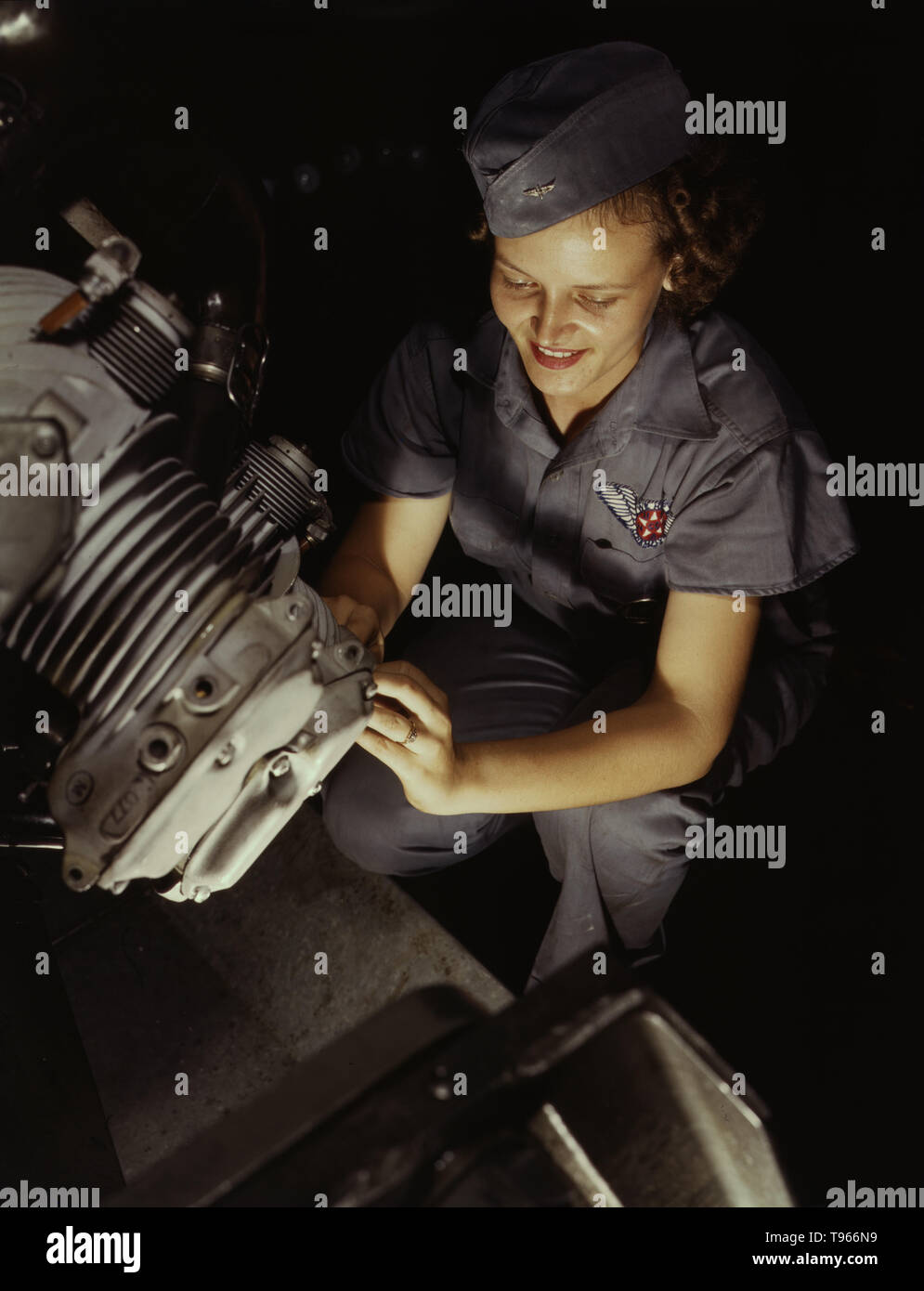 Assembly and Repairs Department mechanic Mary Josephine Farley works on a Wright Whirlwind motor, Naval Air Base, Corpus Christi, Texas. Although the image of 'Rosie the Riveter' reflected the industrial work of welders and riveters, the majority of working women filled non-factory positions in every sector of the economy. What unified the experiences of these women was that they proved to themselves, and the country, that they could do a man's job and could do it well. Photographed by Howard R. Hollem, 1942. Stock Photohttps://www.alamy.com/image-license-details/?v=1https://www.alamy.com/assembly-and-repairs-department-mechanic-mary-josephine-farley-works-on-a-wright-whirlwind-motor-naval-air-base-corpus-christi-texas-although-the-image-of-rosie-the-riveter-reflected-the-industrial-work-of-welders-and-riveters-the-majority-of-working-women-filled-non-factory-positions-in-every-sector-of-the-economy-what-unified-the-experiences-of-these-women-was-that-they-proved-to-themselves-and-the-country-that-they-could-do-a-mans-job-and-could-do-it-well-photographed-by-howard-r-hollem-1942-image246614069.html
Assembly and Repairs Department mechanic Mary Josephine Farley works on a Wright Whirlwind motor, Naval Air Base, Corpus Christi, Texas. Although the image of 'Rosie the Riveter' reflected the industrial work of welders and riveters, the majority of working women filled non-factory positions in every sector of the economy. What unified the experiences of these women was that they proved to themselves, and the country, that they could do a man's job and could do it well. Photographed by Howard R. Hollem, 1942. Stock Photohttps://www.alamy.com/image-license-details/?v=1https://www.alamy.com/assembly-and-repairs-department-mechanic-mary-josephine-farley-works-on-a-wright-whirlwind-motor-naval-air-base-corpus-christi-texas-although-the-image-of-rosie-the-riveter-reflected-the-industrial-work-of-welders-and-riveters-the-majority-of-working-women-filled-non-factory-positions-in-every-sector-of-the-economy-what-unified-the-experiences-of-these-women-was-that-they-proved-to-themselves-and-the-country-that-they-could-do-a-mans-job-and-could-do-it-well-photographed-by-howard-r-hollem-1942-image246614069.htmlRMT966N9–Assembly and Repairs Department mechanic Mary Josephine Farley works on a Wright Whirlwind motor, Naval Air Base, Corpus Christi, Texas. Although the image of 'Rosie the Riveter' reflected the industrial work of welders and riveters, the majority of working women filled non-factory positions in every sector of the economy. What unified the experiences of these women was that they proved to themselves, and the country, that they could do a man's job and could do it well. Photographed by Howard R. Hollem, 1942.
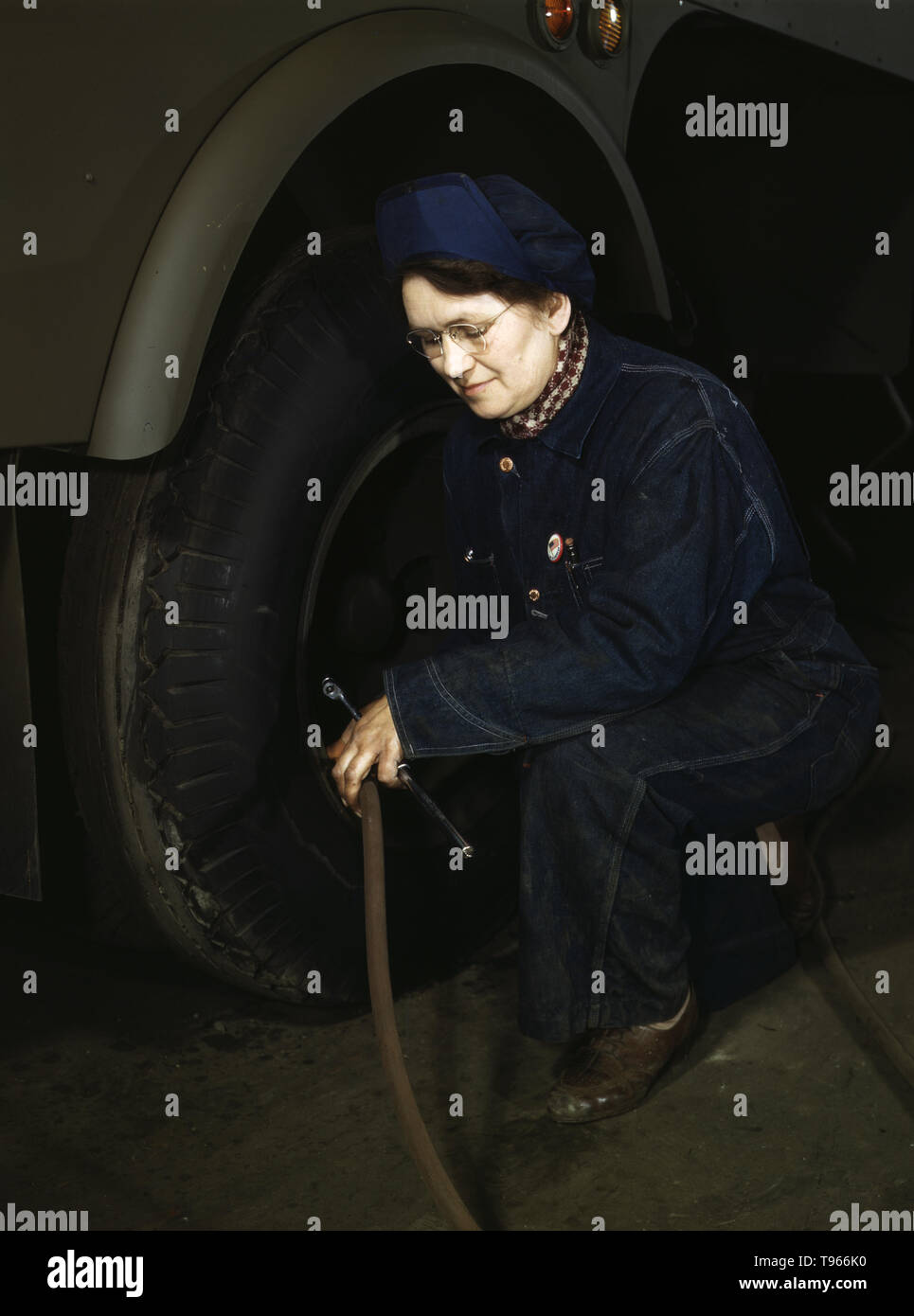 War production workers at the Heil Company making gasoline trailer tanks for the U.S. Army Air Corps, Milwaukee, Wisconsin. Mrs. Angeline Kwint, age 45, an ex-housewife, checking the tires of trailers. Her husband and son are in the U.S. Army. Although the image of 'Rosie the Riveter' reflected the industrial work of welders and riveters, the majority of working women filled non-factory positions in every sector of the economy. Photographed by Howard R. Hollem, 1943. Stock Photohttps://www.alamy.com/image-license-details/?v=1https://www.alamy.com/war-production-workers-at-the-heil-company-making-gasoline-trailer-tanks-for-the-us-army-air-corps-milwaukee-wisconsin-mrs-angeline-kwint-age-45-an-ex-housewife-checking-the-tires-of-trailers-her-husband-and-son-are-in-the-us-army-although-the-image-of-rosie-the-riveter-reflected-the-industrial-work-of-welders-and-riveters-the-majority-of-working-women-filled-non-factory-positions-in-every-sector-of-the-economy-photographed-by-howard-r-hollem-1943-image246614004.html
War production workers at the Heil Company making gasoline trailer tanks for the U.S. Army Air Corps, Milwaukee, Wisconsin. Mrs. Angeline Kwint, age 45, an ex-housewife, checking the tires of trailers. Her husband and son are in the U.S. Army. Although the image of 'Rosie the Riveter' reflected the industrial work of welders and riveters, the majority of working women filled non-factory positions in every sector of the economy. Photographed by Howard R. Hollem, 1943. Stock Photohttps://www.alamy.com/image-license-details/?v=1https://www.alamy.com/war-production-workers-at-the-heil-company-making-gasoline-trailer-tanks-for-the-us-army-air-corps-milwaukee-wisconsin-mrs-angeline-kwint-age-45-an-ex-housewife-checking-the-tires-of-trailers-her-husband-and-son-are-in-the-us-army-although-the-image-of-rosie-the-riveter-reflected-the-industrial-work-of-welders-and-riveters-the-majority-of-working-women-filled-non-factory-positions-in-every-sector-of-the-economy-photographed-by-howard-r-hollem-1943-image246614004.htmlRMT966K0–War production workers at the Heil Company making gasoline trailer tanks for the U.S. Army Air Corps, Milwaukee, Wisconsin. Mrs. Angeline Kwint, age 45, an ex-housewife, checking the tires of trailers. Her husband and son are in the U.S. Army. Although the image of 'Rosie the Riveter' reflected the industrial work of welders and riveters, the majority of working women filled non-factory positions in every sector of the economy. Photographed by Howard R. Hollem, 1943.
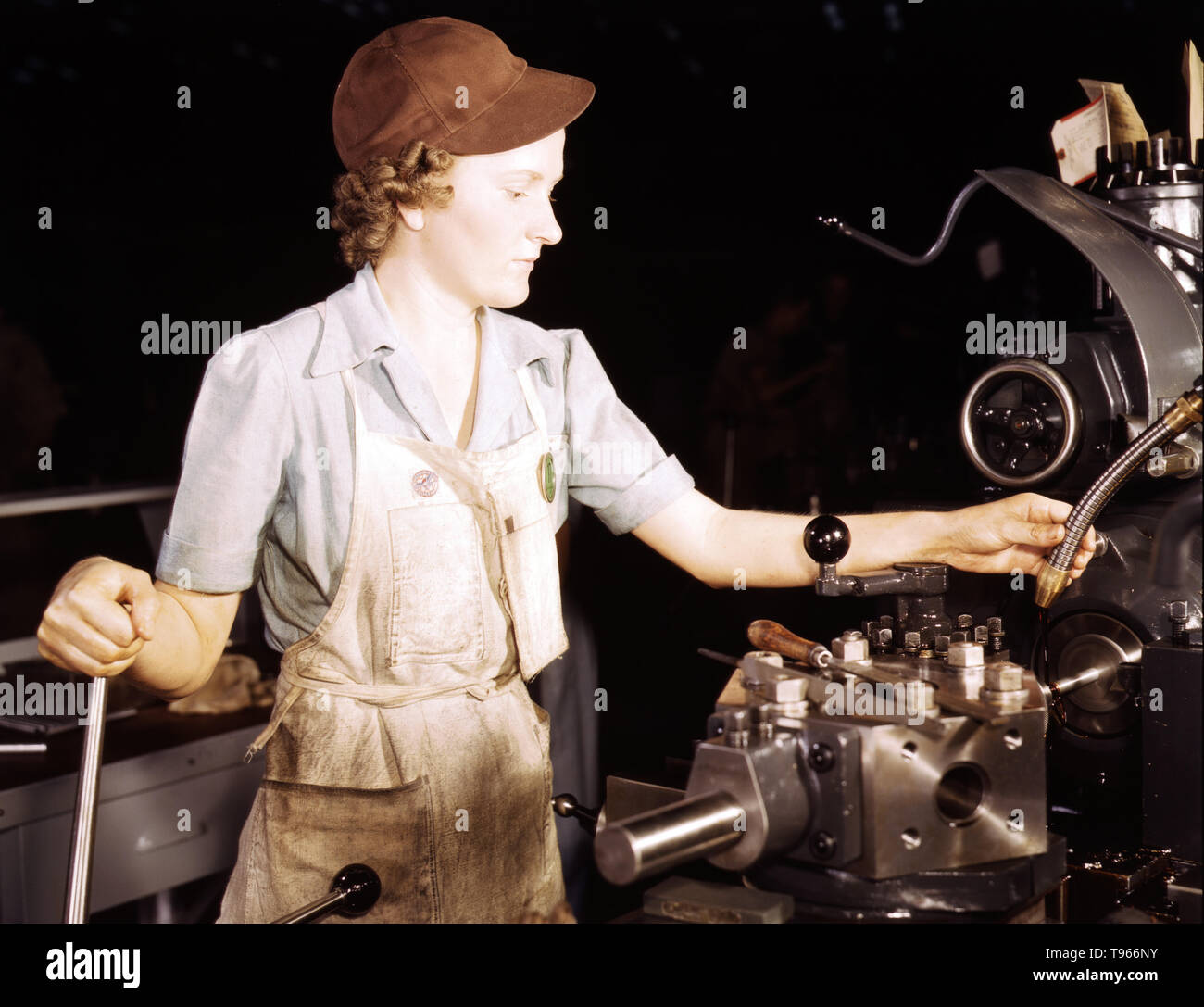 Beulah Faith, 20, used to be sales clerk in department store, reaming tools for transport on lathe machine, Consolidated Aircraft Corp., Fort Worth, Texas. Although the image of 'Rosie the Riveter' reflected the industrial work of welders and riveters, the majority of working women filled non-factory positions in every sector of the economy. What unified the experiences of these women was that they proved to themselves, and the country, that they could do a man's job and could do it well. Photographed by Howard R. Hollem, 1942. Stock Photohttps://www.alamy.com/image-license-details/?v=1https://www.alamy.com/beulah-faith-20-used-to-be-sales-clerk-in-department-store-reaming-tools-for-transport-on-lathe-machine-consolidated-aircraft-corp-fort-worth-texas-although-the-image-of-rosie-the-riveter-reflected-the-industrial-work-of-welders-and-riveters-the-majority-of-working-women-filled-non-factory-positions-in-every-sector-of-the-economy-what-unified-the-experiences-of-these-women-was-that-they-proved-to-themselves-and-the-country-that-they-could-do-a-mans-job-and-could-do-it-well-photographed-by-howard-r-hollem-1942-image246614087.html
Beulah Faith, 20, used to be sales clerk in department store, reaming tools for transport on lathe machine, Consolidated Aircraft Corp., Fort Worth, Texas. Although the image of 'Rosie the Riveter' reflected the industrial work of welders and riveters, the majority of working women filled non-factory positions in every sector of the economy. What unified the experiences of these women was that they proved to themselves, and the country, that they could do a man's job and could do it well. Photographed by Howard R. Hollem, 1942. Stock Photohttps://www.alamy.com/image-license-details/?v=1https://www.alamy.com/beulah-faith-20-used-to-be-sales-clerk-in-department-store-reaming-tools-for-transport-on-lathe-machine-consolidated-aircraft-corp-fort-worth-texas-although-the-image-of-rosie-the-riveter-reflected-the-industrial-work-of-welders-and-riveters-the-majority-of-working-women-filled-non-factory-positions-in-every-sector-of-the-economy-what-unified-the-experiences-of-these-women-was-that-they-proved-to-themselves-and-the-country-that-they-could-do-a-mans-job-and-could-do-it-well-photographed-by-howard-r-hollem-1942-image246614087.htmlRMT966NY–Beulah Faith, 20, used to be sales clerk in department store, reaming tools for transport on lathe machine, Consolidated Aircraft Corp., Fort Worth, Texas. Although the image of 'Rosie the Riveter' reflected the industrial work of welders and riveters, the majority of working women filled non-factory positions in every sector of the economy. What unified the experiences of these women was that they proved to themselves, and the country, that they could do a man's job and could do it well. Photographed by Howard R. Hollem, 1942.
 Frances Eggleston, aged 23, came from Oklahoma, used to do office work. Removing paper from pilot's window(?), Consolidated Aircraft Corp., Fort Worth, Texas. Although the image of 'Rosie the Riveter' reflected the industrial work of welders and riveters, the majority of working women filled non-factory positions in every sector of the economy. What unified the experiences of these women was that they proved to themselves, and the country, that they could do a man's job and could do it well. Photographed by Howard R. Hollem, 1942. Stock Photohttps://www.alamy.com/image-license-details/?v=1https://www.alamy.com/frances-eggleston-aged-23-came-from-oklahoma-used-to-do-office-work-removing-paper-from-pilots-window-consolidated-aircraft-corp-fort-worth-texas-although-the-image-of-rosie-the-riveter-reflected-the-industrial-work-of-welders-and-riveters-the-majority-of-working-women-filled-non-factory-positions-in-every-sector-of-the-economy-what-unified-the-experiences-of-these-women-was-that-they-proved-to-themselves-and-the-country-that-they-could-do-a-mans-job-and-could-do-it-well-photographed-by-howard-r-hollem-1942-image246614019.html
Frances Eggleston, aged 23, came from Oklahoma, used to do office work. Removing paper from pilot's window(?), Consolidated Aircraft Corp., Fort Worth, Texas. Although the image of 'Rosie the Riveter' reflected the industrial work of welders and riveters, the majority of working women filled non-factory positions in every sector of the economy. What unified the experiences of these women was that they proved to themselves, and the country, that they could do a man's job and could do it well. Photographed by Howard R. Hollem, 1942. Stock Photohttps://www.alamy.com/image-license-details/?v=1https://www.alamy.com/frances-eggleston-aged-23-came-from-oklahoma-used-to-do-office-work-removing-paper-from-pilots-window-consolidated-aircraft-corp-fort-worth-texas-although-the-image-of-rosie-the-riveter-reflected-the-industrial-work-of-welders-and-riveters-the-majority-of-working-women-filled-non-factory-positions-in-every-sector-of-the-economy-what-unified-the-experiences-of-these-women-was-that-they-proved-to-themselves-and-the-country-that-they-could-do-a-mans-job-and-could-do-it-well-photographed-by-howard-r-hollem-1942-image246614019.htmlRMT966KF–Frances Eggleston, aged 23, came from Oklahoma, used to do office work. Removing paper from pilot's window(?), Consolidated Aircraft Corp., Fort Worth, Texas. Although the image of 'Rosie the Riveter' reflected the industrial work of welders and riveters, the majority of working women filled non-factory positions in every sector of the economy. What unified the experiences of these women was that they proved to themselves, and the country, that they could do a man's job and could do it well. Photographed by Howard R. Hollem, 1942.
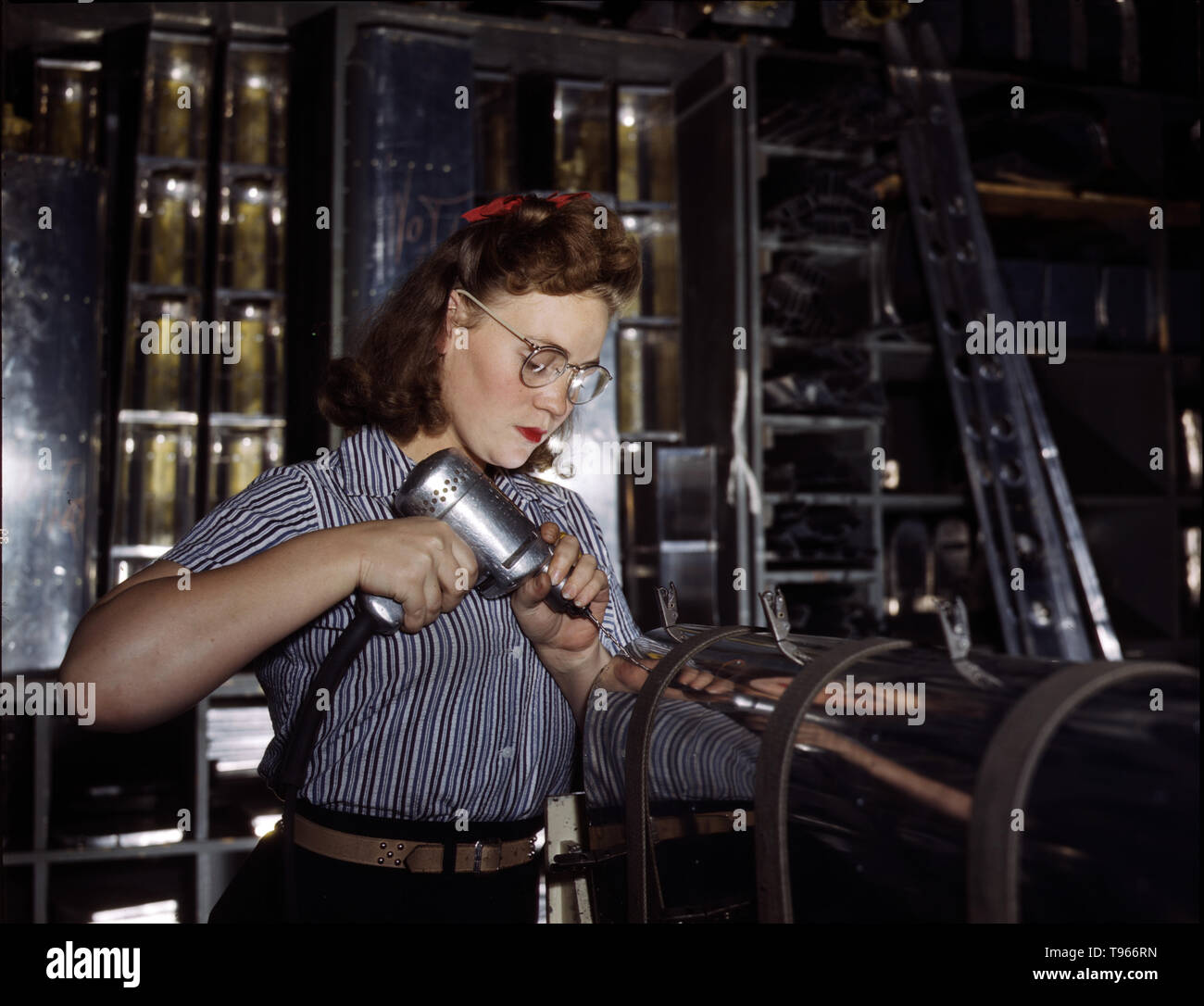 Operating a hand drill at the North American Aviation, Inc., a woman is in the control surface department assembling a section of the leading edge for the horizontal stabilizer of a plane. Although the image of 'Rosie the Riveter' reflected the industrial work of welders and riveters, the majority of working women filled non-factory positions in every sector of the economy. What unified the experiences of these women was that they proved to themselves, and the country, that they could do a man's job and could do it well. Photographed by Alfred T. Palmer, 1942. Stock Photohttps://www.alamy.com/image-license-details/?v=1https://www.alamy.com/operating-a-hand-drill-at-the-north-american-aviation-inc-a-woman-is-in-the-control-surface-department-assembling-a-section-of-the-leading-edge-for-the-horizontal-stabilizer-of-a-plane-although-the-image-of-rosie-the-riveter-reflected-the-industrial-work-of-welders-and-riveters-the-majority-of-working-women-filled-non-factory-positions-in-every-sector-of-the-economy-what-unified-the-experiences-of-these-women-was-that-they-proved-to-themselves-and-the-country-that-they-could-do-a-mans-job-and-could-do-it-well-photographed-by-alfred-t-palmer-1942-image246614137.html
Operating a hand drill at the North American Aviation, Inc., a woman is in the control surface department assembling a section of the leading edge for the horizontal stabilizer of a plane. Although the image of 'Rosie the Riveter' reflected the industrial work of welders and riveters, the majority of working women filled non-factory positions in every sector of the economy. What unified the experiences of these women was that they proved to themselves, and the country, that they could do a man's job and could do it well. Photographed by Alfred T. Palmer, 1942. Stock Photohttps://www.alamy.com/image-license-details/?v=1https://www.alamy.com/operating-a-hand-drill-at-the-north-american-aviation-inc-a-woman-is-in-the-control-surface-department-assembling-a-section-of-the-leading-edge-for-the-horizontal-stabilizer-of-a-plane-although-the-image-of-rosie-the-riveter-reflected-the-industrial-work-of-welders-and-riveters-the-majority-of-working-women-filled-non-factory-positions-in-every-sector-of-the-economy-what-unified-the-experiences-of-these-women-was-that-they-proved-to-themselves-and-the-country-that-they-could-do-a-mans-job-and-could-do-it-well-photographed-by-alfred-t-palmer-1942-image246614137.htmlRMT966RN–Operating a hand drill at the North American Aviation, Inc., a woman is in the control surface department assembling a section of the leading edge for the horizontal stabilizer of a plane. Although the image of 'Rosie the Riveter' reflected the industrial work of welders and riveters, the majority of working women filled non-factory positions in every sector of the economy. What unified the experiences of these women was that they proved to themselves, and the country, that they could do a man's job and could do it well. Photographed by Alfred T. Palmer, 1942.
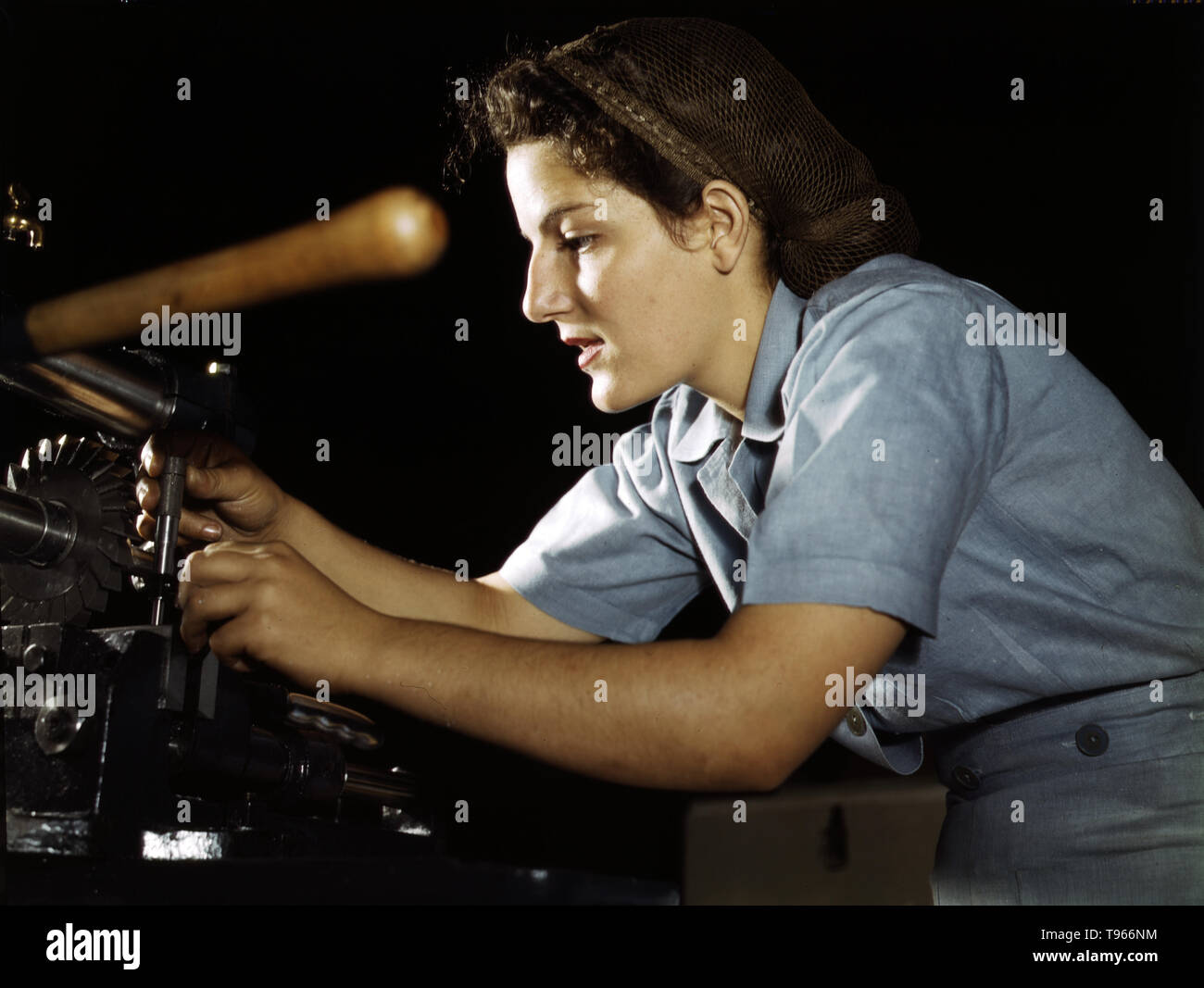 Mary Louise Stepan, 21, used to be a waitress. She has a brother in the air corps. She is working on transport parts in the hand mill, Consolidated Aircraft Corp., Fort Worth, Texas. Although the image of 'Rosie the Riveter' reflected the industrial work of welders and riveters, the majority of working women filled non-factory positions in every sector of the economy. What unified the experiences of these women was that they proved to themselves, and the country, that they could do a man's job and could do it well. Photographed by Howard R. Hollem, 1942. Stock Photohttps://www.alamy.com/image-license-details/?v=1https://www.alamy.com/mary-louise-stepan-21-used-to-be-a-waitress-she-has-a-brother-in-the-air-corps-she-is-working-on-transport-parts-in-the-hand-mill-consolidated-aircraft-corp-fort-worth-texas-although-the-image-of-rosie-the-riveter-reflected-the-industrial-work-of-welders-and-riveters-the-majority-of-working-women-filled-non-factory-positions-in-every-sector-of-the-economy-what-unified-the-experiences-of-these-women-was-that-they-proved-to-themselves-and-the-country-that-they-could-do-a-mans-job-and-could-do-it-well-photographed-by-howard-r-hollem-1942-image246614080.html
Mary Louise Stepan, 21, used to be a waitress. She has a brother in the air corps. She is working on transport parts in the hand mill, Consolidated Aircraft Corp., Fort Worth, Texas. Although the image of 'Rosie the Riveter' reflected the industrial work of welders and riveters, the majority of working women filled non-factory positions in every sector of the economy. What unified the experiences of these women was that they proved to themselves, and the country, that they could do a man's job and could do it well. Photographed by Howard R. Hollem, 1942. Stock Photohttps://www.alamy.com/image-license-details/?v=1https://www.alamy.com/mary-louise-stepan-21-used-to-be-a-waitress-she-has-a-brother-in-the-air-corps-she-is-working-on-transport-parts-in-the-hand-mill-consolidated-aircraft-corp-fort-worth-texas-although-the-image-of-rosie-the-riveter-reflected-the-industrial-work-of-welders-and-riveters-the-majority-of-working-women-filled-non-factory-positions-in-every-sector-of-the-economy-what-unified-the-experiences-of-these-women-was-that-they-proved-to-themselves-and-the-country-that-they-could-do-a-mans-job-and-could-do-it-well-photographed-by-howard-r-hollem-1942-image246614080.htmlRMT966NM–Mary Louise Stepan, 21, used to be a waitress. She has a brother in the air corps. She is working on transport parts in the hand mill, Consolidated Aircraft Corp., Fort Worth, Texas. Although the image of 'Rosie the Riveter' reflected the industrial work of welders and riveters, the majority of working women filled non-factory positions in every sector of the economy. What unified the experiences of these women was that they proved to themselves, and the country, that they could do a man's job and could do it well. Photographed by Howard R. Hollem, 1942.
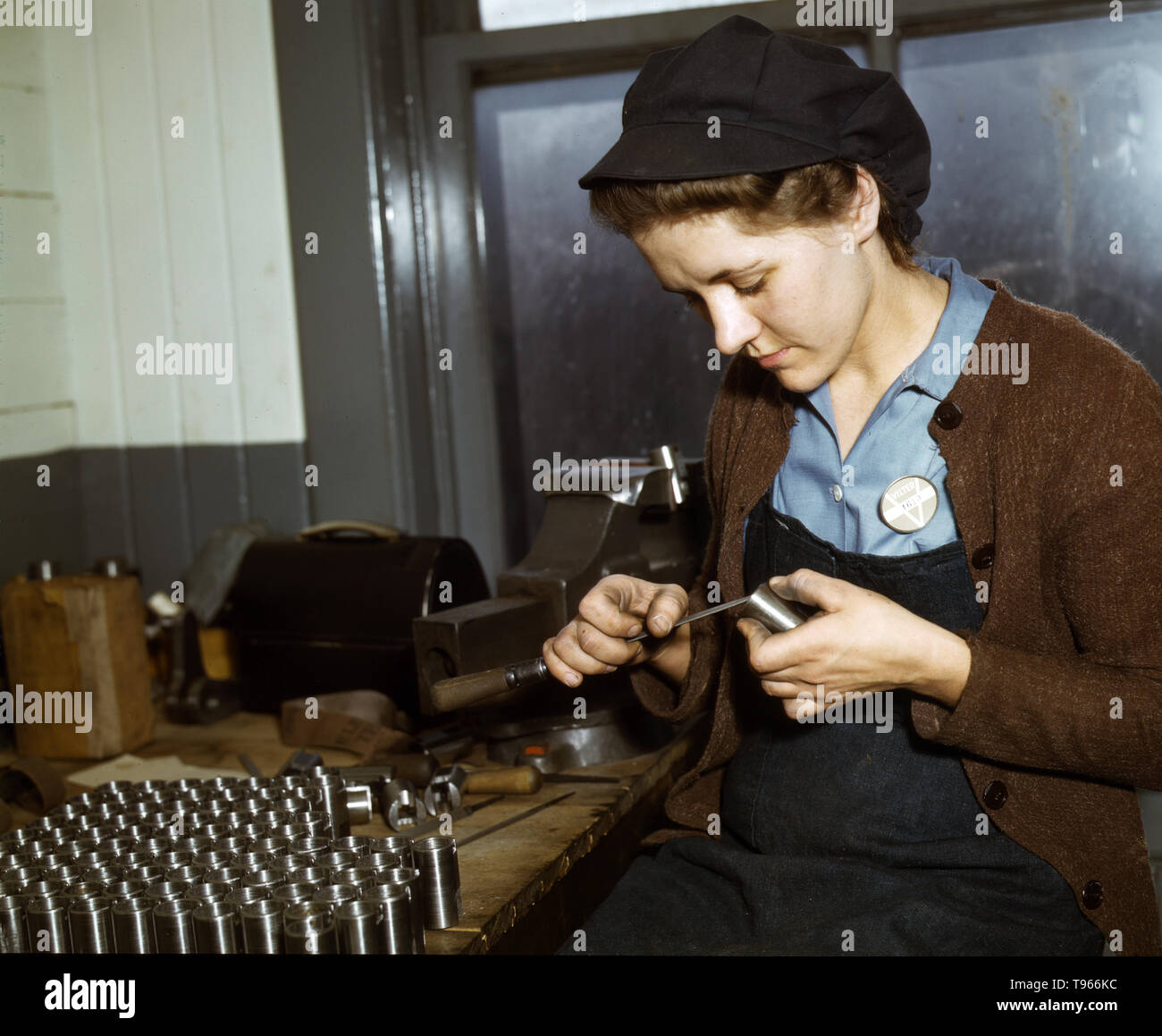 War production workers at the Vilter Manufacturing Company making M5 and M7 guns for the U.S. Army, Milwaukee, Wisconsin. Ex-housewife, age 24, filing small parts. Her husband and brother are in the armed service. Although the image of 'Rosie the Riveter' reflected the industrial work of welders and riveters, the majority of working women filled non-factory positions in every sector of the economy. What unified the experiences of these women was that they proved to themselves, and the country, that they could do a man's job and could do it well. Photographed by Howard R. Hollem, 1943. Stock Photohttps://www.alamy.com/image-license-details/?v=1https://www.alamy.com/war-production-workers-at-the-vilter-manufacturing-company-making-m5-and-m7-guns-for-the-us-army-milwaukee-wisconsin-ex-housewife-age-24-filing-small-parts-her-husband-and-brother-are-in-the-armed-service-although-the-image-of-rosie-the-riveter-reflected-the-industrial-work-of-welders-and-riveters-the-majority-of-working-women-filled-non-factory-positions-in-every-sector-of-the-economy-what-unified-the-experiences-of-these-women-was-that-they-proved-to-themselves-and-the-country-that-they-could-do-a-mans-job-and-could-do-it-well-photographed-by-howard-r-hollem-1943-image246614016.html
War production workers at the Vilter Manufacturing Company making M5 and M7 guns for the U.S. Army, Milwaukee, Wisconsin. Ex-housewife, age 24, filing small parts. Her husband and brother are in the armed service. Although the image of 'Rosie the Riveter' reflected the industrial work of welders and riveters, the majority of working women filled non-factory positions in every sector of the economy. What unified the experiences of these women was that they proved to themselves, and the country, that they could do a man's job and could do it well. Photographed by Howard R. Hollem, 1943. Stock Photohttps://www.alamy.com/image-license-details/?v=1https://www.alamy.com/war-production-workers-at-the-vilter-manufacturing-company-making-m5-and-m7-guns-for-the-us-army-milwaukee-wisconsin-ex-housewife-age-24-filing-small-parts-her-husband-and-brother-are-in-the-armed-service-although-the-image-of-rosie-the-riveter-reflected-the-industrial-work-of-welders-and-riveters-the-majority-of-working-women-filled-non-factory-positions-in-every-sector-of-the-economy-what-unified-the-experiences-of-these-women-was-that-they-proved-to-themselves-and-the-country-that-they-could-do-a-mans-job-and-could-do-it-well-photographed-by-howard-r-hollem-1943-image246614016.htmlRMT966KC–War production workers at the Vilter Manufacturing Company making M5 and M7 guns for the U.S. Army, Milwaukee, Wisconsin. Ex-housewife, age 24, filing small parts. Her husband and brother are in the armed service. Although the image of 'Rosie the Riveter' reflected the industrial work of welders and riveters, the majority of working women filled non-factory positions in every sector of the economy. What unified the experiences of these women was that they proved to themselves, and the country, that they could do a man's job and could do it well. Photographed by Howard R. Hollem, 1943.
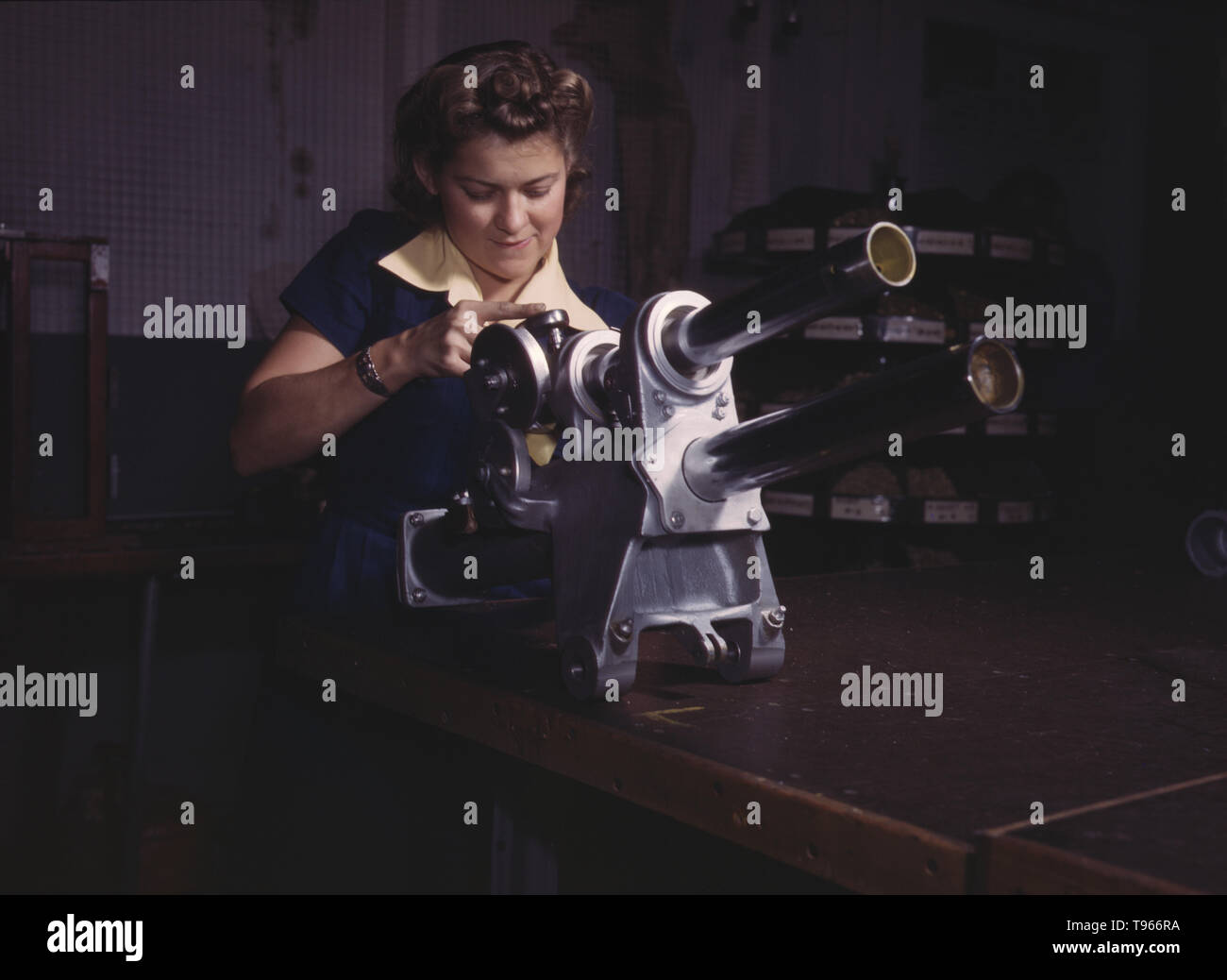 A young woman employee of North American Aviation, Incorporated, working over the landing gear mechanism of a P-51 fighter plane, Inglewood, California. The mechanism resembles a small cannon. Although the image of 'Rosie the Riveter' reflected the industrial work of welders and riveters, the majority of working women filled non-factory positions in every sector of the economy. What unified the experiences of these women was that they proved to themselves, and the country, that they could do a man's job and could do it well. Photographed by Alfred T. Palmer, 1942. Stock Photohttps://www.alamy.com/image-license-details/?v=1https://www.alamy.com/a-young-woman-employee-of-north-american-aviation-incorporated-working-over-the-landing-gear-mechanism-of-a-p-51-fighter-plane-inglewood-california-the-mechanism-resembles-a-small-cannon-although-the-image-of-rosie-the-riveter-reflected-the-industrial-work-of-welders-and-riveters-the-majority-of-working-women-filled-non-factory-positions-in-every-sector-of-the-economy-what-unified-the-experiences-of-these-women-was-that-they-proved-to-themselves-and-the-country-that-they-could-do-a-mans-job-and-could-do-it-well-photographed-by-alfred-t-palmer-1942-image246614126.html
A young woman employee of North American Aviation, Incorporated, working over the landing gear mechanism of a P-51 fighter plane, Inglewood, California. The mechanism resembles a small cannon. Although the image of 'Rosie the Riveter' reflected the industrial work of welders and riveters, the majority of working women filled non-factory positions in every sector of the economy. What unified the experiences of these women was that they proved to themselves, and the country, that they could do a man's job and could do it well. Photographed by Alfred T. Palmer, 1942. Stock Photohttps://www.alamy.com/image-license-details/?v=1https://www.alamy.com/a-young-woman-employee-of-north-american-aviation-incorporated-working-over-the-landing-gear-mechanism-of-a-p-51-fighter-plane-inglewood-california-the-mechanism-resembles-a-small-cannon-although-the-image-of-rosie-the-riveter-reflected-the-industrial-work-of-welders-and-riveters-the-majority-of-working-women-filled-non-factory-positions-in-every-sector-of-the-economy-what-unified-the-experiences-of-these-women-was-that-they-proved-to-themselves-and-the-country-that-they-could-do-a-mans-job-and-could-do-it-well-photographed-by-alfred-t-palmer-1942-image246614126.htmlRMT966RA–A young woman employee of North American Aviation, Incorporated, working over the landing gear mechanism of a P-51 fighter plane, Inglewood, California. The mechanism resembles a small cannon. Although the image of 'Rosie the Riveter' reflected the industrial work of welders and riveters, the majority of working women filled non-factory positions in every sector of the economy. What unified the experiences of these women was that they proved to themselves, and the country, that they could do a man's job and could do it well. Photographed by Alfred T. Palmer, 1942.
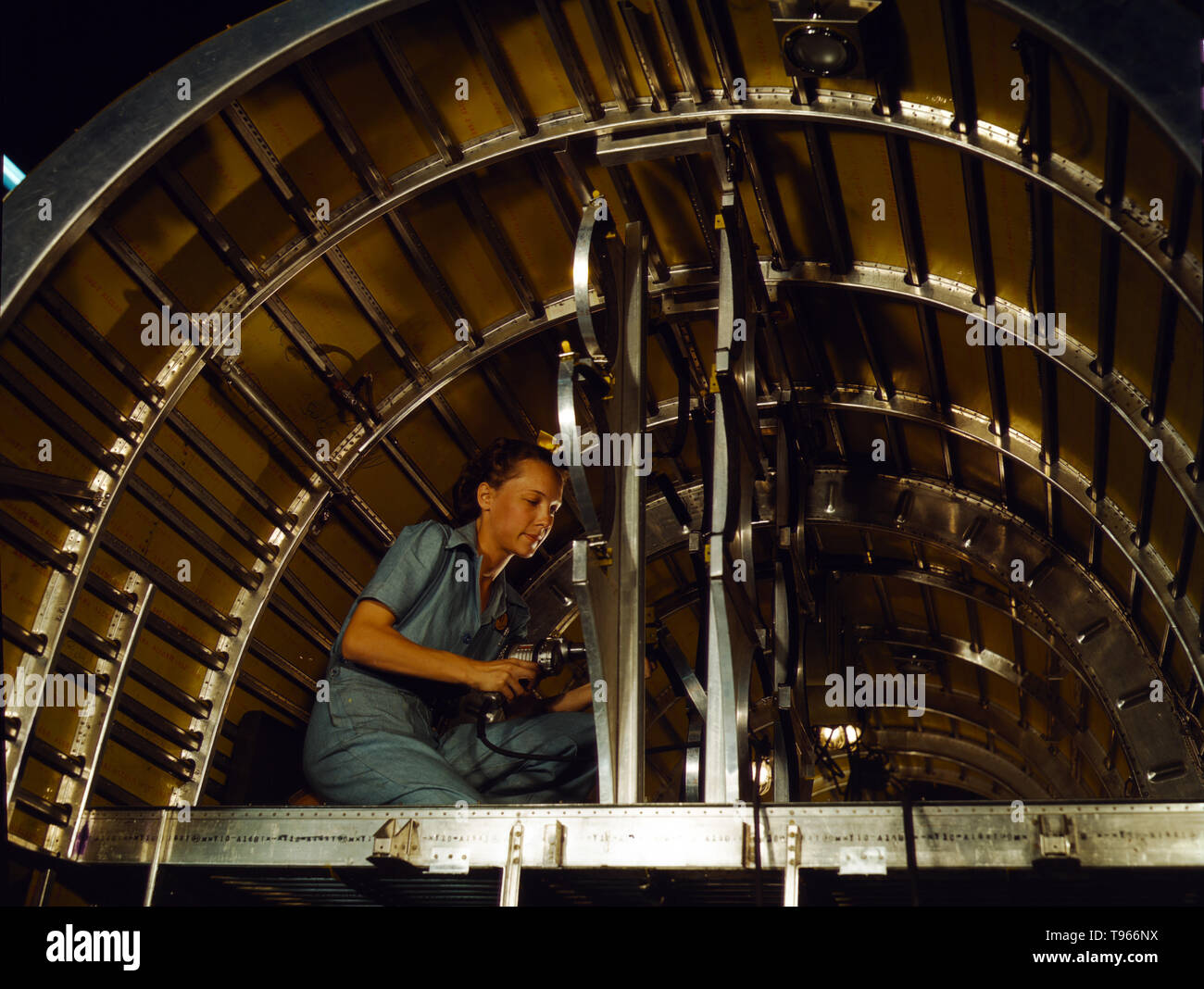 Production of B-24 bombers and C-87 transports, Consolidated Aircraft Corp., Fort Worth, Texas. Cabbie Coleman, former housewife, works at western aircraft plant. Installing of oxygen racks above the flight deck. Although the image of 'Rosie the Riveter' reflected the industrial work of welders and riveters, the majority of working women filled non-factory positions in every sector of the economy. What unified the experiences of these women was that they proved to themselves, and the country, that they could do a man's job and could do it well. Photographed by Howard R. Hollem, 1942. Stock Photohttps://www.alamy.com/image-license-details/?v=1https://www.alamy.com/production-of-b-24-bombers-and-c-87-transports-consolidated-aircraft-corp-fort-worth-texas-cabbie-coleman-former-housewife-works-at-western-aircraft-plant-installing-of-oxygen-racks-above-the-flight-deck-although-the-image-of-rosie-the-riveter-reflected-the-industrial-work-of-welders-and-riveters-the-majority-of-working-women-filled-non-factory-positions-in-every-sector-of-the-economy-what-unified-the-experiences-of-these-women-was-that-they-proved-to-themselves-and-the-country-that-they-could-do-a-mans-job-and-could-do-it-well-photographed-by-howard-r-hollem-1942-image246614086.html
Production of B-24 bombers and C-87 transports, Consolidated Aircraft Corp., Fort Worth, Texas. Cabbie Coleman, former housewife, works at western aircraft plant. Installing of oxygen racks above the flight deck. Although the image of 'Rosie the Riveter' reflected the industrial work of welders and riveters, the majority of working women filled non-factory positions in every sector of the economy. What unified the experiences of these women was that they proved to themselves, and the country, that they could do a man's job and could do it well. Photographed by Howard R. Hollem, 1942. Stock Photohttps://www.alamy.com/image-license-details/?v=1https://www.alamy.com/production-of-b-24-bombers-and-c-87-transports-consolidated-aircraft-corp-fort-worth-texas-cabbie-coleman-former-housewife-works-at-western-aircraft-plant-installing-of-oxygen-racks-above-the-flight-deck-although-the-image-of-rosie-the-riveter-reflected-the-industrial-work-of-welders-and-riveters-the-majority-of-working-women-filled-non-factory-positions-in-every-sector-of-the-economy-what-unified-the-experiences-of-these-women-was-that-they-proved-to-themselves-and-the-country-that-they-could-do-a-mans-job-and-could-do-it-well-photographed-by-howard-r-hollem-1942-image246614086.htmlRMT966NX–Production of B-24 bombers and C-87 transports, Consolidated Aircraft Corp., Fort Worth, Texas. Cabbie Coleman, former housewife, works at western aircraft plant. Installing of oxygen racks above the flight deck. Although the image of 'Rosie the Riveter' reflected the industrial work of welders and riveters, the majority of working women filled non-factory positions in every sector of the economy. What unified the experiences of these women was that they proved to themselves, and the country, that they could do a man's job and could do it well. Photographed by Howard R. Hollem, 1942.
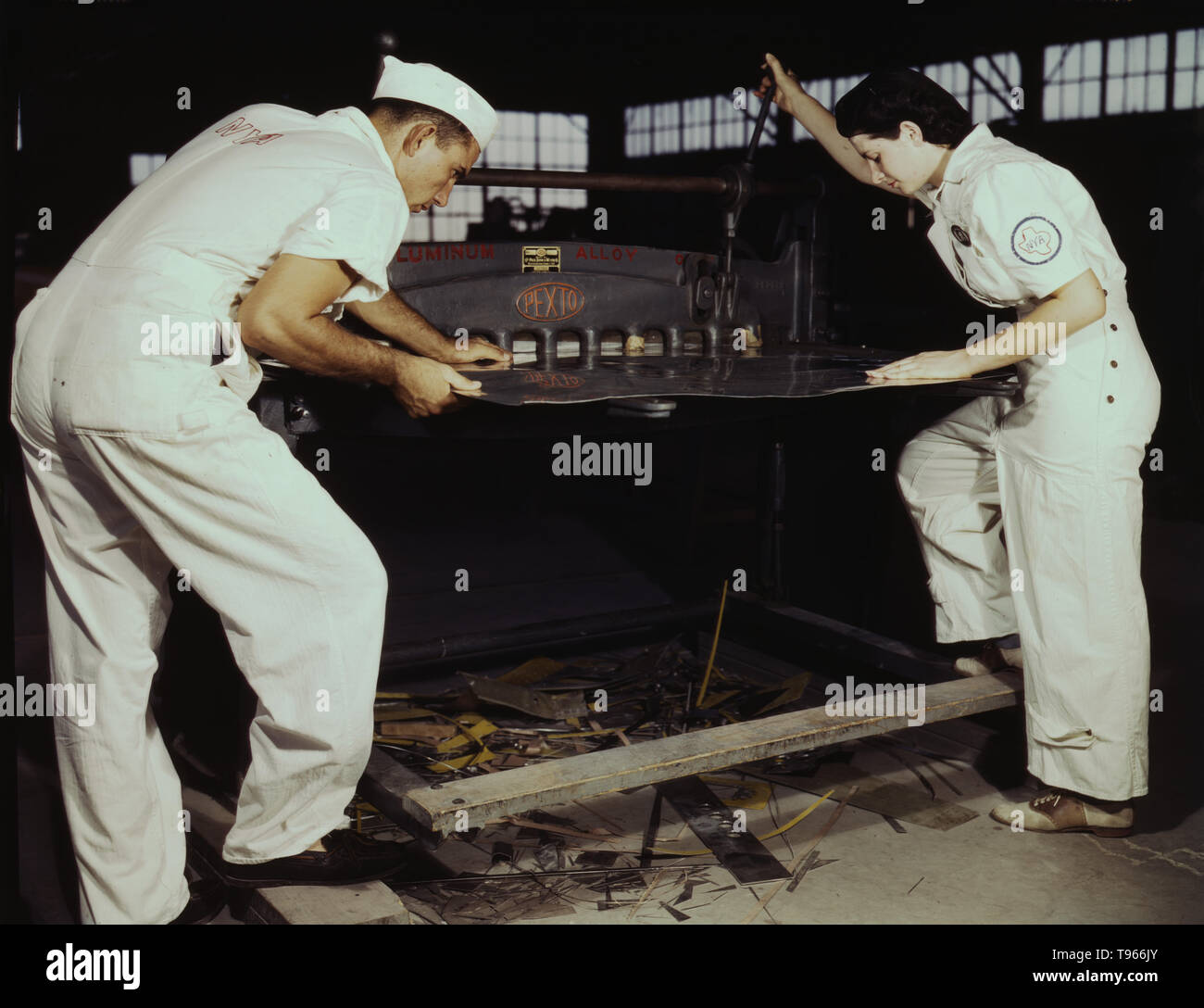 Learning to work a cutting machine, these two NYA employees receive training to fit them for important work, Corpus Christi, Texas. After eight weeks they will be eligible for civil service jobs at the Naval Air Base. Although the image of 'Rosie the Riveter' reflected the industrial work of welders and riveters, the majority of working women filled non-factory positions in every sector of the economy. What unified the experiences of these women was that they proved to themselves, and the country, that they could do a man's job and could do it well. Photographed by Howard R. Hollem, 1942. Stock Photohttps://www.alamy.com/image-license-details/?v=1https://www.alamy.com/learning-to-work-a-cutting-machine-these-two-nya-employees-receive-training-to-fit-them-for-important-work-corpus-christi-texas-after-eight-weeks-they-will-be-eligible-for-civil-service-jobs-at-the-naval-air-base-although-the-image-of-rosie-the-riveter-reflected-the-industrial-work-of-welders-and-riveters-the-majority-of-working-women-filled-non-factory-positions-in-every-sector-of-the-economy-what-unified-the-experiences-of-these-women-was-that-they-proved-to-themselves-and-the-country-that-they-could-do-a-mans-job-and-could-do-it-well-photographed-by-howard-r-hollem-1942-image246614003.html
Learning to work a cutting machine, these two NYA employees receive training to fit them for important work, Corpus Christi, Texas. After eight weeks they will be eligible for civil service jobs at the Naval Air Base. Although the image of 'Rosie the Riveter' reflected the industrial work of welders and riveters, the majority of working women filled non-factory positions in every sector of the economy. What unified the experiences of these women was that they proved to themselves, and the country, that they could do a man's job and could do it well. Photographed by Howard R. Hollem, 1942. Stock Photohttps://www.alamy.com/image-license-details/?v=1https://www.alamy.com/learning-to-work-a-cutting-machine-these-two-nya-employees-receive-training-to-fit-them-for-important-work-corpus-christi-texas-after-eight-weeks-they-will-be-eligible-for-civil-service-jobs-at-the-naval-air-base-although-the-image-of-rosie-the-riveter-reflected-the-industrial-work-of-welders-and-riveters-the-majority-of-working-women-filled-non-factory-positions-in-every-sector-of-the-economy-what-unified-the-experiences-of-these-women-was-that-they-proved-to-themselves-and-the-country-that-they-could-do-a-mans-job-and-could-do-it-well-photographed-by-howard-r-hollem-1942-image246614003.htmlRMT966JY–Learning to work a cutting machine, these two NYA employees receive training to fit them for important work, Corpus Christi, Texas. After eight weeks they will be eligible for civil service jobs at the Naval Air Base. Although the image of 'Rosie the Riveter' reflected the industrial work of welders and riveters, the majority of working women filled non-factory positions in every sector of the economy. What unified the experiences of these women was that they proved to themselves, and the country, that they could do a man's job and could do it well. Photographed by Howard R. Hollem, 1942.
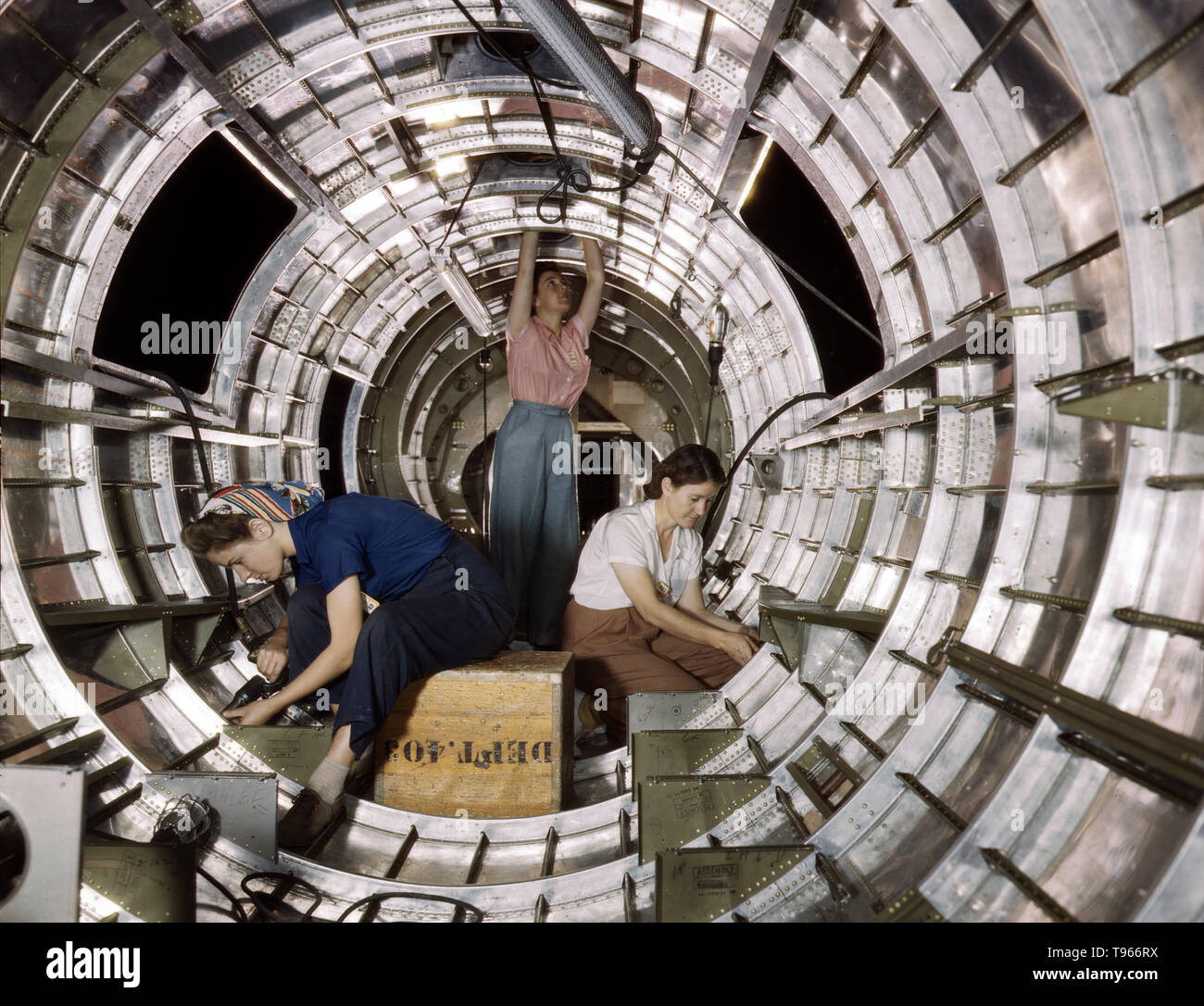 Women workers install fixtures and assemblies to a tail fuselage section of a B-17F 'Flying Fortress' bomber at the Douglas Aircraft Company, Long Beach, Calif. It is a long range, high altitude heavy bomber, with a crew of seven to nine men, and with armament sufficient to defend itself on daylight missions. Although the image of 'Rosie the Riveter' reflected the industrial work of welders and riveters, the majority of working women filled non-factory positions in every sector of the economy. Stock Photohttps://www.alamy.com/image-license-details/?v=1https://www.alamy.com/women-workers-install-fixtures-and-assemblies-to-a-tail-fuselage-section-of-a-b-17f-flying-fortress-bomber-at-the-douglas-aircraft-company-long-beach-calif-it-is-a-long-range-high-altitude-heavy-bomber-with-a-crew-of-seven-to-nine-men-and-with-armament-sufficient-to-defend-itself-on-daylight-missions-although-the-image-of-rosie-the-riveter-reflected-the-industrial-work-of-welders-and-riveters-the-majority-of-working-women-filled-non-factory-positions-in-every-sector-of-the-economy-image246614142.html
Women workers install fixtures and assemblies to a tail fuselage section of a B-17F 'Flying Fortress' bomber at the Douglas Aircraft Company, Long Beach, Calif. It is a long range, high altitude heavy bomber, with a crew of seven to nine men, and with armament sufficient to defend itself on daylight missions. Although the image of 'Rosie the Riveter' reflected the industrial work of welders and riveters, the majority of working women filled non-factory positions in every sector of the economy. Stock Photohttps://www.alamy.com/image-license-details/?v=1https://www.alamy.com/women-workers-install-fixtures-and-assemblies-to-a-tail-fuselage-section-of-a-b-17f-flying-fortress-bomber-at-the-douglas-aircraft-company-long-beach-calif-it-is-a-long-range-high-altitude-heavy-bomber-with-a-crew-of-seven-to-nine-men-and-with-armament-sufficient-to-defend-itself-on-daylight-missions-although-the-image-of-rosie-the-riveter-reflected-the-industrial-work-of-welders-and-riveters-the-majority-of-working-women-filled-non-factory-positions-in-every-sector-of-the-economy-image246614142.htmlRMT966RX–Women workers install fixtures and assemblies to a tail fuselage section of a B-17F 'Flying Fortress' bomber at the Douglas Aircraft Company, Long Beach, Calif. It is a long range, high altitude heavy bomber, with a crew of seven to nine men, and with armament sufficient to defend itself on daylight missions. Although the image of 'Rosie the Riveter' reflected the industrial work of welders and riveters, the majority of working women filled non-factory positions in every sector of the economy.
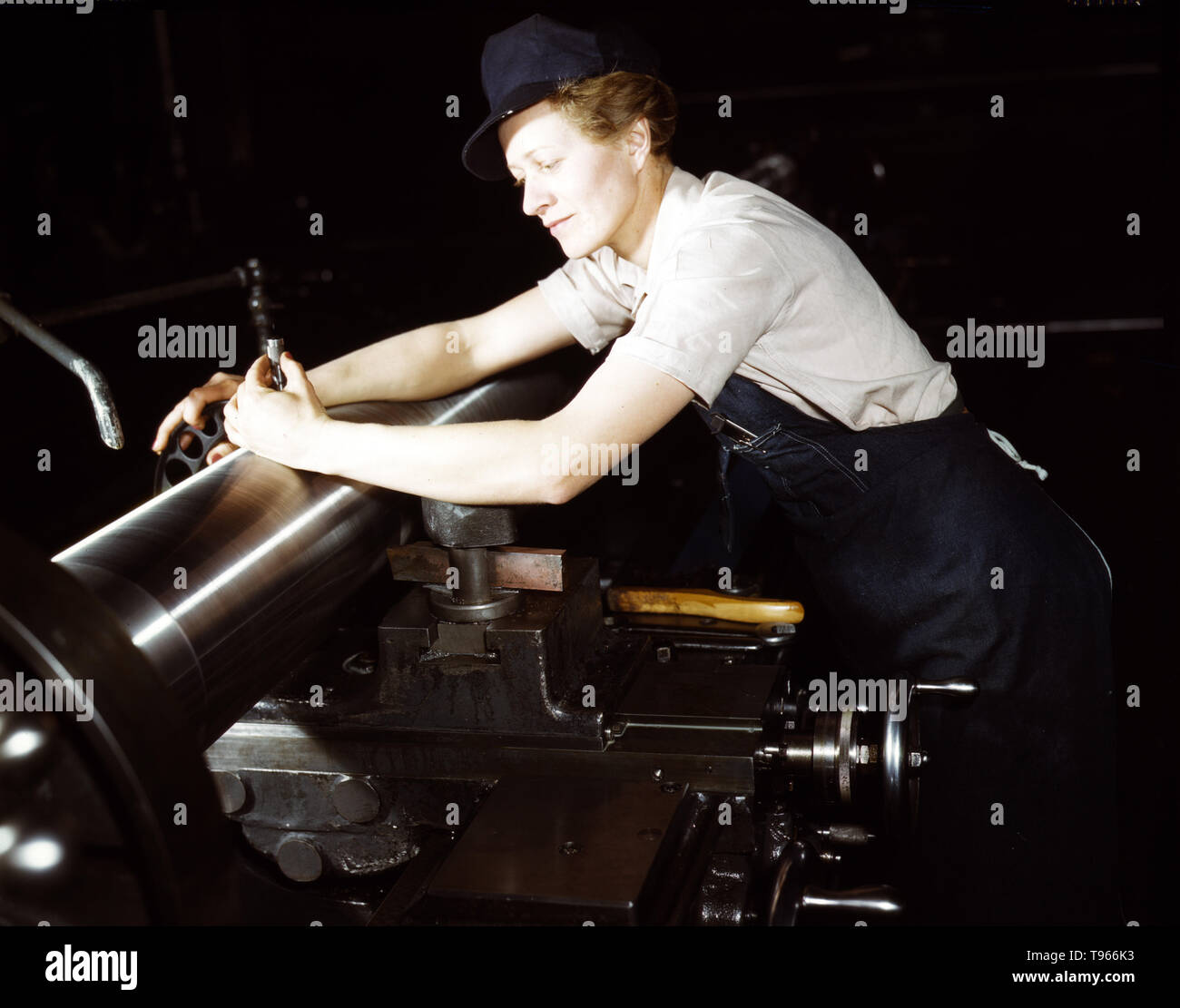 War production workers at the Vilter Manufacturing Company making M5 and M7 guns for the U.S. Army, Milwaukee, Wis. Ex-stage orchestra musician, checking an M7 gun with gage, after turning out on a gun lathe. Her two brothers and husband are in the service Although the image of 'Rosie the Riveter' reflected the industrial work of welders and riveters, the majority of working women filled non-factory positions in every sector of the economy. Photographed by Howard R. Hollem, 1943. Stock Photohttps://www.alamy.com/image-license-details/?v=1https://www.alamy.com/war-production-workers-at-the-vilter-manufacturing-company-making-m5-and-m7-guns-for-the-us-army-milwaukee-wis-ex-stage-orchestra-musician-checking-an-m7-gun-with-gage-after-turning-out-on-a-gun-lathe-her-two-brothers-and-husband-are-in-the-service-although-the-image-of-rosie-the-riveter-reflected-the-industrial-work-of-welders-and-riveters-the-majority-of-working-women-filled-non-factory-positions-in-every-sector-of-the-economy-photographed-by-howard-r-hollem-1943-image246614007.html
War production workers at the Vilter Manufacturing Company making M5 and M7 guns for the U.S. Army, Milwaukee, Wis. Ex-stage orchestra musician, checking an M7 gun with gage, after turning out on a gun lathe. Her two brothers and husband are in the service Although the image of 'Rosie the Riveter' reflected the industrial work of welders and riveters, the majority of working women filled non-factory positions in every sector of the economy. Photographed by Howard R. Hollem, 1943. Stock Photohttps://www.alamy.com/image-license-details/?v=1https://www.alamy.com/war-production-workers-at-the-vilter-manufacturing-company-making-m5-and-m7-guns-for-the-us-army-milwaukee-wis-ex-stage-orchestra-musician-checking-an-m7-gun-with-gage-after-turning-out-on-a-gun-lathe-her-two-brothers-and-husband-are-in-the-service-although-the-image-of-rosie-the-riveter-reflected-the-industrial-work-of-welders-and-riveters-the-majority-of-working-women-filled-non-factory-positions-in-every-sector-of-the-economy-photographed-by-howard-r-hollem-1943-image246614007.htmlRMT966K3–War production workers at the Vilter Manufacturing Company making M5 and M7 guns for the U.S. Army, Milwaukee, Wis. Ex-stage orchestra musician, checking an M7 gun with gage, after turning out on a gun lathe. Her two brothers and husband are in the service Although the image of 'Rosie the Riveter' reflected the industrial work of welders and riveters, the majority of working women filled non-factory positions in every sector of the economy. Photographed by Howard R. Hollem, 1943.
 Mrs. Doris Duke, who is 26 and a mother of one child, Corpus Christi, Texas. Mrs. Duke is a civil service worker in the Assembly and Repair Department at the Navy Air Base (shot - reconditioning spark plugs). Although the image of 'Rosie the Riveter' reflected the industrial work of welders and riveters, the majority of working women filled non-factory positions in every sector of the economy. What unified the experiences of these women was that they proved to themselves, and the country, that they could do a man's job and could do it well. Photographed by Howard R. Hollem, 1942. Stock Photohttps://www.alamy.com/image-license-details/?v=1https://www.alamy.com/mrs-doris-duke-who-is-26-and-a-mother-of-one-child-corpus-christi-texas-mrs-duke-is-a-civil-service-worker-in-the-assembly-and-repair-department-at-the-navy-air-base-shot-reconditioning-spark-plugs-although-the-image-of-rosie-the-riveter-reflected-the-industrial-work-of-welders-and-riveters-the-majority-of-working-women-filled-non-factory-positions-in-every-sector-of-the-economy-what-unified-the-experiences-of-these-women-was-that-they-proved-to-themselves-and-the-country-that-they-could-do-a-mans-job-and-could-do-it-well-photographed-by-howard-r-hollem-1942-image246614020.html
Mrs. Doris Duke, who is 26 and a mother of one child, Corpus Christi, Texas. Mrs. Duke is a civil service worker in the Assembly and Repair Department at the Navy Air Base (shot - reconditioning spark plugs). Although the image of 'Rosie the Riveter' reflected the industrial work of welders and riveters, the majority of working women filled non-factory positions in every sector of the economy. What unified the experiences of these women was that they proved to themselves, and the country, that they could do a man's job and could do it well. Photographed by Howard R. Hollem, 1942. Stock Photohttps://www.alamy.com/image-license-details/?v=1https://www.alamy.com/mrs-doris-duke-who-is-26-and-a-mother-of-one-child-corpus-christi-texas-mrs-duke-is-a-civil-service-worker-in-the-assembly-and-repair-department-at-the-navy-air-base-shot-reconditioning-spark-plugs-although-the-image-of-rosie-the-riveter-reflected-the-industrial-work-of-welders-and-riveters-the-majority-of-working-women-filled-non-factory-positions-in-every-sector-of-the-economy-what-unified-the-experiences-of-these-women-was-that-they-proved-to-themselves-and-the-country-that-they-could-do-a-mans-job-and-could-do-it-well-photographed-by-howard-r-hollem-1942-image246614020.htmlRMT966KG–Mrs. Doris Duke, who is 26 and a mother of one child, Corpus Christi, Texas. Mrs. Duke is a civil service worker in the Assembly and Repair Department at the Navy Air Base (shot - reconditioning spark plugs). Although the image of 'Rosie the Riveter' reflected the industrial work of welders and riveters, the majority of working women filled non-factory positions in every sector of the economy. What unified the experiences of these women was that they proved to themselves, and the country, that they could do a man's job and could do it well. Photographed by Howard R. Hollem, 1942.
 Phyllis Ann Marxson Clark, an 18 year old North Dakota native, in a glass house is putting finishing touches on the bombardier nose section of a B-17F navy bomber, Long Beach, Calif. She's one of many capable women workers in the Douglas Aircraft Company plant. Although the image of 'Rosie the Riveter' reflected the industrial work of welders and riveters, the majority of working women filled non-factory positions in every sector of the economy. . Photographed by Alfred T. Palmer, 1942. Stock Photohttps://www.alamy.com/image-license-details/?v=1https://www.alamy.com/phyllis-ann-marxson-clark-an-18-year-old-north-dakota-native-in-a-glass-house-is-putting-finishing-touches-on-the-bombardier-nose-section-of-a-b-17f-navy-bomber-long-beach-calif-shes-one-of-many-capable-women-workers-in-the-douglas-aircraft-company-plant-although-the-image-of-rosie-the-riveter-reflected-the-industrial-work-of-welders-and-riveters-the-majority-of-working-women-filled-non-factory-positions-in-every-sector-of-the-economy-photographed-by-alfred-t-palmer-1942-image246614029.html
Phyllis Ann Marxson Clark, an 18 year old North Dakota native, in a glass house is putting finishing touches on the bombardier nose section of a B-17F navy bomber, Long Beach, Calif. She's one of many capable women workers in the Douglas Aircraft Company plant. Although the image of 'Rosie the Riveter' reflected the industrial work of welders and riveters, the majority of working women filled non-factory positions in every sector of the economy. . Photographed by Alfred T. Palmer, 1942. Stock Photohttps://www.alamy.com/image-license-details/?v=1https://www.alamy.com/phyllis-ann-marxson-clark-an-18-year-old-north-dakota-native-in-a-glass-house-is-putting-finishing-touches-on-the-bombardier-nose-section-of-a-b-17f-navy-bomber-long-beach-calif-shes-one-of-many-capable-women-workers-in-the-douglas-aircraft-company-plant-although-the-image-of-rosie-the-riveter-reflected-the-industrial-work-of-welders-and-riveters-the-majority-of-working-women-filled-non-factory-positions-in-every-sector-of-the-economy-photographed-by-alfred-t-palmer-1942-image246614029.htmlRMT966KW–Phyllis Ann Marxson Clark, an 18 year old North Dakota native, in a glass house is putting finishing touches on the bombardier nose section of a B-17F navy bomber, Long Beach, Calif. She's one of many capable women workers in the Douglas Aircraft Company plant. Although the image of 'Rosie the Riveter' reflected the industrial work of welders and riveters, the majority of working women filled non-factory positions in every sector of the economy. . Photographed by Alfred T. Palmer, 1942.